Gender Pay Gaps within the top four UK Accounting Firms in the last 10 years
VerifiedAdded on 2023/04/20
|54
|13484
|115
AI Summary
This study evaluates the gender pay gap within the top four accounting firms in the UK over the past ten years. It examines the changes in pay gap and the impact on the workforce. Recommendations are provided to address the gender pay inequality.
Contribute Materials
Your contribution can guide someone’s learning journey. Share your
documents today.
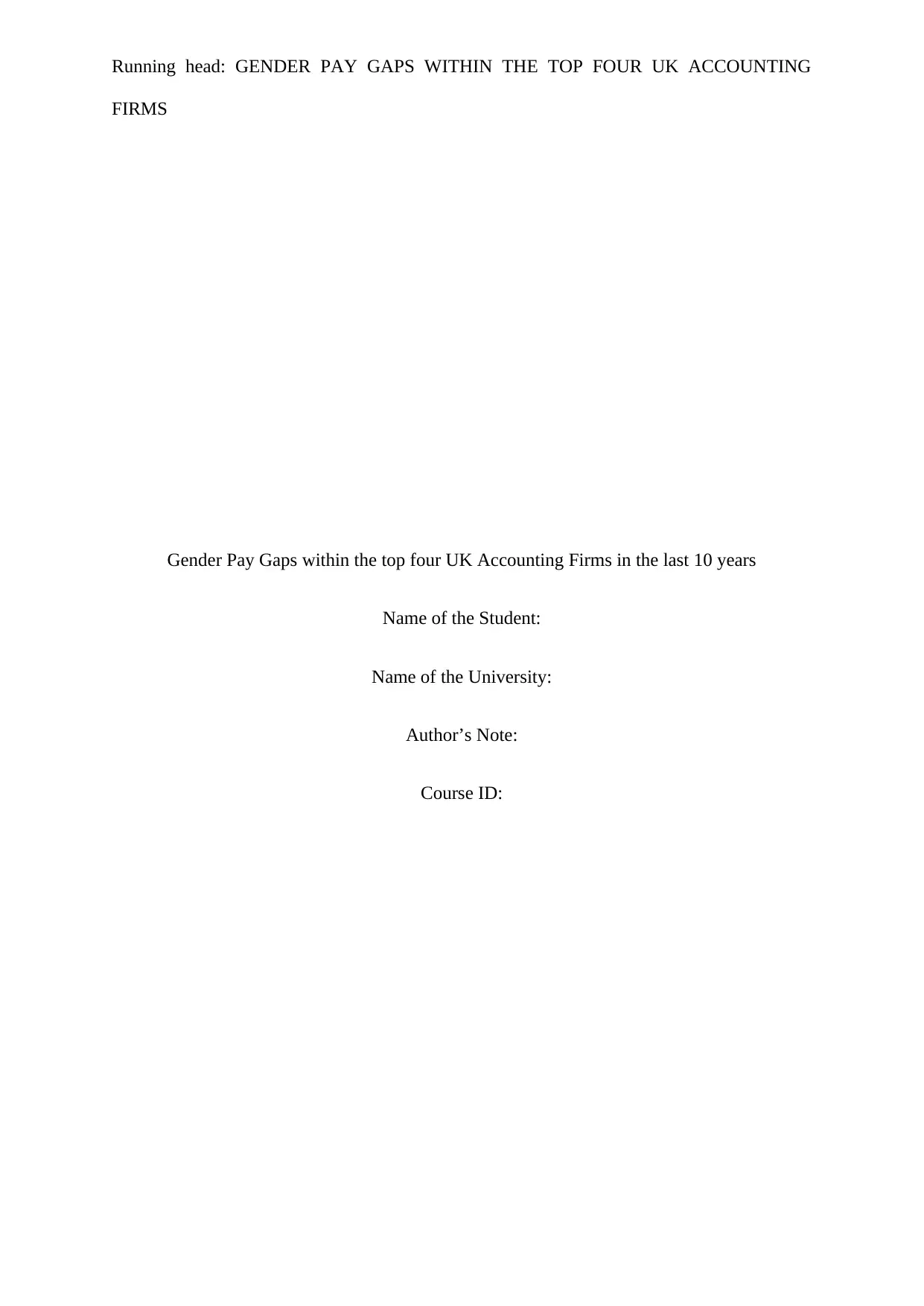
Running head: GENDER PAY GAPS WITHIN THE TOP FOUR UK ACCOUNTING
FIRMS
Gender Pay Gaps within the top four UK Accounting Firms in the last 10 years
Name of the Student:
Name of the University:
Author’s Note:
Course ID:
FIRMS
Gender Pay Gaps within the top four UK Accounting Firms in the last 10 years
Name of the Student:
Name of the University:
Author’s Note:
Course ID:
Secure Best Marks with AI Grader
Need help grading? Try our AI Grader for instant feedback on your assignments.
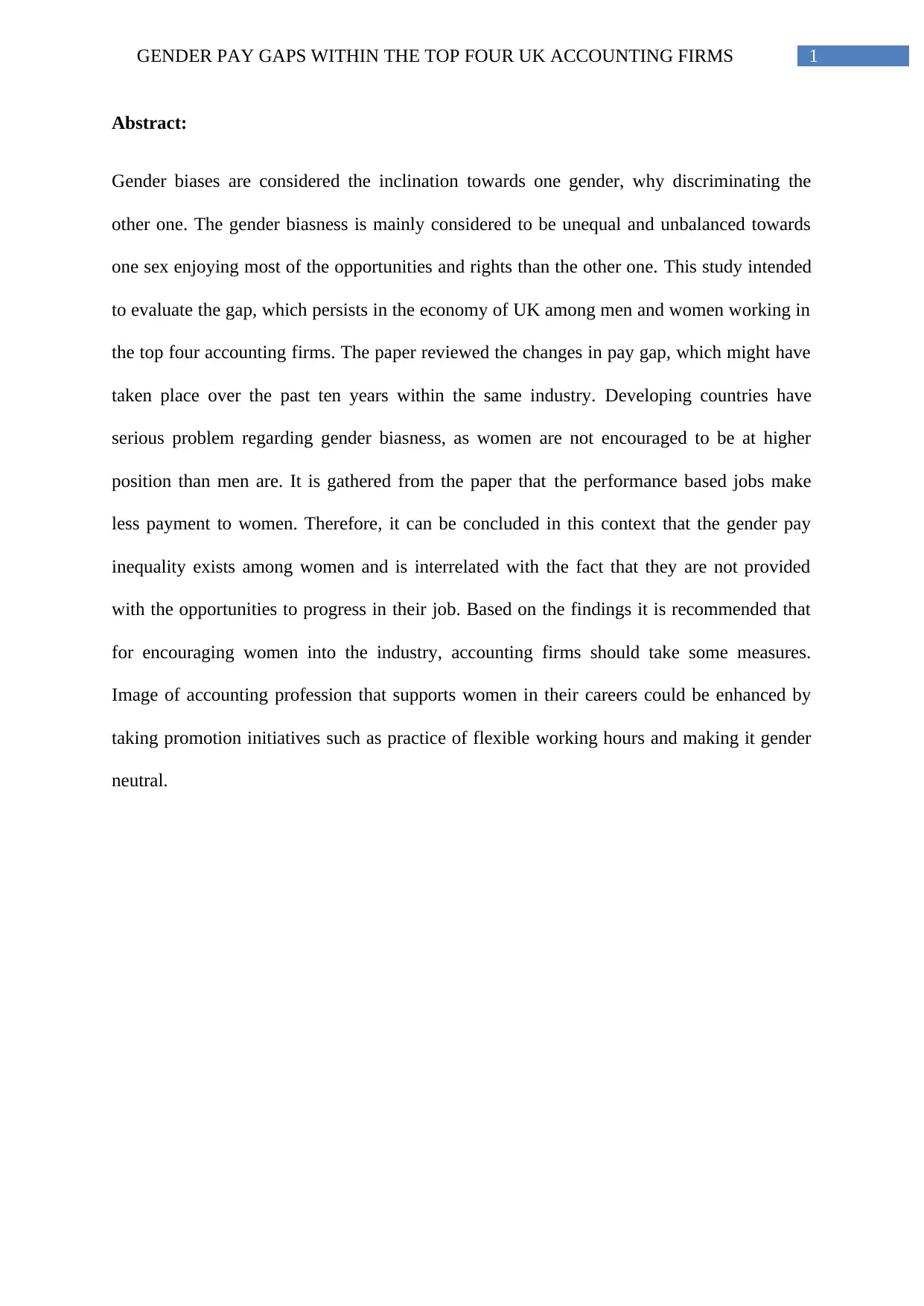
1GENDER PAY GAPS WITHIN THE TOP FOUR UK ACCOUNTING FIRMS
Abstract:
Gender biases are considered the inclination towards one gender, why discriminating the
other one. The gender biasness is mainly considered to be unequal and unbalanced towards
one sex enjoying most of the opportunities and rights than the other one. This study intended
to evaluate the gap, which persists in the economy of UK among men and women working in
the top four accounting firms. The paper reviewed the changes in pay gap, which might have
taken place over the past ten years within the same industry. Developing countries have
serious problem regarding gender biasness, as women are not encouraged to be at higher
position than men are. It is gathered from the paper that the performance based jobs make
less payment to women. Therefore, it can be concluded in this context that the gender pay
inequality exists among women and is interrelated with the fact that they are not provided
with the opportunities to progress in their job. Based on the findings it is recommended that
for encouraging women into the industry, accounting firms should take some measures.
Image of accounting profession that supports women in their careers could be enhanced by
taking promotion initiatives such as practice of flexible working hours and making it gender
neutral.
Abstract:
Gender biases are considered the inclination towards one gender, why discriminating the
other one. The gender biasness is mainly considered to be unequal and unbalanced towards
one sex enjoying most of the opportunities and rights than the other one. This study intended
to evaluate the gap, which persists in the economy of UK among men and women working in
the top four accounting firms. The paper reviewed the changes in pay gap, which might have
taken place over the past ten years within the same industry. Developing countries have
serious problem regarding gender biasness, as women are not encouraged to be at higher
position than men are. It is gathered from the paper that the performance based jobs make
less payment to women. Therefore, it can be concluded in this context that the gender pay
inequality exists among women and is interrelated with the fact that they are not provided
with the opportunities to progress in their job. Based on the findings it is recommended that
for encouraging women into the industry, accounting firms should take some measures.
Image of accounting profession that supports women in their careers could be enhanced by
taking promotion initiatives such as practice of flexible working hours and making it gender
neutral.
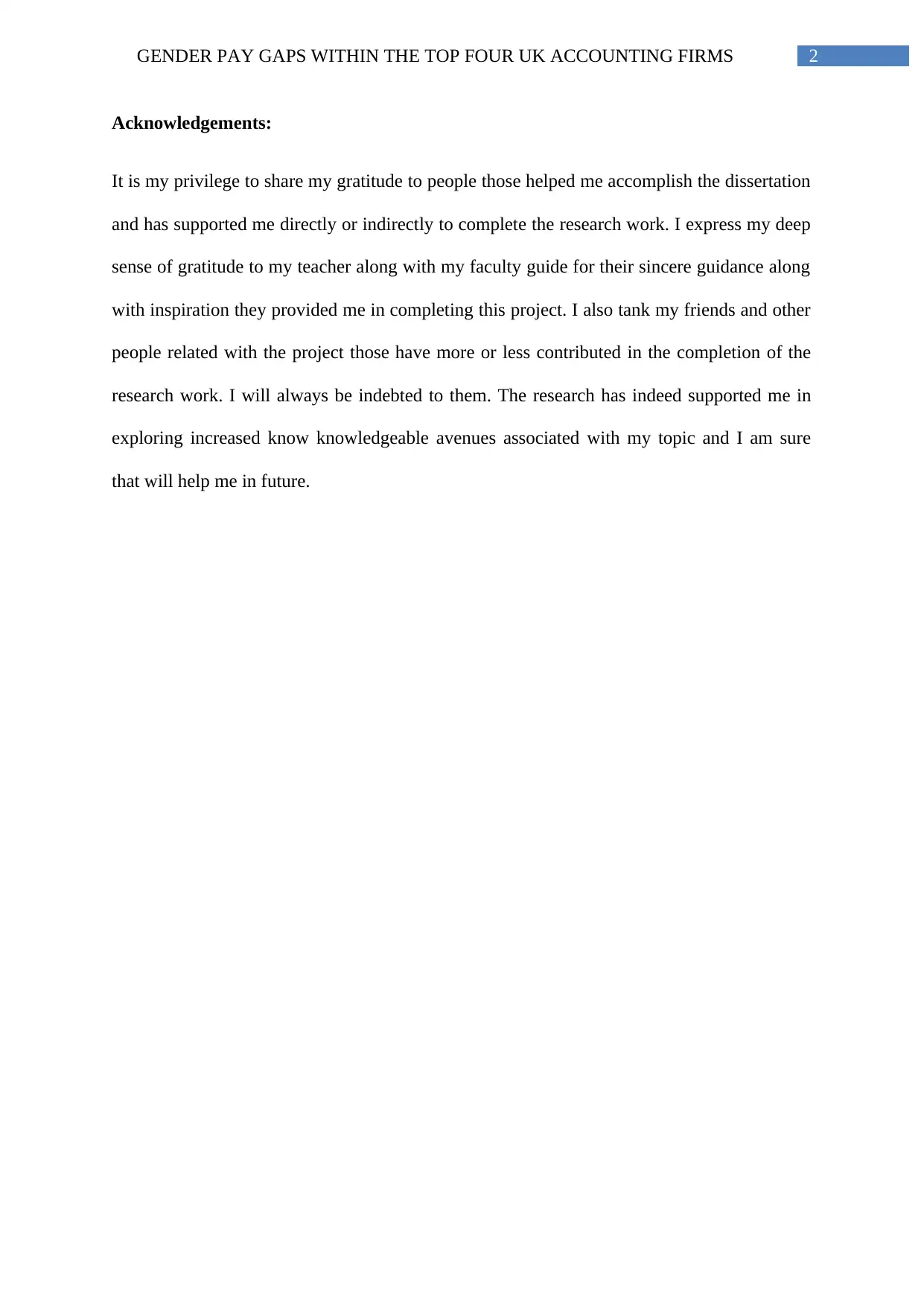
2GENDER PAY GAPS WITHIN THE TOP FOUR UK ACCOUNTING FIRMS
Acknowledgements:
It is my privilege to share my gratitude to people those helped me accomplish the dissertation
and has supported me directly or indirectly to complete the research work. I express my deep
sense of gratitude to my teacher along with my faculty guide for their sincere guidance along
with inspiration they provided me in completing this project. I also tank my friends and other
people related with the project those have more or less contributed in the completion of the
research work. I will always be indebted to them. The research has indeed supported me in
exploring increased know knowledgeable avenues associated with my topic and I am sure
that will help me in future.
Acknowledgements:
It is my privilege to share my gratitude to people those helped me accomplish the dissertation
and has supported me directly or indirectly to complete the research work. I express my deep
sense of gratitude to my teacher along with my faculty guide for their sincere guidance along
with inspiration they provided me in completing this project. I also tank my friends and other
people related with the project those have more or less contributed in the completion of the
research work. I will always be indebted to them. The research has indeed supported me in
exploring increased know knowledgeable avenues associated with my topic and I am sure
that will help me in future.
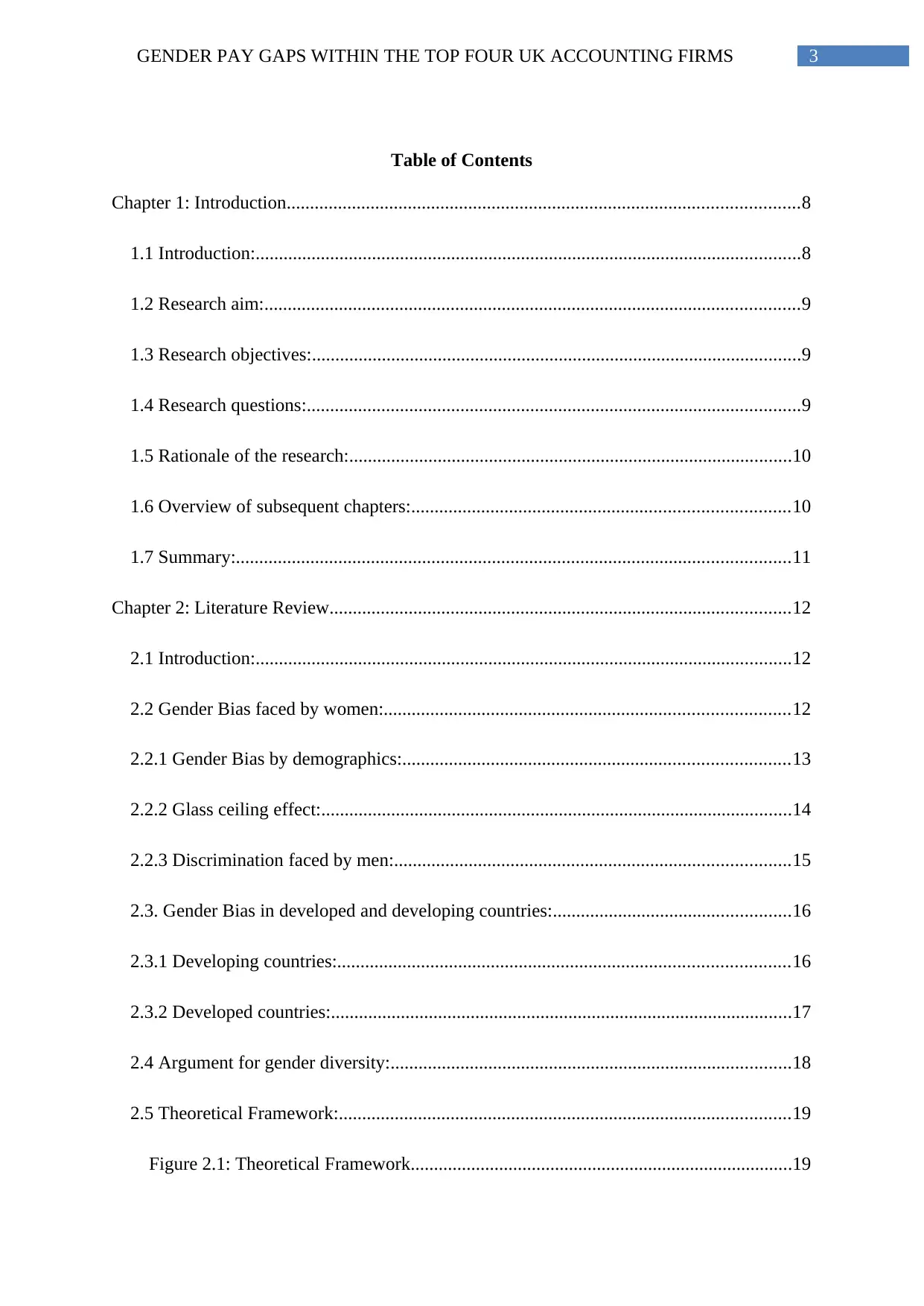
3GENDER PAY GAPS WITHIN THE TOP FOUR UK ACCOUNTING FIRMS
Table of Contents
Chapter 1: Introduction..............................................................................................................8
1.1 Introduction:.....................................................................................................................8
1.2 Research aim:...................................................................................................................9
1.3 Research objectives:.........................................................................................................9
1.4 Research questions:..........................................................................................................9
1.5 Rationale of the research:...............................................................................................10
1.6 Overview of subsequent chapters:.................................................................................10
1.7 Summary:.......................................................................................................................11
Chapter 2: Literature Review...................................................................................................12
2.1 Introduction:...................................................................................................................12
2.2 Gender Bias faced by women:.......................................................................................12
2.2.1 Gender Bias by demographics:...................................................................................13
2.2.2 Glass ceiling effect:.....................................................................................................14
2.2.3 Discrimination faced by men:.....................................................................................15
2.3. Gender Bias in developed and developing countries:...................................................16
2.3.1 Developing countries:.................................................................................................16
2.3.2 Developed countries:...................................................................................................17
2.4 Argument for gender diversity:......................................................................................18
2.5 Theoretical Framework:.................................................................................................19
Figure 2.1: Theoretical Framework..................................................................................19
Table of Contents
Chapter 1: Introduction..............................................................................................................8
1.1 Introduction:.....................................................................................................................8
1.2 Research aim:...................................................................................................................9
1.3 Research objectives:.........................................................................................................9
1.4 Research questions:..........................................................................................................9
1.5 Rationale of the research:...............................................................................................10
1.6 Overview of subsequent chapters:.................................................................................10
1.7 Summary:.......................................................................................................................11
Chapter 2: Literature Review...................................................................................................12
2.1 Introduction:...................................................................................................................12
2.2 Gender Bias faced by women:.......................................................................................12
2.2.1 Gender Bias by demographics:...................................................................................13
2.2.2 Glass ceiling effect:.....................................................................................................14
2.2.3 Discrimination faced by men:.....................................................................................15
2.3. Gender Bias in developed and developing countries:...................................................16
2.3.1 Developing countries:.................................................................................................16
2.3.2 Developed countries:...................................................................................................17
2.4 Argument for gender diversity:......................................................................................18
2.5 Theoretical Framework:.................................................................................................19
Figure 2.1: Theoretical Framework..................................................................................19
Secure Best Marks with AI Grader
Need help grading? Try our AI Grader for instant feedback on your assignments.
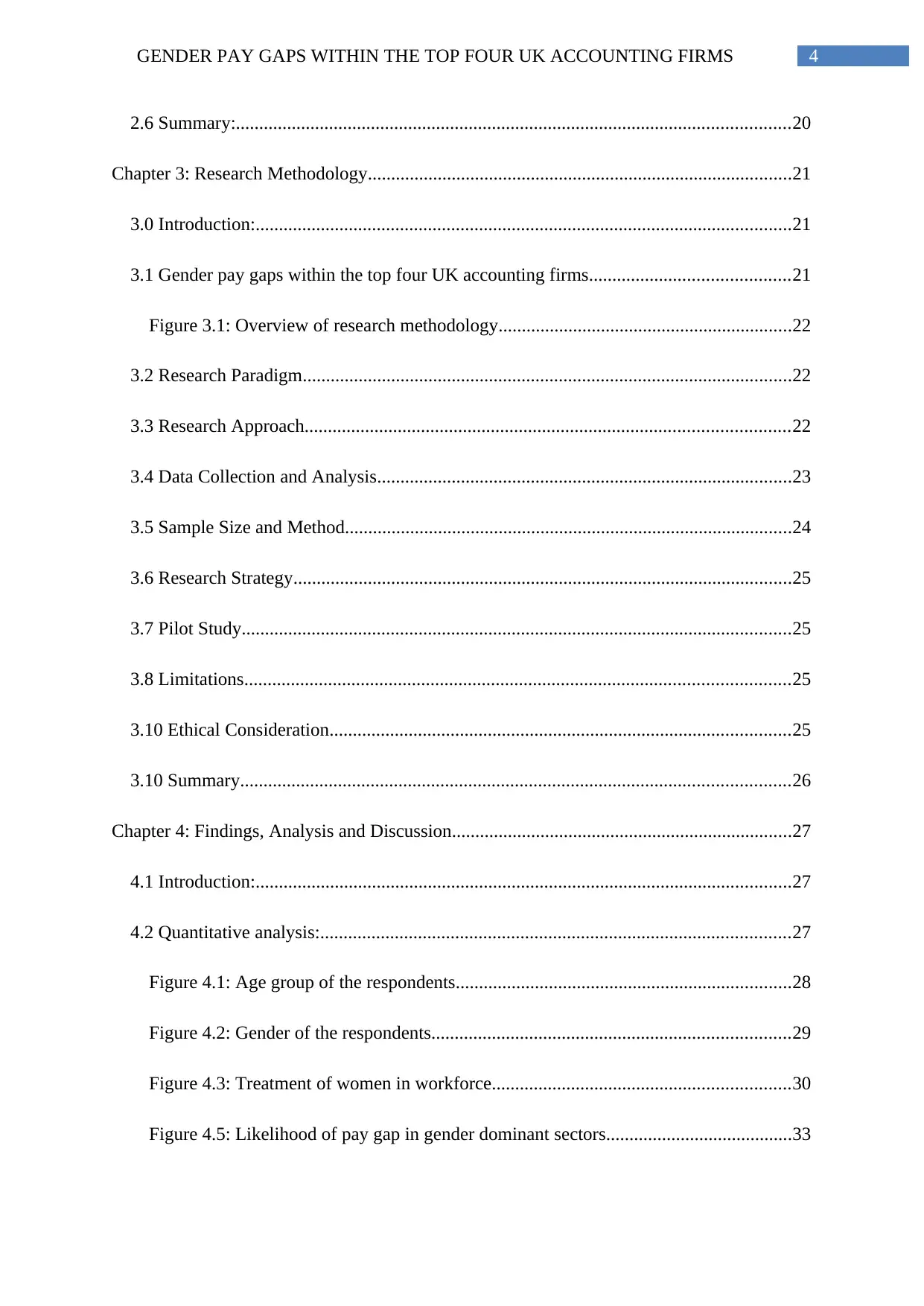
4GENDER PAY GAPS WITHIN THE TOP FOUR UK ACCOUNTING FIRMS
2.6 Summary:.......................................................................................................................20
Chapter 3: Research Methodology...........................................................................................21
3.0 Introduction:...................................................................................................................21
3.1 Gender pay gaps within the top four UK accounting firms...........................................21
Figure 3.1: Overview of research methodology...............................................................22
3.2 Research Paradigm.........................................................................................................22
3.3 Research Approach........................................................................................................22
3.4 Data Collection and Analysis.........................................................................................23
3.5 Sample Size and Method................................................................................................24
3.6 Research Strategy...........................................................................................................25
3.7 Pilot Study......................................................................................................................25
3.8 Limitations.....................................................................................................................25
3.10 Ethical Consideration...................................................................................................25
3.10 Summary......................................................................................................................26
Chapter 4: Findings, Analysis and Discussion.........................................................................27
4.1 Introduction:...................................................................................................................27
4.2 Quantitative analysis:.....................................................................................................27
Figure 4.1: Age group of the respondents........................................................................28
Figure 4.2: Gender of the respondents.............................................................................29
Figure 4.3: Treatment of women in workforce................................................................30
Figure 4.5: Likelihood of pay gap in gender dominant sectors........................................33
2.6 Summary:.......................................................................................................................20
Chapter 3: Research Methodology...........................................................................................21
3.0 Introduction:...................................................................................................................21
3.1 Gender pay gaps within the top four UK accounting firms...........................................21
Figure 3.1: Overview of research methodology...............................................................22
3.2 Research Paradigm.........................................................................................................22
3.3 Research Approach........................................................................................................22
3.4 Data Collection and Analysis.........................................................................................23
3.5 Sample Size and Method................................................................................................24
3.6 Research Strategy...........................................................................................................25
3.7 Pilot Study......................................................................................................................25
3.8 Limitations.....................................................................................................................25
3.10 Ethical Consideration...................................................................................................25
3.10 Summary......................................................................................................................26
Chapter 4: Findings, Analysis and Discussion.........................................................................27
4.1 Introduction:...................................................................................................................27
4.2 Quantitative analysis:.....................................................................................................27
Figure 4.1: Age group of the respondents........................................................................28
Figure 4.2: Gender of the respondents.............................................................................29
Figure 4.3: Treatment of women in workforce................................................................30
Figure 4.5: Likelihood of pay gap in gender dominant sectors........................................33
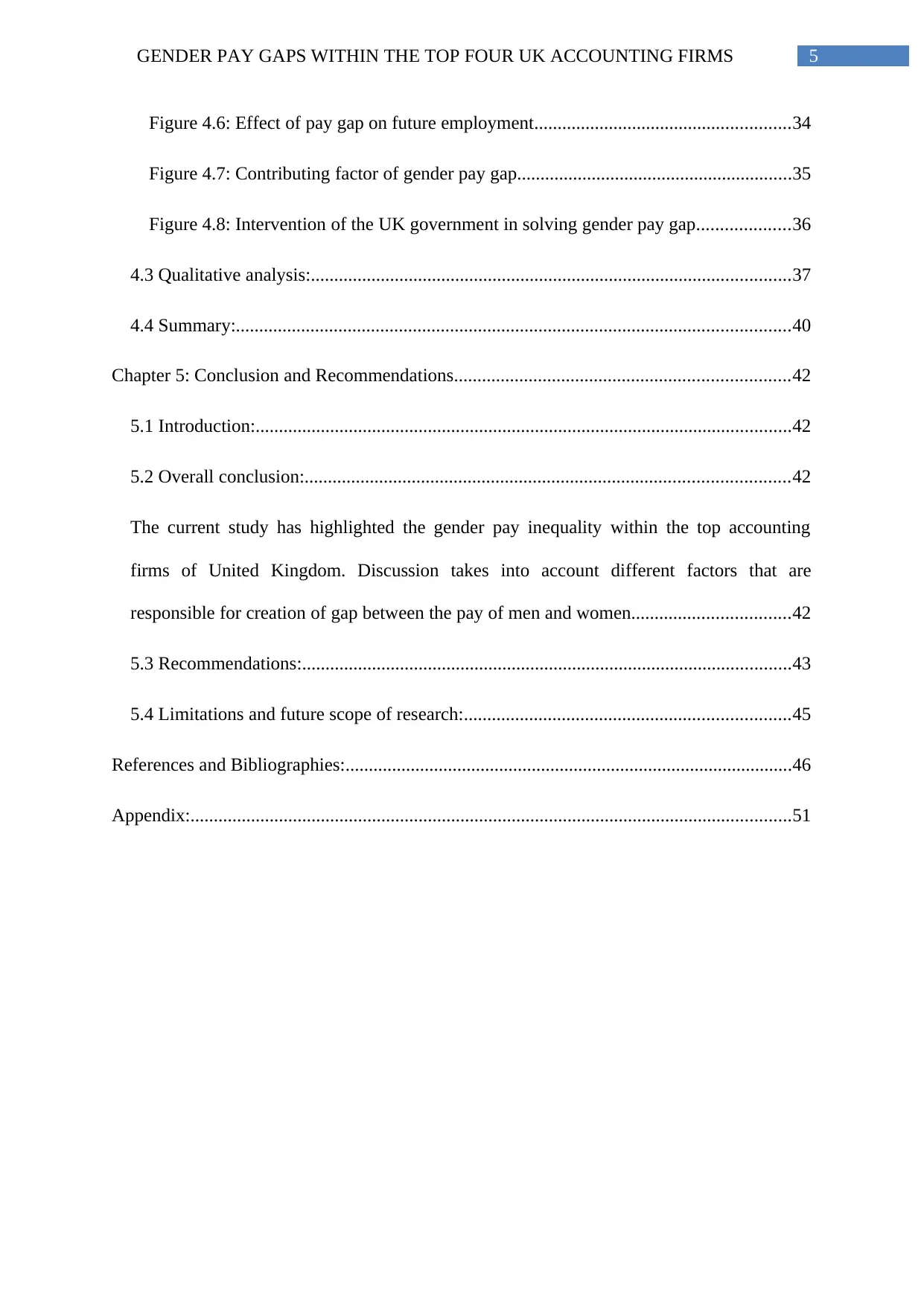
5GENDER PAY GAPS WITHIN THE TOP FOUR UK ACCOUNTING FIRMS
Figure 4.6: Effect of pay gap on future employment.......................................................34
Figure 4.7: Contributing factor of gender pay gap...........................................................35
Figure 4.8: Intervention of the UK government in solving gender pay gap....................36
4.3 Qualitative analysis:.......................................................................................................37
4.4 Summary:.......................................................................................................................40
Chapter 5: Conclusion and Recommendations........................................................................42
5.1 Introduction:...................................................................................................................42
5.2 Overall conclusion:........................................................................................................42
The current study has highlighted the gender pay inequality within the top accounting
firms of United Kingdom. Discussion takes into account different factors that are
responsible for creation of gap between the pay of men and women..................................42
5.3 Recommendations:.........................................................................................................43
5.4 Limitations and future scope of research:......................................................................45
References and Bibliographies:................................................................................................46
Appendix:.................................................................................................................................51
Figure 4.6: Effect of pay gap on future employment.......................................................34
Figure 4.7: Contributing factor of gender pay gap...........................................................35
Figure 4.8: Intervention of the UK government in solving gender pay gap....................36
4.3 Qualitative analysis:.......................................................................................................37
4.4 Summary:.......................................................................................................................40
Chapter 5: Conclusion and Recommendations........................................................................42
5.1 Introduction:...................................................................................................................42
5.2 Overall conclusion:........................................................................................................42
The current study has highlighted the gender pay inequality within the top accounting
firms of United Kingdom. Discussion takes into account different factors that are
responsible for creation of gap between the pay of men and women..................................42
5.3 Recommendations:.........................................................................................................43
5.4 Limitations and future scope of research:......................................................................45
References and Bibliographies:................................................................................................46
Appendix:.................................................................................................................................51

6GENDER PAY GAPS WITHIN THE TOP FOUR UK ACCOUNTING FIRMS
Table of Figures
Figure 2.1: Theoretical Framework..........................................................................................18
Figure 3.1: Overview of research methodology.......................................................................21
Figure 4.1: Age group of the respondents................................................................................27
Figure 4.2: Gender of the respondents.....................................................................................28
Figure 4.3: Treatment of women in workforce........................................................................29
Figure 4.5: Likelihood of pay gap in gender dominant sectors................................................32
Figure 4.6: Effect of pay gap on future employment...............................................................33
Figure 4.7: Contributing factor of gender pay gap...................................................................34
Figure 4.8: Intervention of the UK government in solving gender pay gap............................35
Table of Figures
Figure 2.1: Theoretical Framework..........................................................................................18
Figure 3.1: Overview of research methodology.......................................................................21
Figure 4.1: Age group of the respondents................................................................................27
Figure 4.2: Gender of the respondents.....................................................................................28
Figure 4.3: Treatment of women in workforce........................................................................29
Figure 4.5: Likelihood of pay gap in gender dominant sectors................................................32
Figure 4.6: Effect of pay gap on future employment...............................................................33
Figure 4.7: Contributing factor of gender pay gap...................................................................34
Figure 4.8: Intervention of the UK government in solving gender pay gap............................35
Paraphrase This Document
Need a fresh take? Get an instant paraphrase of this document with our AI Paraphraser
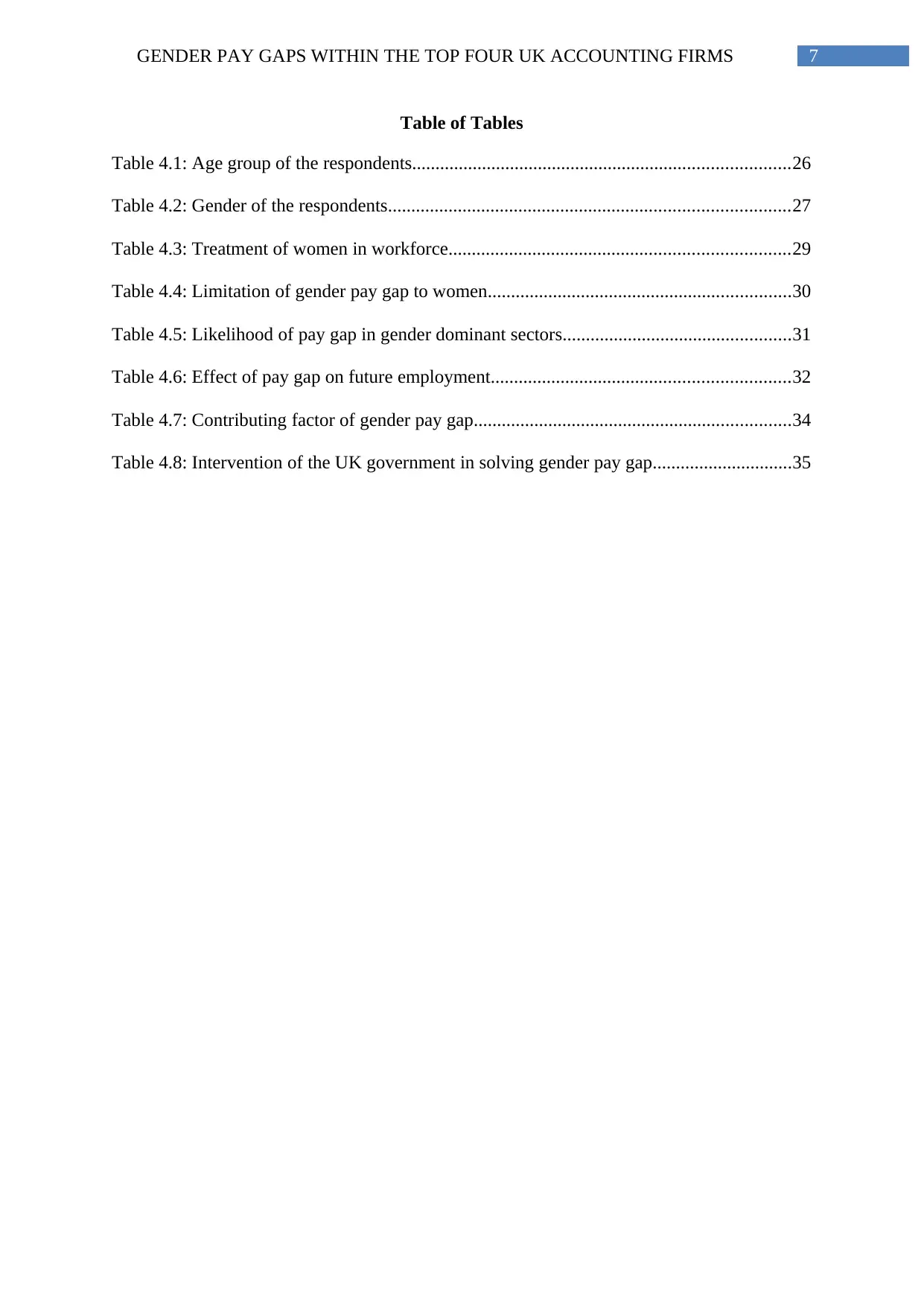
7GENDER PAY GAPS WITHIN THE TOP FOUR UK ACCOUNTING FIRMS
Table of Tables
Table 4.1: Age group of the respondents.................................................................................26
Table 4.2: Gender of the respondents......................................................................................27
Table 4.3: Treatment of women in workforce.........................................................................29
Table 4.4: Limitation of gender pay gap to women.................................................................30
Table 4.5: Likelihood of pay gap in gender dominant sectors.................................................31
Table 4.6: Effect of pay gap on future employment................................................................32
Table 4.7: Contributing factor of gender pay gap....................................................................34
Table 4.8: Intervention of the UK government in solving gender pay gap..............................35
Table of Tables
Table 4.1: Age group of the respondents.................................................................................26
Table 4.2: Gender of the respondents......................................................................................27
Table 4.3: Treatment of women in workforce.........................................................................29
Table 4.4: Limitation of gender pay gap to women.................................................................30
Table 4.5: Likelihood of pay gap in gender dominant sectors.................................................31
Table 4.6: Effect of pay gap on future employment................................................................32
Table 4.7: Contributing factor of gender pay gap....................................................................34
Table 4.8: Intervention of the UK government in solving gender pay gap..............................35
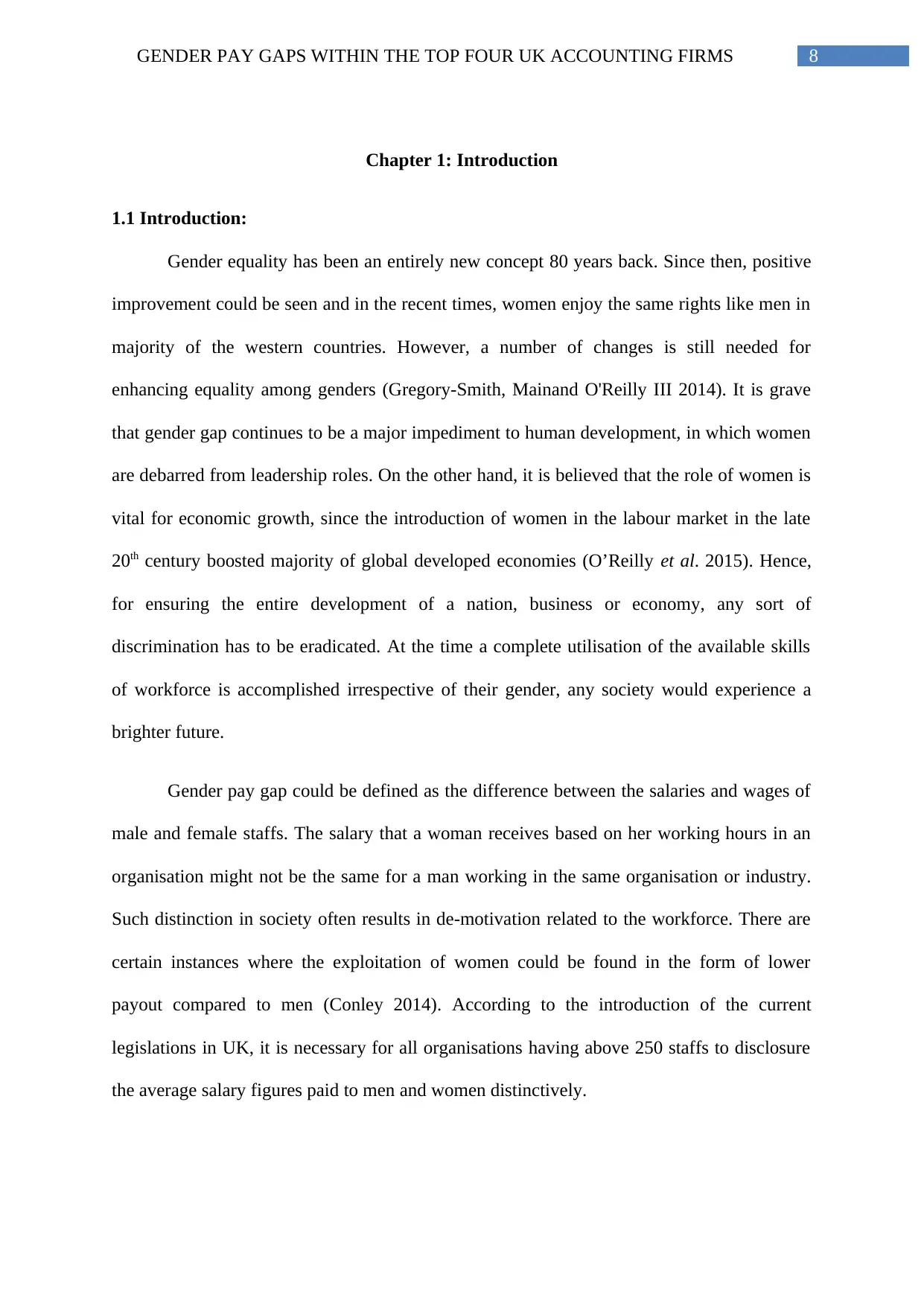
8GENDER PAY GAPS WITHIN THE TOP FOUR UK ACCOUNTING FIRMS
Chapter 1: Introduction
1.1 Introduction:
Gender equality has been an entirely new concept 80 years back. Since then, positive
improvement could be seen and in the recent times, women enjoy the same rights like men in
majority of the western countries. However, a number of changes is still needed for
enhancing equality among genders (Gregory‐Smith, Mainand O'Reilly III 2014). It is grave
that gender gap continues to be a major impediment to human development, in which women
are debarred from leadership roles. On the other hand, it is believed that the role of women is
vital for economic growth, since the introduction of women in the labour market in the late
20th century boosted majority of global developed economies (O’Reilly et al. 2015). Hence,
for ensuring the entire development of a nation, business or economy, any sort of
discrimination has to be eradicated. At the time a complete utilisation of the available skills
of workforce is accomplished irrespective of their gender, any society would experience a
brighter future.
Gender pay gap could be defined as the difference between the salaries and wages of
male and female staffs. The salary that a woman receives based on her working hours in an
organisation might not be the same for a man working in the same organisation or industry.
Such distinction in society often results in de-motivation related to the workforce. There are
certain instances where the exploitation of women could be found in the form of lower
payout compared to men (Conley 2014). According to the introduction of the current
legislations in UK, it is necessary for all organisations having above 250 staffs to disclosure
the average salary figures paid to men and women distinctively.
Chapter 1: Introduction
1.1 Introduction:
Gender equality has been an entirely new concept 80 years back. Since then, positive
improvement could be seen and in the recent times, women enjoy the same rights like men in
majority of the western countries. However, a number of changes is still needed for
enhancing equality among genders (Gregory‐Smith, Mainand O'Reilly III 2014). It is grave
that gender gap continues to be a major impediment to human development, in which women
are debarred from leadership roles. On the other hand, it is believed that the role of women is
vital for economic growth, since the introduction of women in the labour market in the late
20th century boosted majority of global developed economies (O’Reilly et al. 2015). Hence,
for ensuring the entire development of a nation, business or economy, any sort of
discrimination has to be eradicated. At the time a complete utilisation of the available skills
of workforce is accomplished irrespective of their gender, any society would experience a
brighter future.
Gender pay gap could be defined as the difference between the salaries and wages of
male and female staffs. The salary that a woman receives based on her working hours in an
organisation might not be the same for a man working in the same organisation or industry.
Such distinction in society often results in de-motivation related to the workforce. There are
certain instances where the exploitation of women could be found in the form of lower
payout compared to men (Conley 2014). According to the introduction of the current
legislations in UK, it is necessary for all organisations having above 250 staffs to disclosure
the average salary figures paid to men and women distinctively.
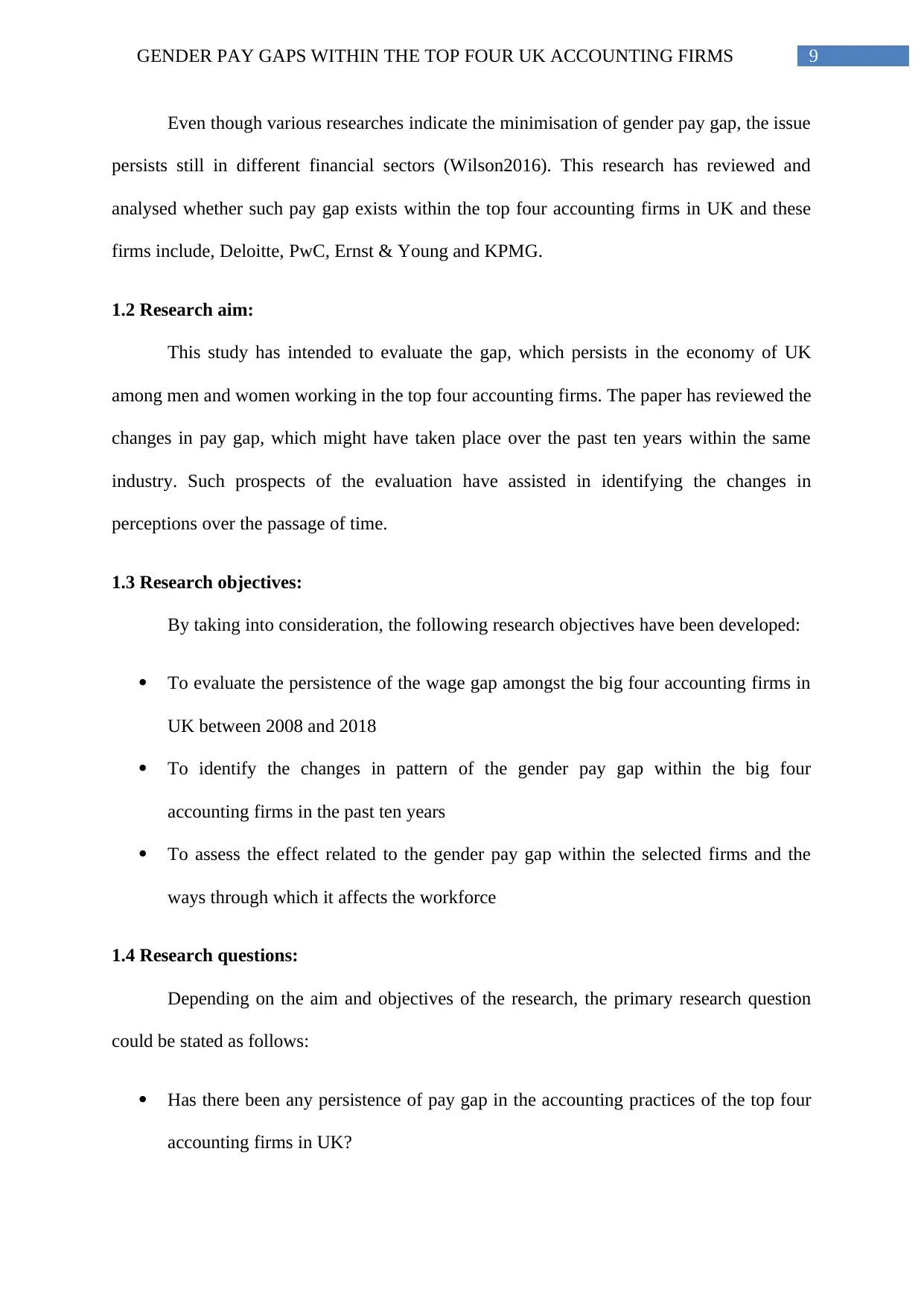
9GENDER PAY GAPS WITHIN THE TOP FOUR UK ACCOUNTING FIRMS
Even though various researches indicate the minimisation of gender pay gap, the issue
persists still in different financial sectors (Wilson2016). This research has reviewed and
analysed whether such pay gap exists within the top four accounting firms in UK and these
firms include, Deloitte, PwC, Ernst & Young and KPMG.
1.2 Research aim:
This study has intended to evaluate the gap, which persists in the economy of UK
among men and women working in the top four accounting firms. The paper has reviewed the
changes in pay gap, which might have taken place over the past ten years within the same
industry. Such prospects of the evaluation have assisted in identifying the changes in
perceptions over the passage of time.
1.3 Research objectives:
By taking into consideration, the following research objectives have been developed:
To evaluate the persistence of the wage gap amongst the big four accounting firms in
UK between 2008 and 2018
To identify the changes in pattern of the gender pay gap within the big four
accounting firms in the past ten years
To assess the effect related to the gender pay gap within the selected firms and the
ways through which it affects the workforce
1.4 Research questions:
Depending on the aim and objectives of the research, the primary research question
could be stated as follows:
Has there been any persistence of pay gap in the accounting practices of the top four
accounting firms in UK?
Even though various researches indicate the minimisation of gender pay gap, the issue
persists still in different financial sectors (Wilson2016). This research has reviewed and
analysed whether such pay gap exists within the top four accounting firms in UK and these
firms include, Deloitte, PwC, Ernst & Young and KPMG.
1.2 Research aim:
This study has intended to evaluate the gap, which persists in the economy of UK
among men and women working in the top four accounting firms. The paper has reviewed the
changes in pay gap, which might have taken place over the past ten years within the same
industry. Such prospects of the evaluation have assisted in identifying the changes in
perceptions over the passage of time.
1.3 Research objectives:
By taking into consideration, the following research objectives have been developed:
To evaluate the persistence of the wage gap amongst the big four accounting firms in
UK between 2008 and 2018
To identify the changes in pattern of the gender pay gap within the big four
accounting firms in the past ten years
To assess the effect related to the gender pay gap within the selected firms and the
ways through which it affects the workforce
1.4 Research questions:
Depending on the aim and objectives of the research, the primary research question
could be stated as follows:
Has there been any persistence of pay gap in the accounting practices of the top four
accounting firms in UK?
Secure Best Marks with AI Grader
Need help grading? Try our AI Grader for instant feedback on your assignments.
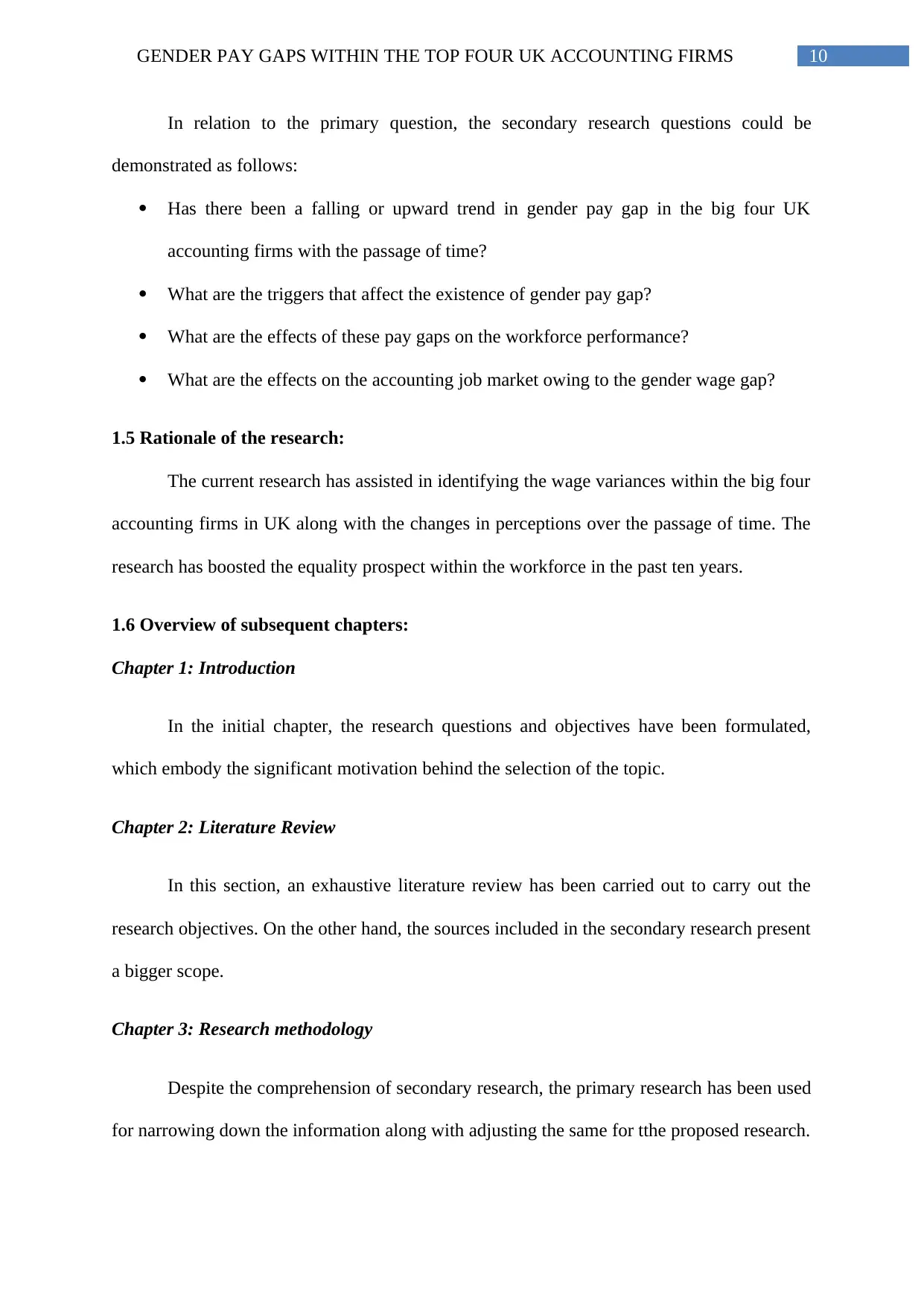
10GENDER PAY GAPS WITHIN THE TOP FOUR UK ACCOUNTING FIRMS
In relation to the primary question, the secondary research questions could be
demonstrated as follows:
Has there been a falling or upward trend in gender pay gap in the big four UK
accounting firms with the passage of time?
What are the triggers that affect the existence of gender pay gap?
What are the effects of these pay gaps on the workforce performance?
What are the effects on the accounting job market owing to the gender wage gap?
1.5 Rationale of the research:
The current research has assisted in identifying the wage variances within the big four
accounting firms in UK along with the changes in perceptions over the passage of time. The
research has boosted the equality prospect within the workforce in the past ten years.
1.6 Overview of subsequent chapters:
Chapter 1: Introduction
In the initial chapter, the research questions and objectives have been formulated,
which embody the significant motivation behind the selection of the topic.
Chapter 2: Literature Review
In this section, an exhaustive literature review has been carried out to carry out the
research objectives. On the other hand, the sources included in the secondary research present
a bigger scope.
Chapter 3: Research methodology
Despite the comprehension of secondary research, the primary research has been used
for narrowing down the information along with adjusting the same for tthe proposed research.
In relation to the primary question, the secondary research questions could be
demonstrated as follows:
Has there been a falling or upward trend in gender pay gap in the big four UK
accounting firms with the passage of time?
What are the triggers that affect the existence of gender pay gap?
What are the effects of these pay gaps on the workforce performance?
What are the effects on the accounting job market owing to the gender wage gap?
1.5 Rationale of the research:
The current research has assisted in identifying the wage variances within the big four
accounting firms in UK along with the changes in perceptions over the passage of time. The
research has boosted the equality prospect within the workforce in the past ten years.
1.6 Overview of subsequent chapters:
Chapter 1: Introduction
In the initial chapter, the research questions and objectives have been formulated,
which embody the significant motivation behind the selection of the topic.
Chapter 2: Literature Review
In this section, an exhaustive literature review has been carried out to carry out the
research objectives. On the other hand, the sources included in the secondary research present
a bigger scope.
Chapter 3: Research methodology
Despite the comprehension of secondary research, the primary research has been used
for narrowing down the information along with adjusting the same for tthe proposed research.
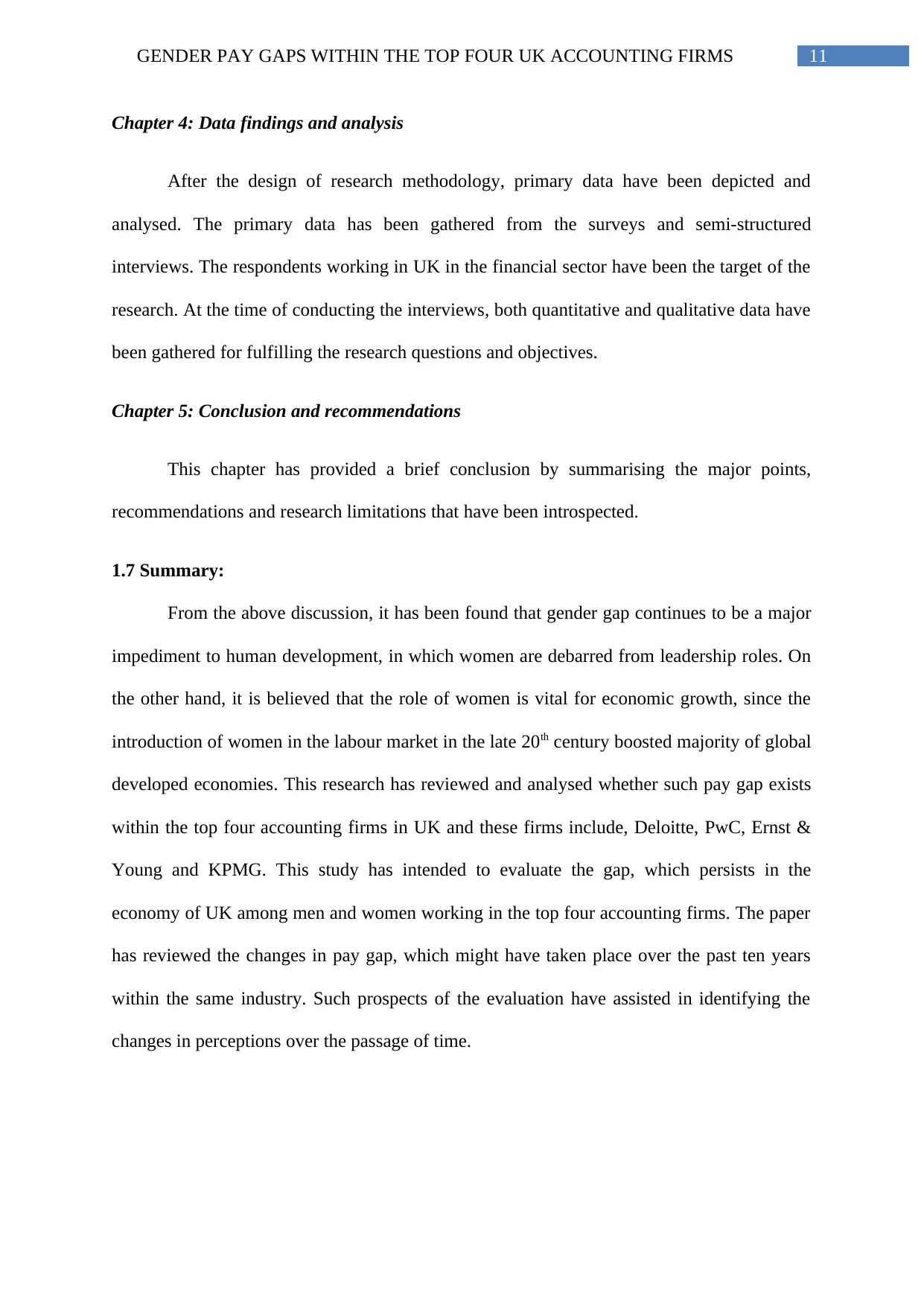
11GENDER PAY GAPS WITHIN THE TOP FOUR UK ACCOUNTING FIRMS
Chapter 4: Data findings and analysis
After the design of research methodology, primary data have been depicted and
analysed. The primary data has been gathered from the surveys and semi-structured
interviews. The respondents working in UK in the financial sector have been the target of the
research. At the time of conducting the interviews, both quantitative and qualitative data have
been gathered for fulfilling the research questions and objectives.
Chapter 5: Conclusion and recommendations
This chapter has provided a brief conclusion by summarising the major points,
recommendations and research limitations that have been introspected.
1.7 Summary:
From the above discussion, it has been found that gender gap continues to be a major
impediment to human development, in which women are debarred from leadership roles. On
the other hand, it is believed that the role of women is vital for economic growth, since the
introduction of women in the labour market in the late 20th century boosted majority of global
developed economies. This research has reviewed and analysed whether such pay gap exists
within the top four accounting firms in UK and these firms include, Deloitte, PwC, Ernst &
Young and KPMG. This study has intended to evaluate the gap, which persists in the
economy of UK among men and women working in the top four accounting firms. The paper
has reviewed the changes in pay gap, which might have taken place over the past ten years
within the same industry. Such prospects of the evaluation have assisted in identifying the
changes in perceptions over the passage of time.
Chapter 4: Data findings and analysis
After the design of research methodology, primary data have been depicted and
analysed. The primary data has been gathered from the surveys and semi-structured
interviews. The respondents working in UK in the financial sector have been the target of the
research. At the time of conducting the interviews, both quantitative and qualitative data have
been gathered for fulfilling the research questions and objectives.
Chapter 5: Conclusion and recommendations
This chapter has provided a brief conclusion by summarising the major points,
recommendations and research limitations that have been introspected.
1.7 Summary:
From the above discussion, it has been found that gender gap continues to be a major
impediment to human development, in which women are debarred from leadership roles. On
the other hand, it is believed that the role of women is vital for economic growth, since the
introduction of women in the labour market in the late 20th century boosted majority of global
developed economies. This research has reviewed and analysed whether such pay gap exists
within the top four accounting firms in UK and these firms include, Deloitte, PwC, Ernst &
Young and KPMG. This study has intended to evaluate the gap, which persists in the
economy of UK among men and women working in the top four accounting firms. The paper
has reviewed the changes in pay gap, which might have taken place over the past ten years
within the same industry. Such prospects of the evaluation have assisted in identifying the
changes in perceptions over the passage of time.
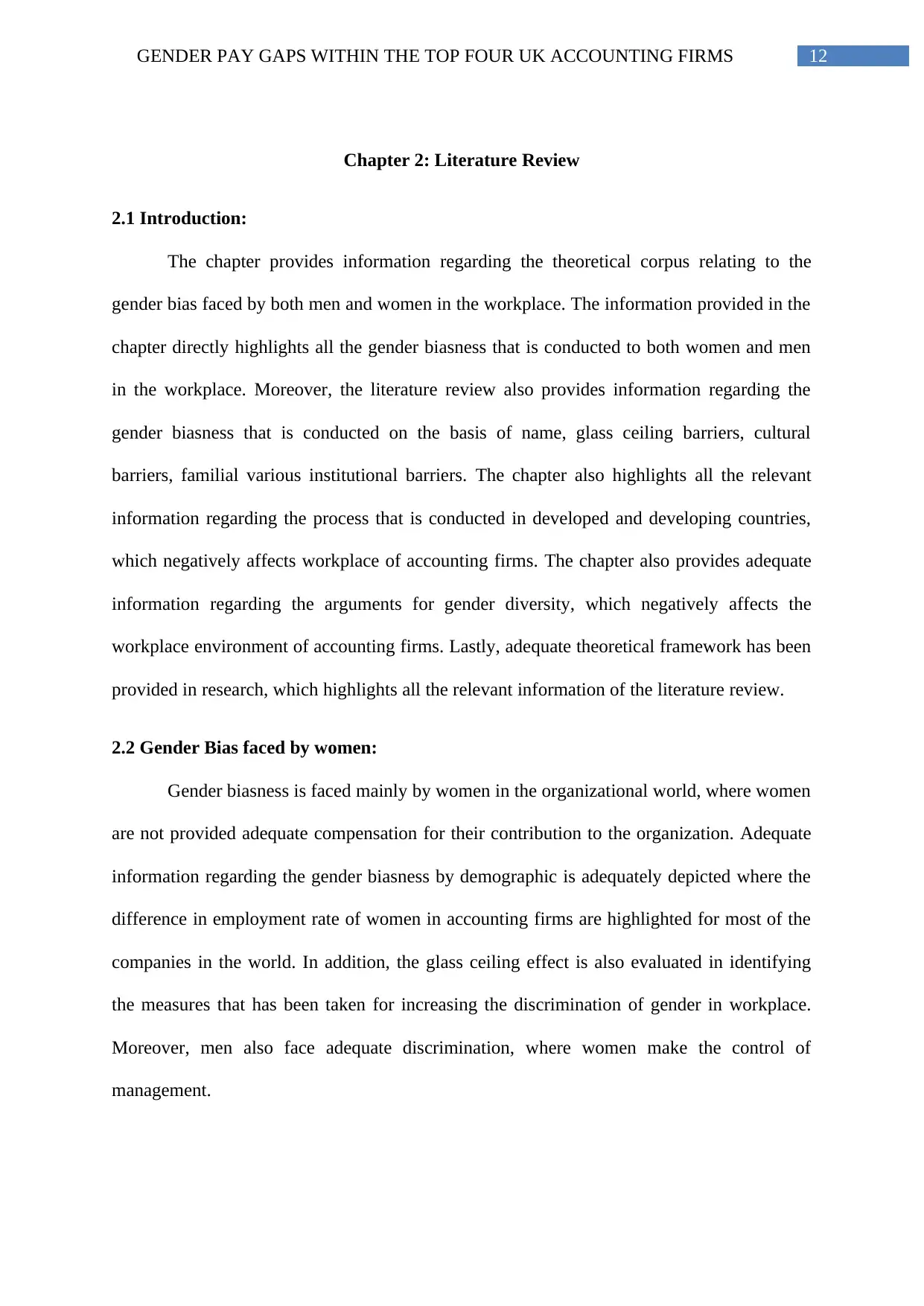
12GENDER PAY GAPS WITHIN THE TOP FOUR UK ACCOUNTING FIRMS
Chapter 2: Literature Review
2.1 Introduction:
The chapter provides information regarding the theoretical corpus relating to the
gender bias faced by both men and women in the workplace. The information provided in the
chapter directly highlights all the gender biasness that is conducted to both women and men
in the workplace. Moreover, the literature review also provides information regarding the
gender biasness that is conducted on the basis of name, glass ceiling barriers, cultural
barriers, familial various institutional barriers. The chapter also highlights all the relevant
information regarding the process that is conducted in developed and developing countries,
which negatively affects workplace of accounting firms. The chapter also provides adequate
information regarding the arguments for gender diversity, which negatively affects the
workplace environment of accounting firms. Lastly, adequate theoretical framework has been
provided in research, which highlights all the relevant information of the literature review.
2.2 Gender Bias faced by women:
Gender biasness is faced mainly by women in the organizational world, where women
are not provided adequate compensation for their contribution to the organization. Adequate
information regarding the gender biasness by demographic is adequately depicted where the
difference in employment rate of women in accounting firms are highlighted for most of the
companies in the world. In addition, the glass ceiling effect is also evaluated in identifying
the measures that has been taken for increasing the discrimination of gender in workplace.
Moreover, men also face adequate discrimination, where women make the control of
management.
Chapter 2: Literature Review
2.1 Introduction:
The chapter provides information regarding the theoretical corpus relating to the
gender bias faced by both men and women in the workplace. The information provided in the
chapter directly highlights all the gender biasness that is conducted to both women and men
in the workplace. Moreover, the literature review also provides information regarding the
gender biasness that is conducted on the basis of name, glass ceiling barriers, cultural
barriers, familial various institutional barriers. The chapter also highlights all the relevant
information regarding the process that is conducted in developed and developing countries,
which negatively affects workplace of accounting firms. The chapter also provides adequate
information regarding the arguments for gender diversity, which negatively affects the
workplace environment of accounting firms. Lastly, adequate theoretical framework has been
provided in research, which highlights all the relevant information of the literature review.
2.2 Gender Bias faced by women:
Gender biasness is faced mainly by women in the organizational world, where women
are not provided adequate compensation for their contribution to the organization. Adequate
information regarding the gender biasness by demographic is adequately depicted where the
difference in employment rate of women in accounting firms are highlighted for most of the
companies in the world. In addition, the glass ceiling effect is also evaluated in identifying
the measures that has been taken for increasing the discrimination of gender in workplace.
Moreover, men also face adequate discrimination, where women make the control of
management.
Paraphrase This Document
Need a fresh take? Get an instant paraphrase of this document with our AI Paraphraser

13GENDER PAY GAPS WITHIN THE TOP FOUR UK ACCOUNTING FIRMS
2.2.1 Gender Bias by demographics:
Gender biases are considered the inclination towards one gender, why discriminating
the other one. The gender biasness is mainly considered to be unequal and unbalanced
towards one sex enjoying most of the opportunities and rights than the other one. There is
proof regarding the discrimination in workspace by individuals with identical qualification
and opportunities, where one gender is preferred more than the other one. After evaluating
the statistics, it is understood that women account for only 63% of the accounting and
auditing jobs. The women all over the world have been facing problems in the organizational
world, where they are not able to acquire the adequate position and designation
(Assets.publishing.service.gov.uk2019). From the evaluation, it is also detected that 63% of
the Accountants and auditors in United States only account for the women. Moreover, census
report also provides information regarding Canada, where women only account for 50.5% of
auditors and accountants as the professional. Furthermore, revaluation also indicate that UK
as a percentage of 54.3% women in the accounting field, where the major accounting firms
like PWC, Deloitte, KPMG, and EY only accounts for 16.3%, 20.8%, 10.6% and 12.9% as
their women employee (Cfainstitute.org 2019).
From adequate evaluation, it is also identified that there is mismatch between the
gender compositions in higher position of public accounting industry. The analysis also
indicates that only 21% of the public accounting industry partners are females in comparison
to male. This directly provides information regarding the discrimination that is conducted to
females in higher posts. Moreover, the analysis also highlights that men are paid more than
women are by 16% to 26%, across various age categories. Therefore, it could be understood
that women are discriminated in the workplace by providing low pay in comparison to men
(Publications.parliament.uk2019).
2.2.1 Gender Bias by demographics:
Gender biases are considered the inclination towards one gender, why discriminating
the other one. The gender biasness is mainly considered to be unequal and unbalanced
towards one sex enjoying most of the opportunities and rights than the other one. There is
proof regarding the discrimination in workspace by individuals with identical qualification
and opportunities, where one gender is preferred more than the other one. After evaluating
the statistics, it is understood that women account for only 63% of the accounting and
auditing jobs. The women all over the world have been facing problems in the organizational
world, where they are not able to acquire the adequate position and designation
(Assets.publishing.service.gov.uk2019). From the evaluation, it is also detected that 63% of
the Accountants and auditors in United States only account for the women. Moreover, census
report also provides information regarding Canada, where women only account for 50.5% of
auditors and accountants as the professional. Furthermore, revaluation also indicate that UK
as a percentage of 54.3% women in the accounting field, where the major accounting firms
like PWC, Deloitte, KPMG, and EY only accounts for 16.3%, 20.8%, 10.6% and 12.9% as
their women employee (Cfainstitute.org 2019).
From adequate evaluation, it is also identified that there is mismatch between the
gender compositions in higher position of public accounting industry. The analysis also
indicates that only 21% of the public accounting industry partners are females in comparison
to male. This directly provides information regarding the discrimination that is conducted to
females in higher posts. Moreover, the analysis also highlights that men are paid more than
women are by 16% to 26%, across various age categories. Therefore, it could be understood
that women are discriminated in the workplace by providing low pay in comparison to men
(Publications.parliament.uk2019).
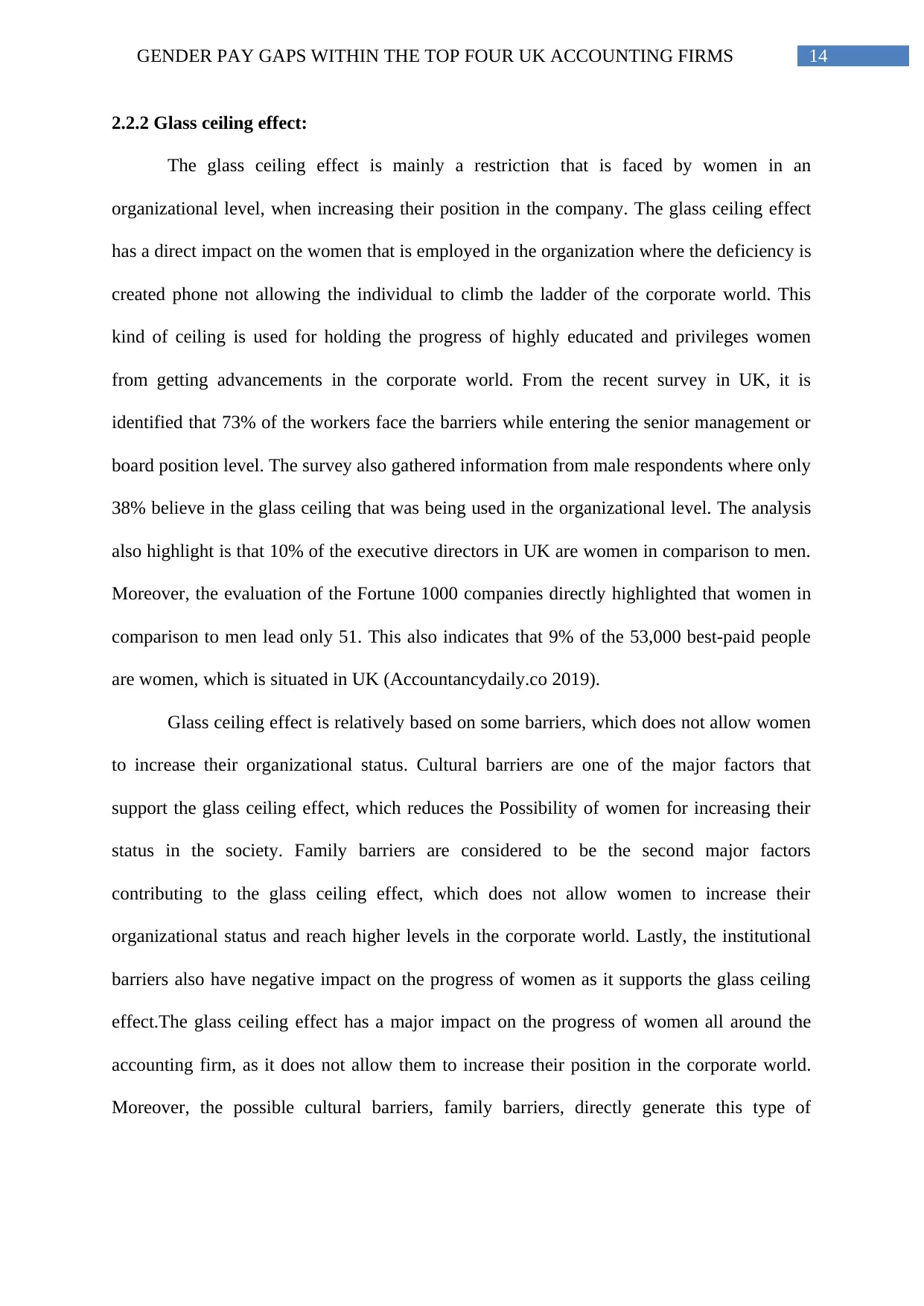
14GENDER PAY GAPS WITHIN THE TOP FOUR UK ACCOUNTING FIRMS
2.2.2 Glass ceiling effect:
The glass ceiling effect is mainly a restriction that is faced by women in an
organizational level, when increasing their position in the company. The glass ceiling effect
has a direct impact on the women that is employed in the organization where the deficiency is
created phone not allowing the individual to climb the ladder of the corporate world. This
kind of ceiling is used for holding the progress of highly educated and privileges women
from getting advancements in the corporate world. From the recent survey in UK, it is
identified that 73% of the workers face the barriers while entering the senior management or
board position level. The survey also gathered information from male respondents where only
38% believe in the glass ceiling that was being used in the organizational level. The analysis
also highlight is that 10% of the executive directors in UK are women in comparison to men.
Moreover, the evaluation of the Fortune 1000 companies directly highlighted that women in
comparison to men lead only 51. This also indicates that 9% of the 53,000 best-paid people
are women, which is situated in UK (Accountancydaily.co 2019).
Glass ceiling effect is relatively based on some barriers, which does not allow women
to increase their organizational status. Cultural barriers are one of the major factors that
support the glass ceiling effect, which reduces the Possibility of women for increasing their
status in the society. Family barriers are considered to be the second major factors
contributing to the glass ceiling effect, which does not allow women to increase their
organizational status and reach higher levels in the corporate world. Lastly, the institutional
barriers also have negative impact on the progress of women as it supports the glass ceiling
effect.The glass ceiling effect has a major impact on the progress of women all around the
accounting firm, as it does not allow them to increase their position in the corporate world.
Moreover, the possible cultural barriers, family barriers, directly generate this type of
2.2.2 Glass ceiling effect:
The glass ceiling effect is mainly a restriction that is faced by women in an
organizational level, when increasing their position in the company. The glass ceiling effect
has a direct impact on the women that is employed in the organization where the deficiency is
created phone not allowing the individual to climb the ladder of the corporate world. This
kind of ceiling is used for holding the progress of highly educated and privileges women
from getting advancements in the corporate world. From the recent survey in UK, it is
identified that 73% of the workers face the barriers while entering the senior management or
board position level. The survey also gathered information from male respondents where only
38% believe in the glass ceiling that was being used in the organizational level. The analysis
also highlight is that 10% of the executive directors in UK are women in comparison to men.
Moreover, the evaluation of the Fortune 1000 companies directly highlighted that women in
comparison to men lead only 51. This also indicates that 9% of the 53,000 best-paid people
are women, which is situated in UK (Accountancydaily.co 2019).
Glass ceiling effect is relatively based on some barriers, which does not allow women
to increase their organizational status. Cultural barriers are one of the major factors that
support the glass ceiling effect, which reduces the Possibility of women for increasing their
status in the society. Family barriers are considered to be the second major factors
contributing to the glass ceiling effect, which does not allow women to increase their
organizational status and reach higher levels in the corporate world. Lastly, the institutional
barriers also have negative impact on the progress of women as it supports the glass ceiling
effect.The glass ceiling effect has a major impact on the progress of women all around the
accounting firm, as it does not allow them to increase their position in the corporate world.
Moreover, the possible cultural barriers, family barriers, directly generate this type of
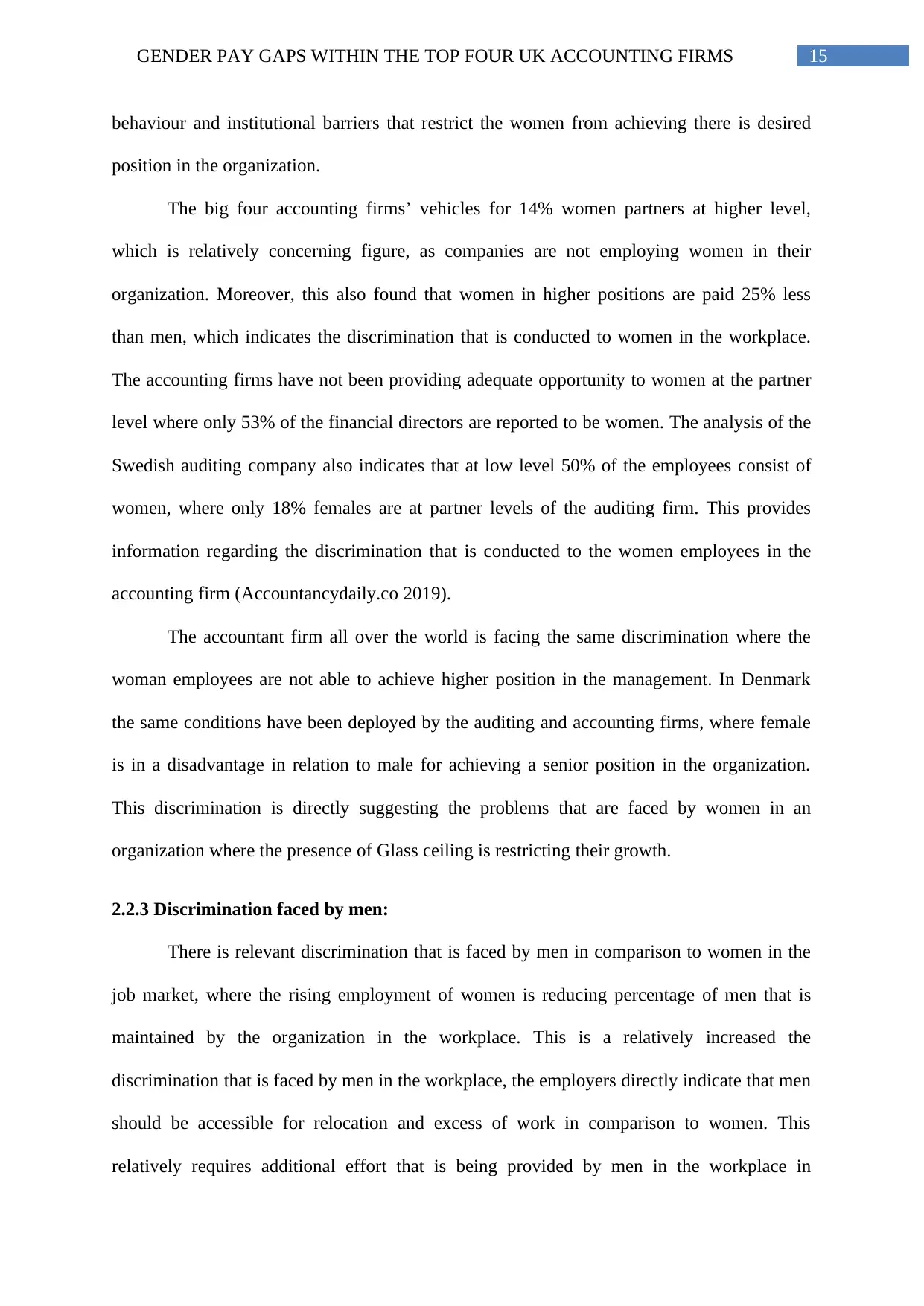
15GENDER PAY GAPS WITHIN THE TOP FOUR UK ACCOUNTING FIRMS
behaviour and institutional barriers that restrict the women from achieving there is desired
position in the organization.
The big four accounting firms’ vehicles for 14% women partners at higher level,
which is relatively concerning figure, as companies are not employing women in their
organization. Moreover, this also found that women in higher positions are paid 25% less
than men, which indicates the discrimination that is conducted to women in the workplace.
The accounting firms have not been providing adequate opportunity to women at the partner
level where only 53% of the financial directors are reported to be women. The analysis of the
Swedish auditing company also indicates that at low level 50% of the employees consist of
women, where only 18% females are at partner levels of the auditing firm. This provides
information regarding the discrimination that is conducted to the women employees in the
accounting firm (Accountancydaily.co 2019).
The accountant firm all over the world is facing the same discrimination where the
woman employees are not able to achieve higher position in the management. In Denmark
the same conditions have been deployed by the auditing and accounting firms, where female
is in a disadvantage in relation to male for achieving a senior position in the organization.
This discrimination is directly suggesting the problems that are faced by women in an
organization where the presence of Glass ceiling is restricting their growth.
2.2.3 Discrimination faced by men:
There is relevant discrimination that is faced by men in comparison to women in the
job market, where the rising employment of women is reducing percentage of men that is
maintained by the organization in the workplace. This is a relatively increased the
discrimination that is faced by men in the workplace, the employers directly indicate that men
should be accessible for relocation and excess of work in comparison to women. This
relatively requires additional effort that is being provided by men in the workplace in
behaviour and institutional barriers that restrict the women from achieving there is desired
position in the organization.
The big four accounting firms’ vehicles for 14% women partners at higher level,
which is relatively concerning figure, as companies are not employing women in their
organization. Moreover, this also found that women in higher positions are paid 25% less
than men, which indicates the discrimination that is conducted to women in the workplace.
The accounting firms have not been providing adequate opportunity to women at the partner
level where only 53% of the financial directors are reported to be women. The analysis of the
Swedish auditing company also indicates that at low level 50% of the employees consist of
women, where only 18% females are at partner levels of the auditing firm. This provides
information regarding the discrimination that is conducted to the women employees in the
accounting firm (Accountancydaily.co 2019).
The accountant firm all over the world is facing the same discrimination where the
woman employees are not able to achieve higher position in the management. In Denmark
the same conditions have been deployed by the auditing and accounting firms, where female
is in a disadvantage in relation to male for achieving a senior position in the organization.
This discrimination is directly suggesting the problems that are faced by women in an
organization where the presence of Glass ceiling is restricting their growth.
2.2.3 Discrimination faced by men:
There is relevant discrimination that is faced by men in comparison to women in the
job market, where the rising employment of women is reducing percentage of men that is
maintained by the organization in the workplace. This is a relatively increased the
discrimination that is faced by men in the workplace, the employers directly indicate that men
should be accessible for relocation and excess of work in comparison to women. This
relatively requires additional effort that is being provided by men in the workplace in
Secure Best Marks with AI Grader
Need help grading? Try our AI Grader for instant feedback on your assignments.
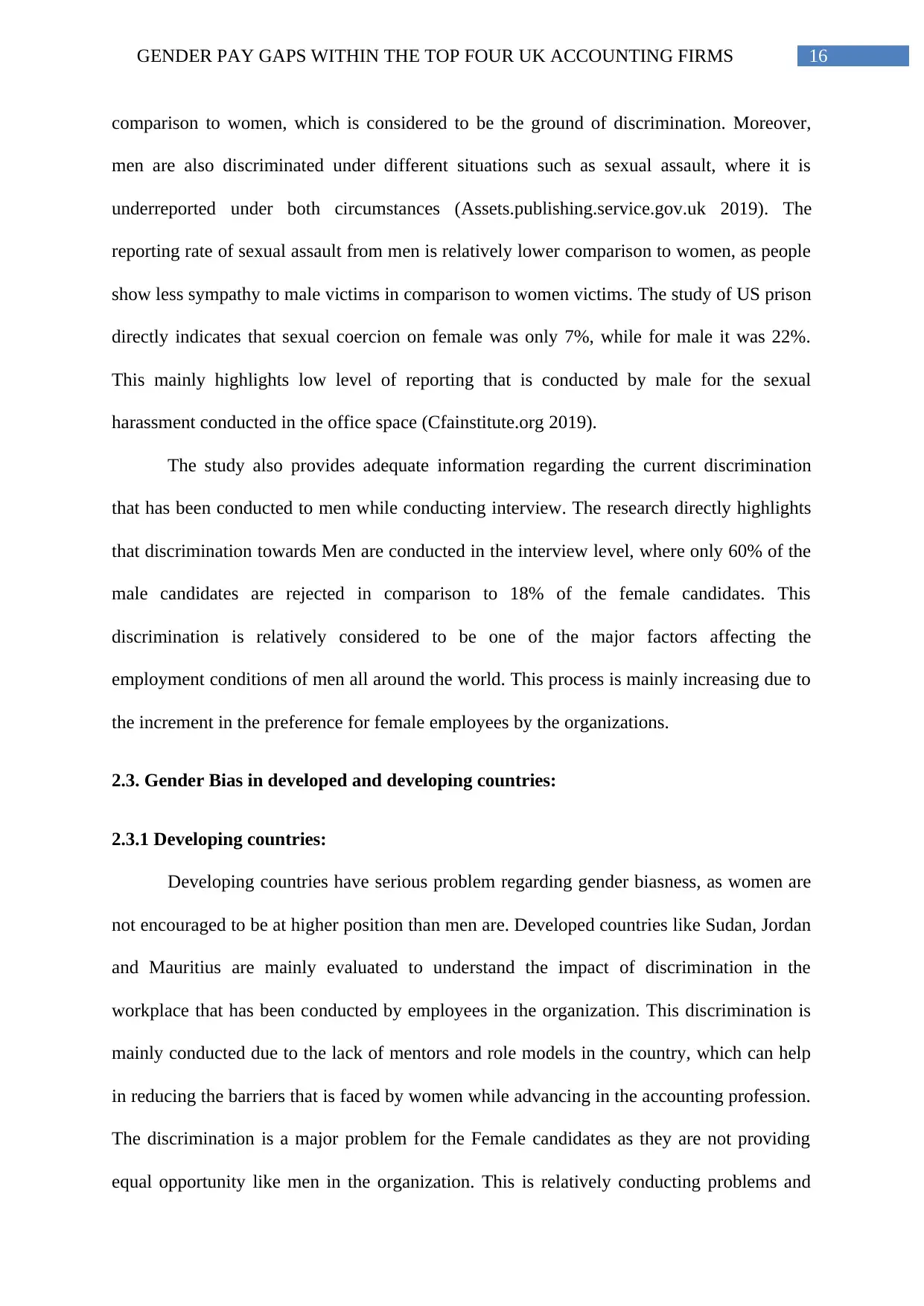
16GENDER PAY GAPS WITHIN THE TOP FOUR UK ACCOUNTING FIRMS
comparison to women, which is considered to be the ground of discrimination. Moreover,
men are also discriminated under different situations such as sexual assault, where it is
underreported under both circumstances (Assets.publishing.service.gov.uk 2019). The
reporting rate of sexual assault from men is relatively lower comparison to women, as people
show less sympathy to male victims in comparison to women victims. The study of US prison
directly indicates that sexual coercion on female was only 7%, while for male it was 22%.
This mainly highlights low level of reporting that is conducted by male for the sexual
harassment conducted in the office space (Cfainstitute.org 2019).
The study also provides adequate information regarding the current discrimination
that has been conducted to men while conducting interview. The research directly highlights
that discrimination towards Men are conducted in the interview level, where only 60% of the
male candidates are rejected in comparison to 18% of the female candidates. This
discrimination is relatively considered to be one of the major factors affecting the
employment conditions of men all around the world. This process is mainly increasing due to
the increment in the preference for female employees by the organizations.
2.3. Gender Bias in developed and developing countries:
2.3.1 Developing countries:
Developing countries have serious problem regarding gender biasness, as women are
not encouraged to be at higher position than men are. Developed countries like Sudan, Jordan
and Mauritius are mainly evaluated to understand the impact of discrimination in the
workplace that has been conducted by employees in the organization. This discrimination is
mainly conducted due to the lack of mentors and role models in the country, which can help
in reducing the barriers that is faced by women while advancing in the accounting profession.
The discrimination is a major problem for the Female candidates as they are not providing
equal opportunity like men in the organization. This is relatively conducting problems and
comparison to women, which is considered to be the ground of discrimination. Moreover,
men are also discriminated under different situations such as sexual assault, where it is
underreported under both circumstances (Assets.publishing.service.gov.uk 2019). The
reporting rate of sexual assault from men is relatively lower comparison to women, as people
show less sympathy to male victims in comparison to women victims. The study of US prison
directly indicates that sexual coercion on female was only 7%, while for male it was 22%.
This mainly highlights low level of reporting that is conducted by male for the sexual
harassment conducted in the office space (Cfainstitute.org 2019).
The study also provides adequate information regarding the current discrimination
that has been conducted to men while conducting interview. The research directly highlights
that discrimination towards Men are conducted in the interview level, where only 60% of the
male candidates are rejected in comparison to 18% of the female candidates. This
discrimination is relatively considered to be one of the major factors affecting the
employment conditions of men all around the world. This process is mainly increasing due to
the increment in the preference for female employees by the organizations.
2.3. Gender Bias in developed and developing countries:
2.3.1 Developing countries:
Developing countries have serious problem regarding gender biasness, as women are
not encouraged to be at higher position than men are. Developed countries like Sudan, Jordan
and Mauritius are mainly evaluated to understand the impact of discrimination in the
workplace that has been conducted by employees in the organization. This discrimination is
mainly conducted due to the lack of mentors and role models in the country, which can help
in reducing the barriers that is faced by women while advancing in the accounting profession.
The discrimination is a major problem for the Female candidates as they are not providing
equal opportunity like men in the organization. This is relatively conducting problems and
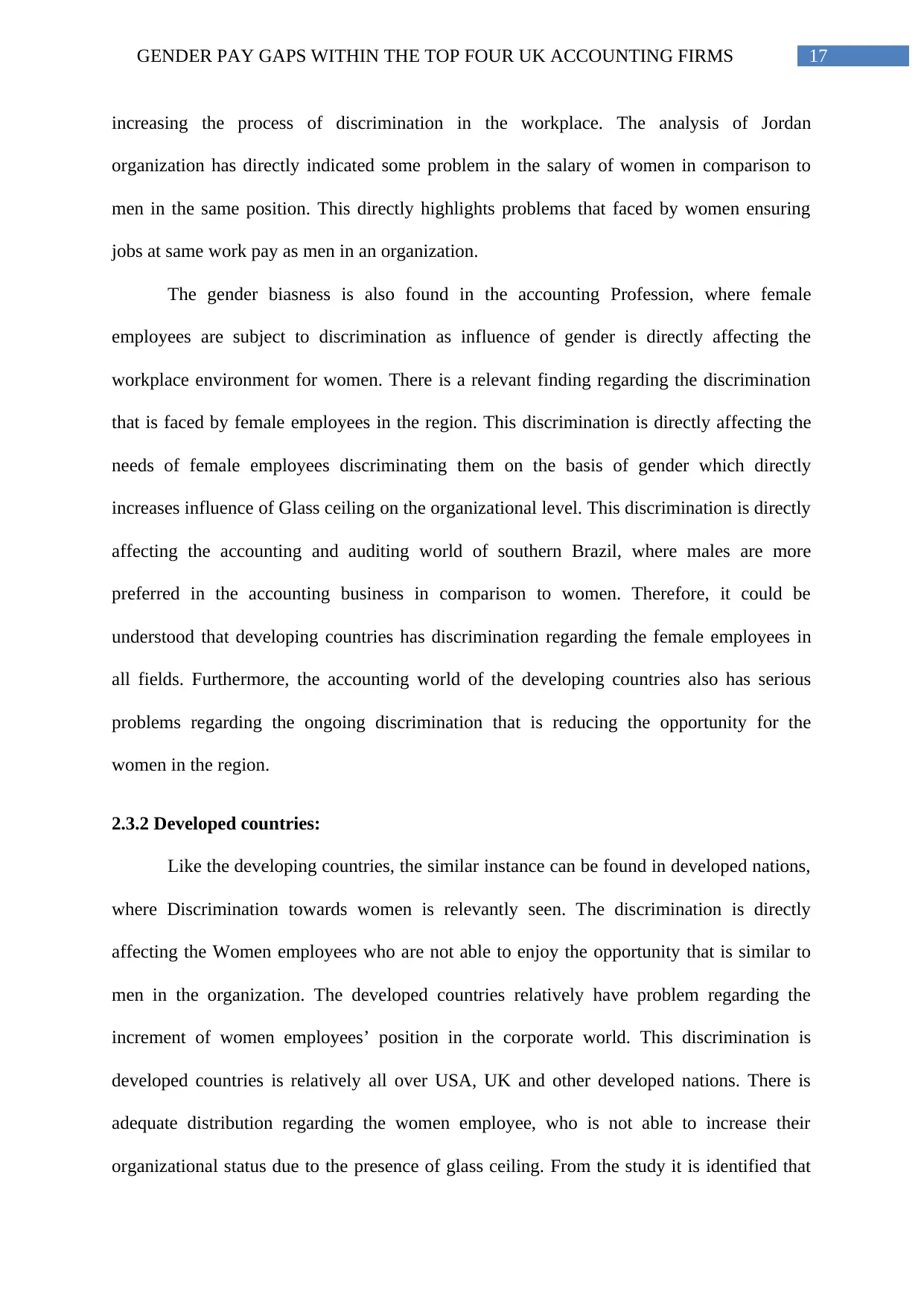
17GENDER PAY GAPS WITHIN THE TOP FOUR UK ACCOUNTING FIRMS
increasing the process of discrimination in the workplace. The analysis of Jordan
organization has directly indicated some problem in the salary of women in comparison to
men in the same position. This directly highlights problems that faced by women ensuring
jobs at same work pay as men in an organization.
The gender biasness is also found in the accounting Profession, where female
employees are subject to discrimination as influence of gender is directly affecting the
workplace environment for women. There is a relevant finding regarding the discrimination
that is faced by female employees in the region. This discrimination is directly affecting the
needs of female employees discriminating them on the basis of gender which directly
increases influence of Glass ceiling on the organizational level. This discrimination is directly
affecting the accounting and auditing world of southern Brazil, where males are more
preferred in the accounting business in comparison to women. Therefore, it could be
understood that developing countries has discrimination regarding the female employees in
all fields. Furthermore, the accounting world of the developing countries also has serious
problems regarding the ongoing discrimination that is reducing the opportunity for the
women in the region.
2.3.2 Developed countries:
Like the developing countries, the similar instance can be found in developed nations,
where Discrimination towards women is relevantly seen. The discrimination is directly
affecting the Women employees who are not able to enjoy the opportunity that is similar to
men in the organization. The developed countries relatively have problem regarding the
increment of women employees’ position in the corporate world. This discrimination is
developed countries is relatively all over USA, UK and other developed nations. There is
adequate distribution regarding the women employee, who is not able to increase their
organizational status due to the presence of glass ceiling. From the study it is identified that
increasing the process of discrimination in the workplace. The analysis of Jordan
organization has directly indicated some problem in the salary of women in comparison to
men in the same position. This directly highlights problems that faced by women ensuring
jobs at same work pay as men in an organization.
The gender biasness is also found in the accounting Profession, where female
employees are subject to discrimination as influence of gender is directly affecting the
workplace environment for women. There is a relevant finding regarding the discrimination
that is faced by female employees in the region. This discrimination is directly affecting the
needs of female employees discriminating them on the basis of gender which directly
increases influence of Glass ceiling on the organizational level. This discrimination is directly
affecting the accounting and auditing world of southern Brazil, where males are more
preferred in the accounting business in comparison to women. Therefore, it could be
understood that developing countries has discrimination regarding the female employees in
all fields. Furthermore, the accounting world of the developing countries also has serious
problems regarding the ongoing discrimination that is reducing the opportunity for the
women in the region.
2.3.2 Developed countries:
Like the developing countries, the similar instance can be found in developed nations,
where Discrimination towards women is relevantly seen. The discrimination is directly
affecting the Women employees who are not able to enjoy the opportunity that is similar to
men in the organization. The developed countries relatively have problem regarding the
increment of women employees’ position in the corporate world. This discrimination is
developed countries is relatively all over USA, UK and other developed nations. There is
adequate distribution regarding the women employee, who is not able to increase their
organizational status due to the presence of glass ceiling. From the study it is identified that
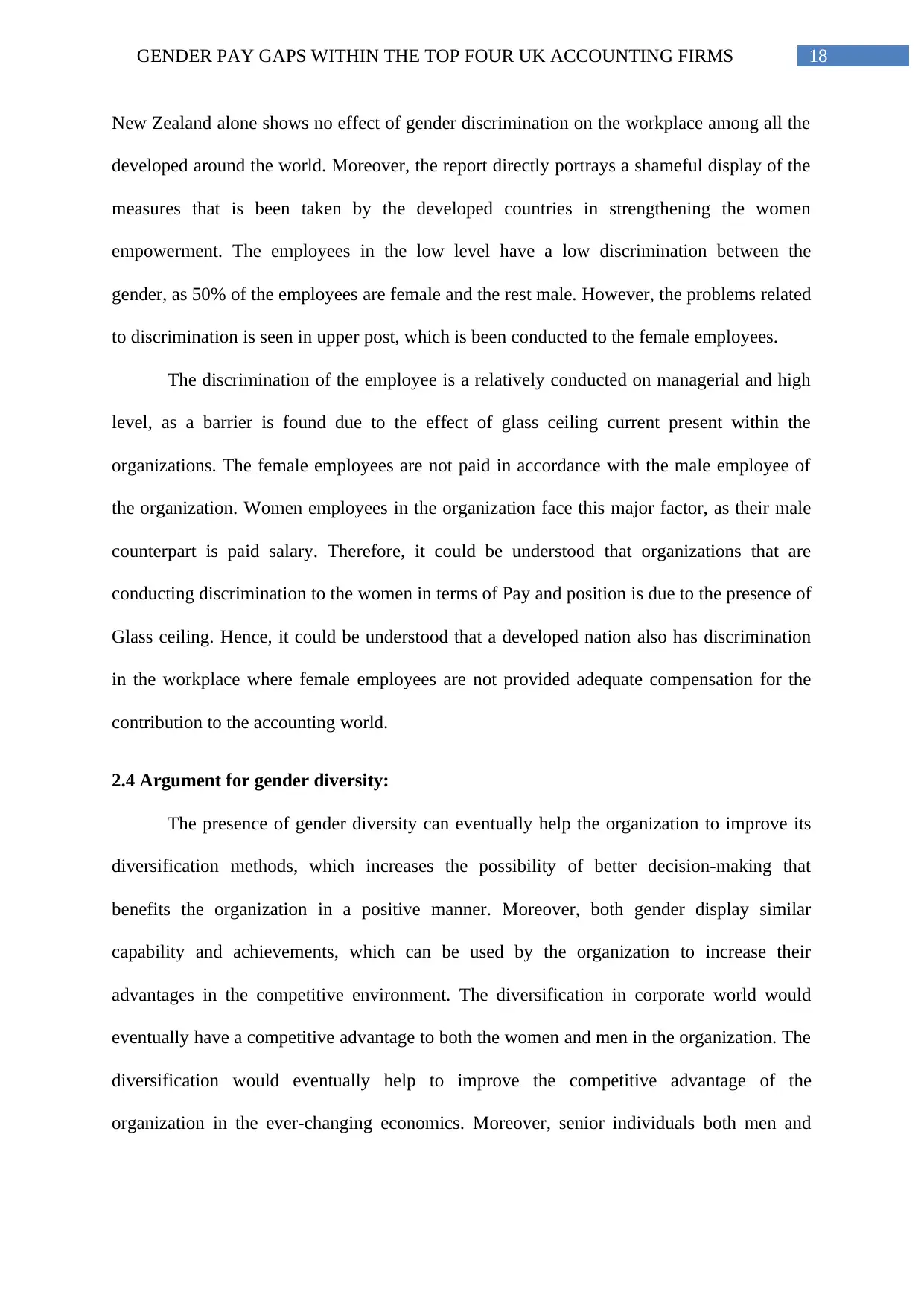
18GENDER PAY GAPS WITHIN THE TOP FOUR UK ACCOUNTING FIRMS
New Zealand alone shows no effect of gender discrimination on the workplace among all the
developed around the world. Moreover, the report directly portrays a shameful display of the
measures that is been taken by the developed countries in strengthening the women
empowerment. The employees in the low level have a low discrimination between the
gender, as 50% of the employees are female and the rest male. However, the problems related
to discrimination is seen in upper post, which is been conducted to the female employees.
The discrimination of the employee is a relatively conducted on managerial and high
level, as a barrier is found due to the effect of glass ceiling current present within the
organizations. The female employees are not paid in accordance with the male employee of
the organization. Women employees in the organization face this major factor, as their male
counterpart is paid salary. Therefore, it could be understood that organizations that are
conducting discrimination to the women in terms of Pay and position is due to the presence of
Glass ceiling. Hence, it could be understood that a developed nation also has discrimination
in the workplace where female employees are not provided adequate compensation for the
contribution to the accounting world.
2.4 Argument for gender diversity:
The presence of gender diversity can eventually help the organization to improve its
diversification methods, which increases the possibility of better decision-making that
benefits the organization in a positive manner. Moreover, both gender display similar
capability and achievements, which can be used by the organization to increase their
advantages in the competitive environment. The diversification in corporate world would
eventually have a competitive advantage to both the women and men in the organization. The
diversification would eventually help to improve the competitive advantage of the
organization in the ever-changing economics. Moreover, senior individuals both men and
New Zealand alone shows no effect of gender discrimination on the workplace among all the
developed around the world. Moreover, the report directly portrays a shameful display of the
measures that is been taken by the developed countries in strengthening the women
empowerment. The employees in the low level have a low discrimination between the
gender, as 50% of the employees are female and the rest male. However, the problems related
to discrimination is seen in upper post, which is been conducted to the female employees.
The discrimination of the employee is a relatively conducted on managerial and high
level, as a barrier is found due to the effect of glass ceiling current present within the
organizations. The female employees are not paid in accordance with the male employee of
the organization. Women employees in the organization face this major factor, as their male
counterpart is paid salary. Therefore, it could be understood that organizations that are
conducting discrimination to the women in terms of Pay and position is due to the presence of
Glass ceiling. Hence, it could be understood that a developed nation also has discrimination
in the workplace where female employees are not provided adequate compensation for the
contribution to the accounting world.
2.4 Argument for gender diversity:
The presence of gender diversity can eventually help the organization to improve its
diversification methods, which increases the possibility of better decision-making that
benefits the organization in a positive manner. Moreover, both gender display similar
capability and achievements, which can be used by the organization to increase their
advantages in the competitive environment. The diversification in corporate world would
eventually have a competitive advantage to both the women and men in the organization. The
diversification would eventually help to improve the competitive advantage of the
organization in the ever-changing economics. Moreover, senior individuals both men and
Paraphrase This Document
Need a fresh take? Get an instant paraphrase of this document with our AI Paraphraser
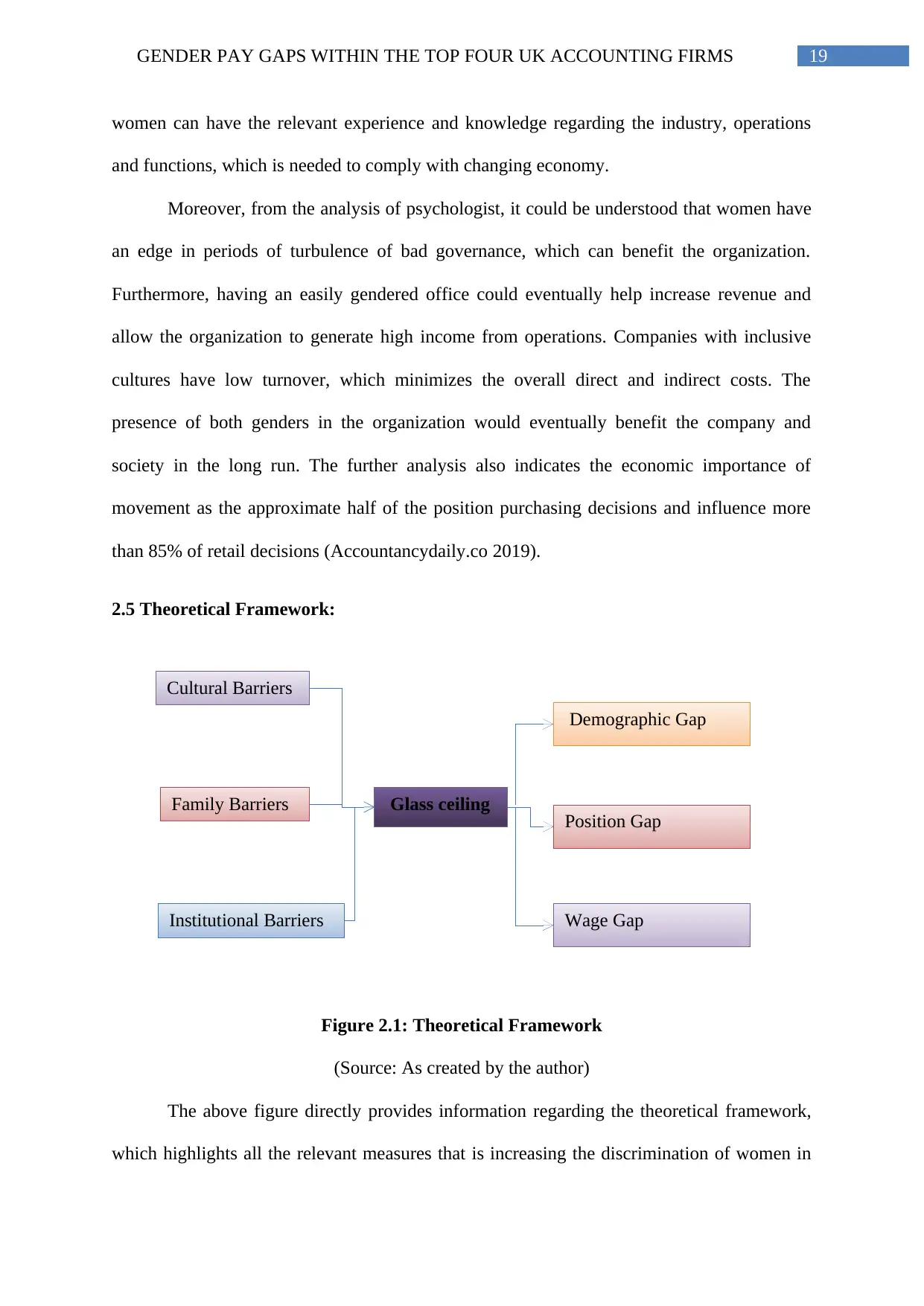
Cultural Barriers
Glass ceiling
Institutional Barriers
Family Barriers
Demographic Gap
Position Gap
Wage Gap
19GENDER PAY GAPS WITHIN THE TOP FOUR UK ACCOUNTING FIRMS
women can have the relevant experience and knowledge regarding the industry, operations
and functions, which is needed to comply with changing economy.
Moreover, from the analysis of psychologist, it could be understood that women have
an edge in periods of turbulence of bad governance, which can benefit the organization.
Furthermore, having an easily gendered office could eventually help increase revenue and
allow the organization to generate high income from operations. Companies with inclusive
cultures have low turnover, which minimizes the overall direct and indirect costs. The
presence of both genders in the organization would eventually benefit the company and
society in the long run. The further analysis also indicates the economic importance of
movement as the approximate half of the position purchasing decisions and influence more
than 85% of retail decisions (Accountancydaily.co 2019).
2.5 Theoretical Framework:
Figure 2.1: Theoretical Framework
(Source: As created by the author)
The above figure directly provides information regarding the theoretical framework,
which highlights all the relevant measures that is increasing the discrimination of women in
Glass ceiling
Institutional Barriers
Family Barriers
Demographic Gap
Position Gap
Wage Gap
19GENDER PAY GAPS WITHIN THE TOP FOUR UK ACCOUNTING FIRMS
women can have the relevant experience and knowledge regarding the industry, operations
and functions, which is needed to comply with changing economy.
Moreover, from the analysis of psychologist, it could be understood that women have
an edge in periods of turbulence of bad governance, which can benefit the organization.
Furthermore, having an easily gendered office could eventually help increase revenue and
allow the organization to generate high income from operations. Companies with inclusive
cultures have low turnover, which minimizes the overall direct and indirect costs. The
presence of both genders in the organization would eventually benefit the company and
society in the long run. The further analysis also indicates the economic importance of
movement as the approximate half of the position purchasing decisions and influence more
than 85% of retail decisions (Accountancydaily.co 2019).
2.5 Theoretical Framework:
Figure 2.1: Theoretical Framework
(Source: As created by the author)
The above figure directly provides information regarding the theoretical framework,
which highlights all the relevant measures that is increasing the discrimination of women in
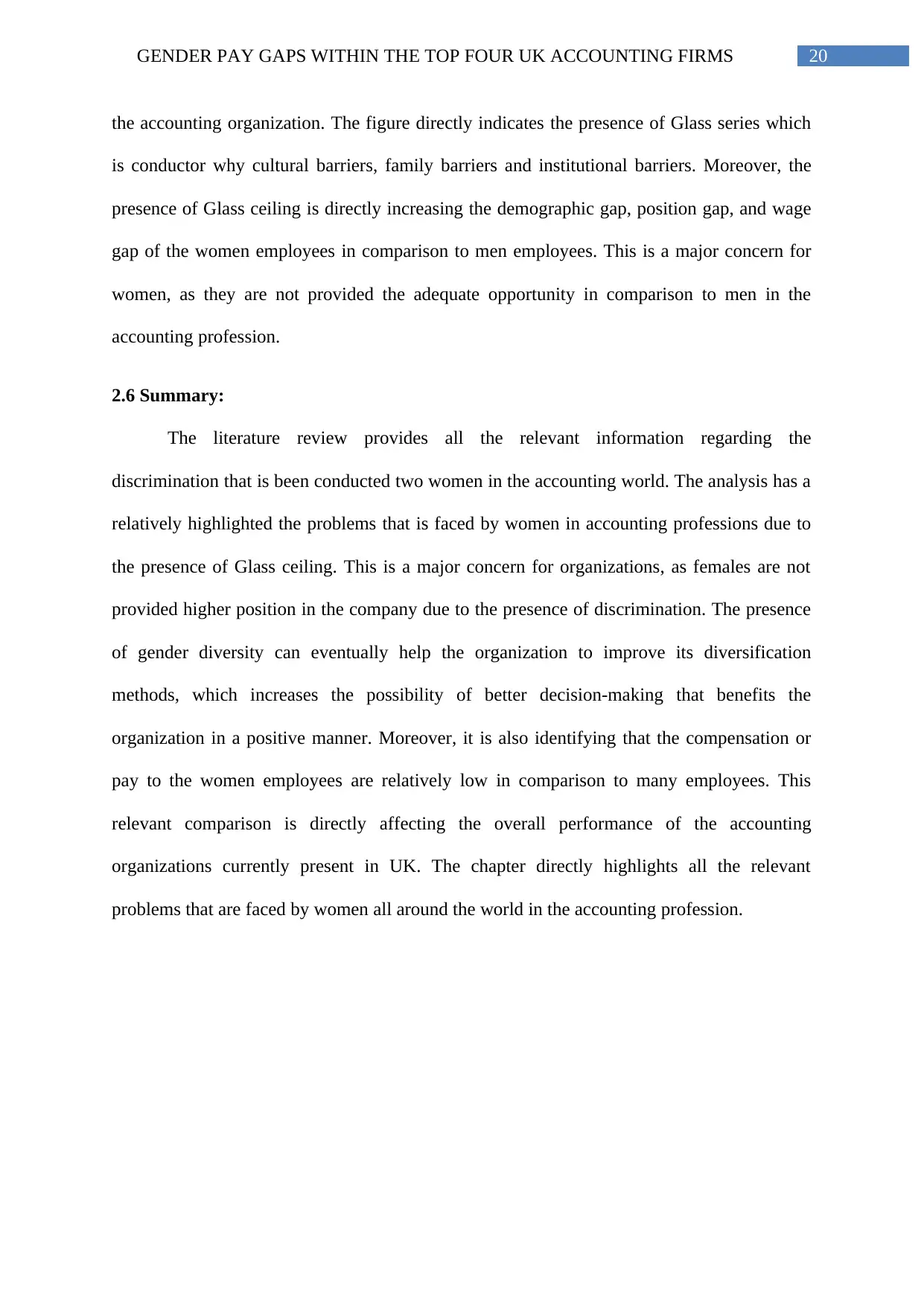
20GENDER PAY GAPS WITHIN THE TOP FOUR UK ACCOUNTING FIRMS
the accounting organization. The figure directly indicates the presence of Glass series which
is conductor why cultural barriers, family barriers and institutional barriers. Moreover, the
presence of Glass ceiling is directly increasing the demographic gap, position gap, and wage
gap of the women employees in comparison to men employees. This is a major concern for
women, as they are not provided the adequate opportunity in comparison to men in the
accounting profession.
2.6 Summary:
The literature review provides all the relevant information regarding the
discrimination that is been conducted two women in the accounting world. The analysis has a
relatively highlighted the problems that is faced by women in accounting professions due to
the presence of Glass ceiling. This is a major concern for organizations, as females are not
provided higher position in the company due to the presence of discrimination. The presence
of gender diversity can eventually help the organization to improve its diversification
methods, which increases the possibility of better decision-making that benefits the
organization in a positive manner. Moreover, it is also identifying that the compensation or
pay to the women employees are relatively low in comparison to many employees. This
relevant comparison is directly affecting the overall performance of the accounting
organizations currently present in UK. The chapter directly highlights all the relevant
problems that are faced by women all around the world in the accounting profession.
the accounting organization. The figure directly indicates the presence of Glass series which
is conductor why cultural barriers, family barriers and institutional barriers. Moreover, the
presence of Glass ceiling is directly increasing the demographic gap, position gap, and wage
gap of the women employees in comparison to men employees. This is a major concern for
women, as they are not provided the adequate opportunity in comparison to men in the
accounting profession.
2.6 Summary:
The literature review provides all the relevant information regarding the
discrimination that is been conducted two women in the accounting world. The analysis has a
relatively highlighted the problems that is faced by women in accounting professions due to
the presence of Glass ceiling. This is a major concern for organizations, as females are not
provided higher position in the company due to the presence of discrimination. The presence
of gender diversity can eventually help the organization to improve its diversification
methods, which increases the possibility of better decision-making that benefits the
organization in a positive manner. Moreover, it is also identifying that the compensation or
pay to the women employees are relatively low in comparison to many employees. This
relevant comparison is directly affecting the overall performance of the accounting
organizations currently present in UK. The chapter directly highlights all the relevant
problems that are faced by women all around the world in the accounting profession.

21GENDER PAY GAPS WITHIN THE TOP FOUR UK ACCOUNTING FIRMS
Chapter 3: Research Methodology
3.0 Introduction:
The research methodology chapter has facilitated the researcher in explaining type of
research approach, design and strategies those are employed in gathering constructive
findings from the study. This chapter has also outlines techniques in attaining effective
opportunities that can increase research results authenticity.
3.1 Gender pay gaps within the top four UK accounting firms
This chapter has explained the research design along with strategy employed to carry
out a research along with analyzing the manner in which the research will follow the
university ethical guidelines. The research design in analyzing gender pay gaps within top
four UK accounting companies over the span of 10 years is indicated below:
Positivism
Deduction
Primary Research
Questionnaire for Pilot Study
Final Questionnaire
Applicable Statistics
Qualitative Data Used from Literature
Ethical Considerations
Limitations
Chapter 3: Research Methodology
3.0 Introduction:
The research methodology chapter has facilitated the researcher in explaining type of
research approach, design and strategies those are employed in gathering constructive
findings from the study. This chapter has also outlines techniques in attaining effective
opportunities that can increase research results authenticity.
3.1 Gender pay gaps within the top four UK accounting firms
This chapter has explained the research design along with strategy employed to carry
out a research along with analyzing the manner in which the research will follow the
university ethical guidelines. The research design in analyzing gender pay gaps within top
four UK accounting companies over the span of 10 years is indicated below:
Positivism
Deduction
Primary Research
Questionnaire for Pilot Study
Final Questionnaire
Applicable Statistics
Qualitative Data Used from Literature
Ethical Considerations
Limitations
Secure Best Marks with AI Grader
Need help grading? Try our AI Grader for instant feedback on your assignments.

22GENDER PAY GAPS WITHIN THE TOP FOUR UK ACCOUNTING FIRMS
Figure 3.1: Overview of research methodology
(Source: As created by author)
3.2 Research Paradigm
In selecting the suitable research paradigm an applicable research philosophy is
employed in recognizing the research essence. In carrying out research on the gender pay
gaps within the top four UK accounting companies, positivism research paradigm has been
employed. This paradigm is deemed to be suitable as it includes set of characteristics that
encompass resistance of reality through employing scientifically proven techniques (Mackey
and Gass 2015). Based on the research subject, the researcher has made attempt to evaluate
the gender pay gaps within the top four UK accounting companies over the past 10 years. The
researcher has implemented the positivism philosophy through linking the models along with
theories explained within the literature review section in the recent scenario. In this recent
researcher in order to attain highly constructive findings, positivism is the most applicable
research paradigm in attaining accurate responses from the sample respondents. The
researcher did not consider implementing other research paradigm for the reason that they are
not relied on the scientifically proven models and theories (Silverman 2016). The positivist
research paradigm is selected in the current study because of its nature of study that needed
the use of large sample developing quantitative results for attaining highly reliable results that
can be generalized within the wider population.
3.3 Research Approach
Considering the research aim that is to reveal whether a gender pay gap is present in
the selected four accounting and finance companies, the major research design is relied on
qualitative and quantitative research. Considering such aim, the deductive research approach
was employed that involves a theory development which is subjective to an appropriate test
and also employed highly structured research methodology (Taylor, Bogdan and DeVault
Figure 3.1: Overview of research methodology
(Source: As created by author)
3.2 Research Paradigm
In selecting the suitable research paradigm an applicable research philosophy is
employed in recognizing the research essence. In carrying out research on the gender pay
gaps within the top four UK accounting companies, positivism research paradigm has been
employed. This paradigm is deemed to be suitable as it includes set of characteristics that
encompass resistance of reality through employing scientifically proven techniques (Mackey
and Gass 2015). Based on the research subject, the researcher has made attempt to evaluate
the gender pay gaps within the top four UK accounting companies over the past 10 years. The
researcher has implemented the positivism philosophy through linking the models along with
theories explained within the literature review section in the recent scenario. In this recent
researcher in order to attain highly constructive findings, positivism is the most applicable
research paradigm in attaining accurate responses from the sample respondents. The
researcher did not consider implementing other research paradigm for the reason that they are
not relied on the scientifically proven models and theories (Silverman 2016). The positivist
research paradigm is selected in the current study because of its nature of study that needed
the use of large sample developing quantitative results for attaining highly reliable results that
can be generalized within the wider population.
3.3 Research Approach
Considering the research aim that is to reveal whether a gender pay gap is present in
the selected four accounting and finance companies, the major research design is relied on
qualitative and quantitative research. Considering such aim, the deductive research approach
was employed that involves a theory development which is subjective to an appropriate test
and also employed highly structured research methodology (Taylor, Bogdan and DeVault
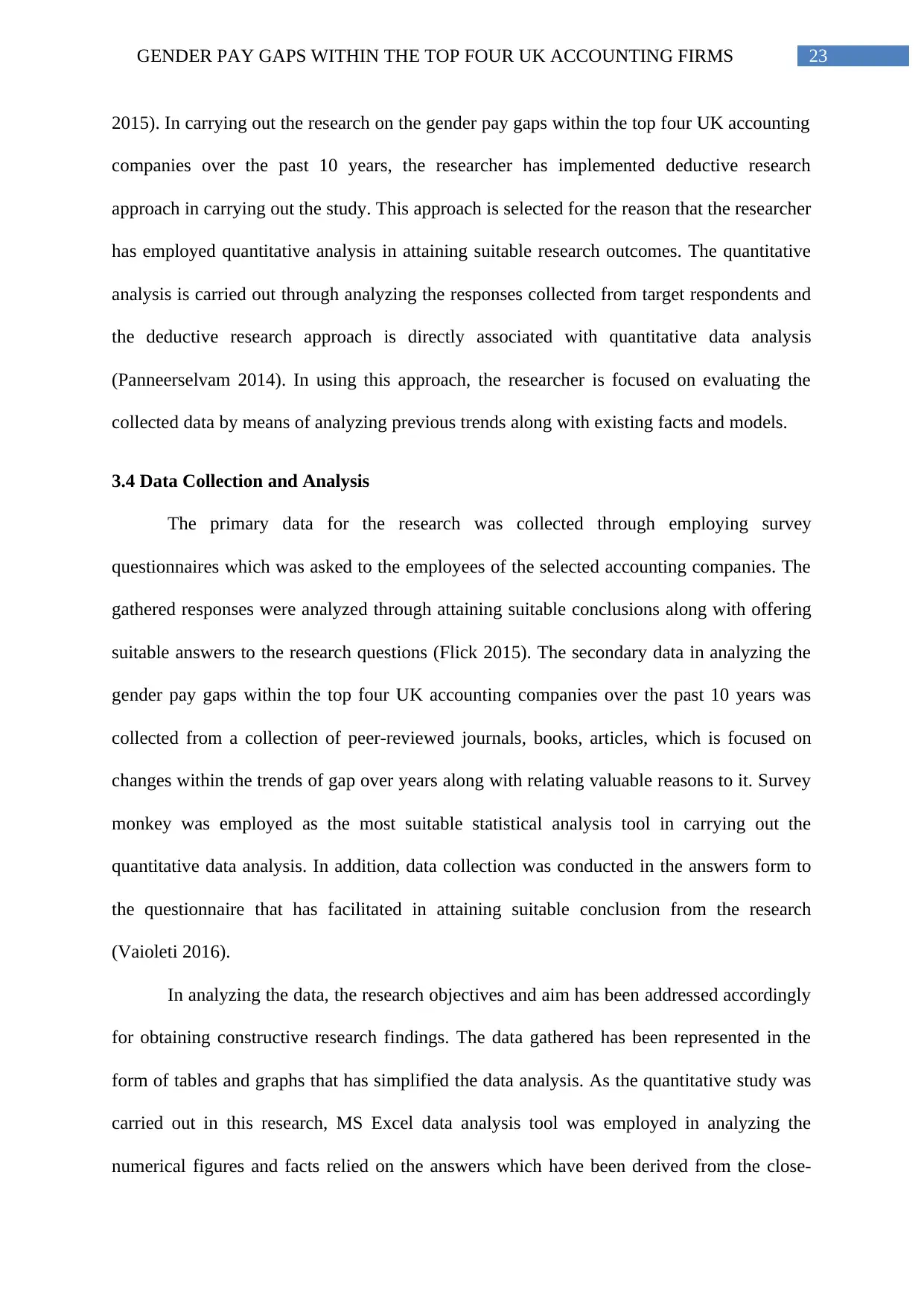
23GENDER PAY GAPS WITHIN THE TOP FOUR UK ACCOUNTING FIRMS
2015). In carrying out the research on the gender pay gaps within the top four UK accounting
companies over the past 10 years, the researcher has implemented deductive research
approach in carrying out the study. This approach is selected for the reason that the researcher
has employed quantitative analysis in attaining suitable research outcomes. The quantitative
analysis is carried out through analyzing the responses collected from target respondents and
the deductive research approach is directly associated with quantitative data analysis
(Panneerselvam 2014). In using this approach, the researcher is focused on evaluating the
collected data by means of analyzing previous trends along with existing facts and models.
3.4 Data Collection and Analysis
The primary data for the research was collected through employing survey
questionnaires which was asked to the employees of the selected accounting companies. The
gathered responses were analyzed through attaining suitable conclusions along with offering
suitable answers to the research questions (Flick 2015). The secondary data in analyzing the
gender pay gaps within the top four UK accounting companies over the past 10 years was
collected from a collection of peer-reviewed journals, books, articles, which is focused on
changes within the trends of gap over years along with relating valuable reasons to it. Survey
monkey was employed as the most suitable statistical analysis tool in carrying out the
quantitative data analysis. In addition, data collection was conducted in the answers form to
the questionnaire that has facilitated in attaining suitable conclusion from the research
(Vaioleti 2016).
In analyzing the data, the research objectives and aim has been addressed accordingly
for obtaining constructive research findings. The data gathered has been represented in the
form of tables and graphs that has simplified the data analysis. As the quantitative study was
carried out in this research, MS Excel data analysis tool was employed in analyzing the
numerical figures and facts relied on the answers which have been derived from the close-
2015). In carrying out the research on the gender pay gaps within the top four UK accounting
companies over the past 10 years, the researcher has implemented deductive research
approach in carrying out the study. This approach is selected for the reason that the researcher
has employed quantitative analysis in attaining suitable research outcomes. The quantitative
analysis is carried out through analyzing the responses collected from target respondents and
the deductive research approach is directly associated with quantitative data analysis
(Panneerselvam 2014). In using this approach, the researcher is focused on evaluating the
collected data by means of analyzing previous trends along with existing facts and models.
3.4 Data Collection and Analysis
The primary data for the research was collected through employing survey
questionnaires which was asked to the employees of the selected accounting companies. The
gathered responses were analyzed through attaining suitable conclusions along with offering
suitable answers to the research questions (Flick 2015). The secondary data in analyzing the
gender pay gaps within the top four UK accounting companies over the past 10 years was
collected from a collection of peer-reviewed journals, books, articles, which is focused on
changes within the trends of gap over years along with relating valuable reasons to it. Survey
monkey was employed as the most suitable statistical analysis tool in carrying out the
quantitative data analysis. In addition, data collection was conducted in the answers form to
the questionnaire that has facilitated in attaining suitable conclusion from the research
(Vaioleti 2016).
In analyzing the data, the research objectives and aim has been addressed accordingly
for obtaining constructive research findings. The data gathered has been represented in the
form of tables and graphs that has simplified the data analysis. As the quantitative study was
carried out in this research, MS Excel data analysis tool was employed in analyzing the
numerical figures and facts relied on the answers which have been derived from the close-
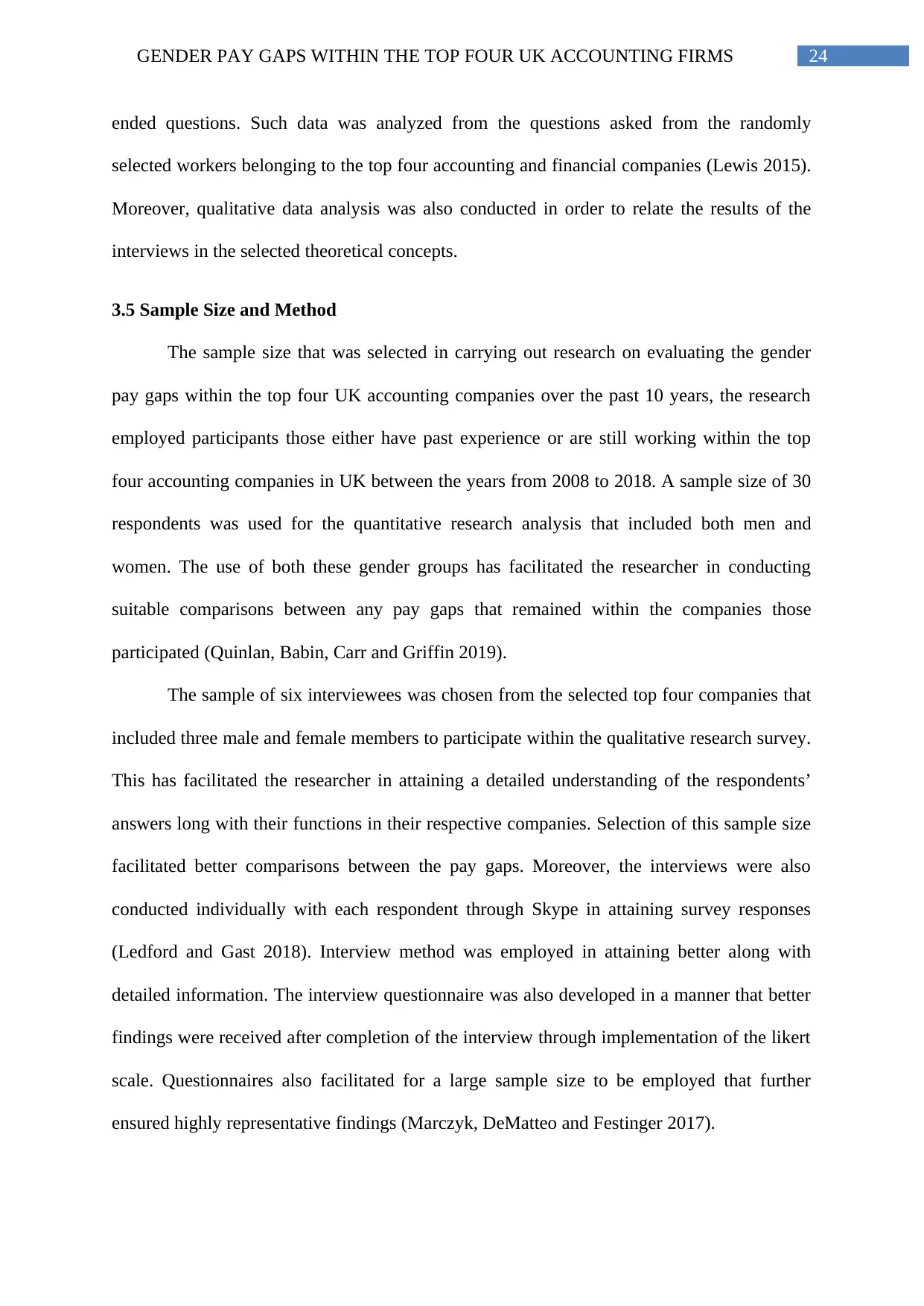
24GENDER PAY GAPS WITHIN THE TOP FOUR UK ACCOUNTING FIRMS
ended questions. Such data was analyzed from the questions asked from the randomly
selected workers belonging to the top four accounting and financial companies (Lewis 2015).
Moreover, qualitative data analysis was also conducted in order to relate the results of the
interviews in the selected theoretical concepts.
3.5 Sample Size and Method
The sample size that was selected in carrying out research on evaluating the gender
pay gaps within the top four UK accounting companies over the past 10 years, the research
employed participants those either have past experience or are still working within the top
four accounting companies in UK between the years from 2008 to 2018. A sample size of 30
respondents was used for the quantitative research analysis that included both men and
women. The use of both these gender groups has facilitated the researcher in conducting
suitable comparisons between any pay gaps that remained within the companies those
participated (Quinlan, Babin, Carr and Griffin 2019).
The sample of six interviewees was chosen from the selected top four companies that
included three male and female members to participate within the qualitative research survey.
This has facilitated the researcher in attaining a detailed understanding of the respondents’
answers long with their functions in their respective companies. Selection of this sample size
facilitated better comparisons between the pay gaps. Moreover, the interviews were also
conducted individually with each respondent through Skype in attaining survey responses
(Ledford and Gast 2018). Interview method was employed in attaining better along with
detailed information. The interview questionnaire was also developed in a manner that better
findings were received after completion of the interview through implementation of the likert
scale. Questionnaires also facilitated for a large sample size to be employed that further
ensured highly representative findings (Marczyk, DeMatteo and Festinger 2017).
ended questions. Such data was analyzed from the questions asked from the randomly
selected workers belonging to the top four accounting and financial companies (Lewis 2015).
Moreover, qualitative data analysis was also conducted in order to relate the results of the
interviews in the selected theoretical concepts.
3.5 Sample Size and Method
The sample size that was selected in carrying out research on evaluating the gender
pay gaps within the top four UK accounting companies over the past 10 years, the research
employed participants those either have past experience or are still working within the top
four accounting companies in UK between the years from 2008 to 2018. A sample size of 30
respondents was used for the quantitative research analysis that included both men and
women. The use of both these gender groups has facilitated the researcher in conducting
suitable comparisons between any pay gaps that remained within the companies those
participated (Quinlan, Babin, Carr and Griffin 2019).
The sample of six interviewees was chosen from the selected top four companies that
included three male and female members to participate within the qualitative research survey.
This has facilitated the researcher in attaining a detailed understanding of the respondents’
answers long with their functions in their respective companies. Selection of this sample size
facilitated better comparisons between the pay gaps. Moreover, the interviews were also
conducted individually with each respondent through Skype in attaining survey responses
(Ledford and Gast 2018). Interview method was employed in attaining better along with
detailed information. The interview questionnaire was also developed in a manner that better
findings were received after completion of the interview through implementation of the likert
scale. Questionnaires also facilitated for a large sample size to be employed that further
ensured highly representative findings (Marczyk, DeMatteo and Festinger 2017).
Paraphrase This Document
Need a fresh take? Get an instant paraphrase of this document with our AI Paraphraser

25GENDER PAY GAPS WITHIN THE TOP FOUR UK ACCOUNTING FIRMS
3.6 Research Strategy
Primary research strategy was employed in this research as in investigating the gender
pay gaps within the top four UK accounting companies over the past 10 years needed
description of primary research as collection of raw data which was sued for a specific
research purpose. Conducting the research on the secondary data was not considered for the
reason of lack of sufficient information on the perceptions of the target respondents (Dang
and Pheng 2015). This makes collection of primary data for analyzing gender gaps within
selected UK accounting companies is deemed to provide most reliable and authentic findings.
3.7 Pilot Study
Pilot study of this research was focused on testing feasibility of the research that was
conducted though developing a pilot questionnaire along with distributing them to a small
group of target respondents. The views and opinions were gathered from the respondents that
were relied on the structure along with questionnaire understanding ability of them (Choy
2014).
3.8 Limitations
The major limitation that was observed in carrying out research on gender pay gaps
within the top four UK accounting companies over the past 10 years was that the sample size
along with the organizations selected did not prove to be the suitable representation of the
population. In addition, the companies within which the respondents were observed to work
did not suitable provide with an appropriate industry representation. For this reason, the
sample selection served as a vital concern in attaining suitable research findings.
3.10 Ethical Consideration
The researcher has followed suitable code of conduct in accomplishing the current
research and performing several tasks are carried out in the data collection process.
3.6 Research Strategy
Primary research strategy was employed in this research as in investigating the gender
pay gaps within the top four UK accounting companies over the past 10 years needed
description of primary research as collection of raw data which was sued for a specific
research purpose. Conducting the research on the secondary data was not considered for the
reason of lack of sufficient information on the perceptions of the target respondents (Dang
and Pheng 2015). This makes collection of primary data for analyzing gender gaps within
selected UK accounting companies is deemed to provide most reliable and authentic findings.
3.7 Pilot Study
Pilot study of this research was focused on testing feasibility of the research that was
conducted though developing a pilot questionnaire along with distributing them to a small
group of target respondents. The views and opinions were gathered from the respondents that
were relied on the structure along with questionnaire understanding ability of them (Choy
2014).
3.8 Limitations
The major limitation that was observed in carrying out research on gender pay gaps
within the top four UK accounting companies over the past 10 years was that the sample size
along with the organizations selected did not prove to be the suitable representation of the
population. In addition, the companies within which the respondents were observed to work
did not suitable provide with an appropriate industry representation. For this reason, the
sample selection served as a vital concern in attaining suitable research findings.
3.10 Ethical Consideration
The researcher has followed suitable code of conduct in accomplishing the current
research and performing several tasks are carried out in the data collection process.

26GENDER PAY GAPS WITHIN THE TOP FOUR UK ACCOUNTING FIRMS
Moreover, in order to maintain transparency of the research, it has been ensured by the
researcher that the secondary data has been gathered from diverse and authentic sources. The
researcher has also avoided asking delicate questions within the survey in order to persuade
the respondents taking part in the survey with mutual permission. It is also ensured by the
researcher that the study is the sole work of the researcher and is devoid of plagiarism.
3.10 Summary
This chapter has outlined techniques in attaining effective opportunities that can
increase research results authenticity. In carrying out research on the gender pay gaps within
the top four UK accounting companies, positivism research paradigm has been employed. In
addition, data collection was conducted in the answers form to the questionnaire that has
facilitated in attaining suitable conclusion from the research
Moreover, in order to maintain transparency of the research, it has been ensured by the
researcher that the secondary data has been gathered from diverse and authentic sources. The
researcher has also avoided asking delicate questions within the survey in order to persuade
the respondents taking part in the survey with mutual permission. It is also ensured by the
researcher that the study is the sole work of the researcher and is devoid of plagiarism.
3.10 Summary
This chapter has outlined techniques in attaining effective opportunities that can
increase research results authenticity. In carrying out research on the gender pay gaps within
the top four UK accounting companies, positivism research paradigm has been employed. In
addition, data collection was conducted in the answers form to the questionnaire that has
facilitated in attaining suitable conclusion from the research
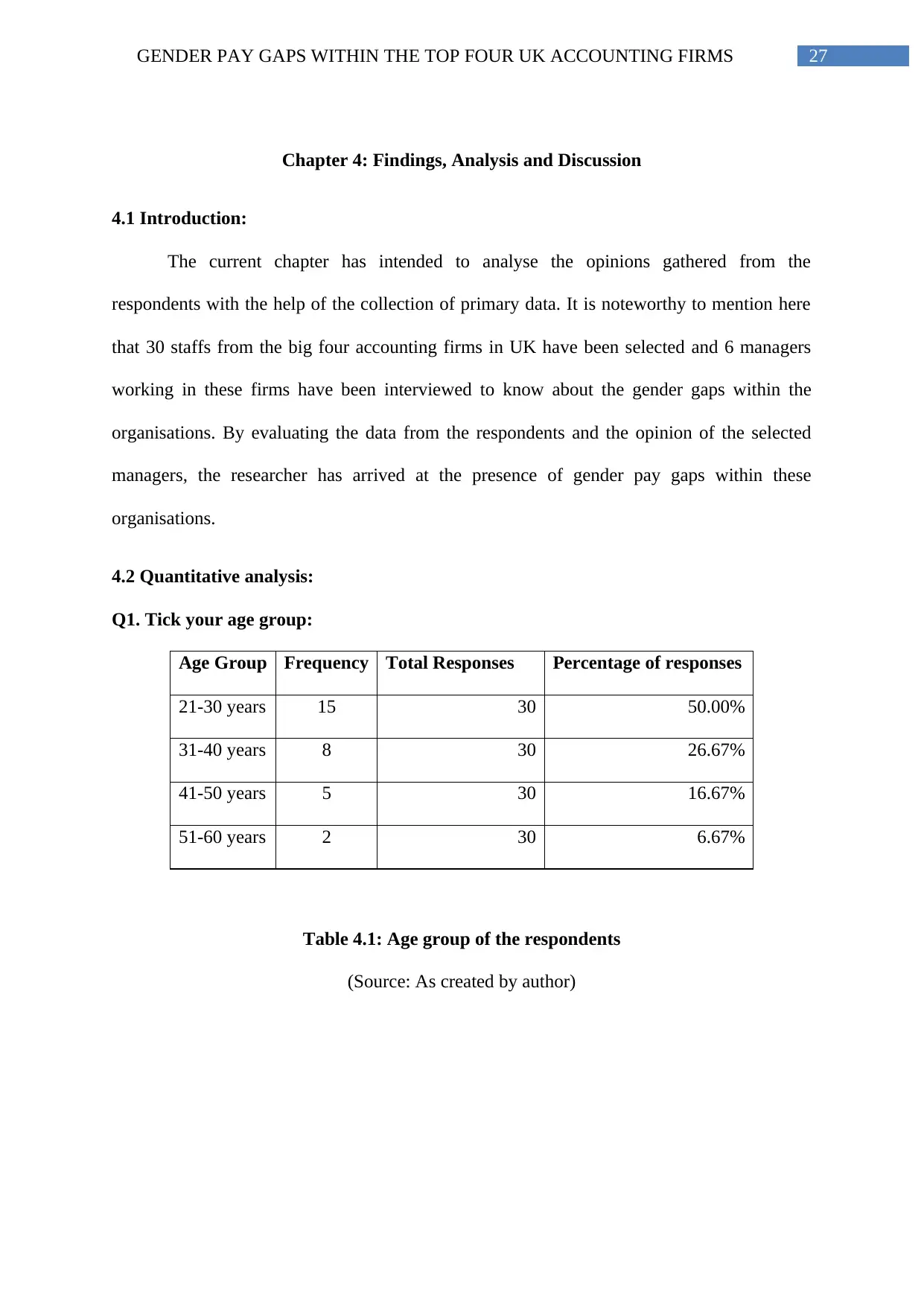
27GENDER PAY GAPS WITHIN THE TOP FOUR UK ACCOUNTING FIRMS
Chapter 4: Findings, Analysis and Discussion
4.1 Introduction:
The current chapter has intended to analyse the opinions gathered from the
respondents with the help of the collection of primary data. It is noteworthy to mention here
that 30 staffs from the big four accounting firms in UK have been selected and 6 managers
working in these firms have been interviewed to know about the gender gaps within the
organisations. By evaluating the data from the respondents and the opinion of the selected
managers, the researcher has arrived at the presence of gender pay gaps within these
organisations.
4.2 Quantitative analysis:
Q1. Tick your age group:
Age Group Frequency Total Responses Percentage of responses
21-30 years 15 30 50.00%
31-40 years 8 30 26.67%
41-50 years 5 30 16.67%
51-60 years 2 30 6.67%
Table 4.1: Age group of the respondents
(Source: As created by author)
Chapter 4: Findings, Analysis and Discussion
4.1 Introduction:
The current chapter has intended to analyse the opinions gathered from the
respondents with the help of the collection of primary data. It is noteworthy to mention here
that 30 staffs from the big four accounting firms in UK have been selected and 6 managers
working in these firms have been interviewed to know about the gender gaps within the
organisations. By evaluating the data from the respondents and the opinion of the selected
managers, the researcher has arrived at the presence of gender pay gaps within these
organisations.
4.2 Quantitative analysis:
Q1. Tick your age group:
Age Group Frequency Total Responses Percentage of responses
21-30 years 15 30 50.00%
31-40 years 8 30 26.67%
41-50 years 5 30 16.67%
51-60 years 2 30 6.67%
Table 4.1: Age group of the respondents
(Source: As created by author)
Secure Best Marks with AI Grader
Need help grading? Try our AI Grader for instant feedback on your assignments.
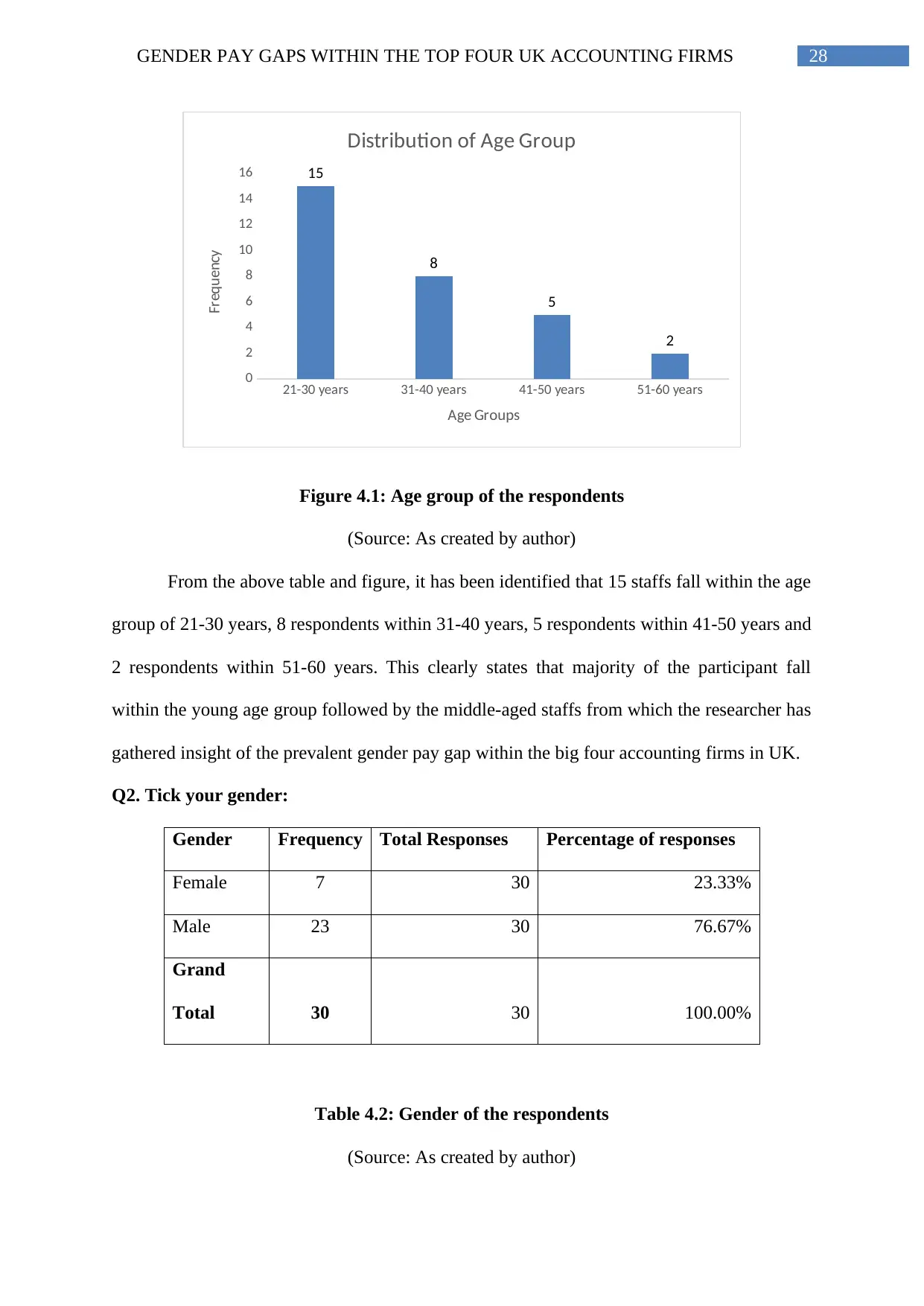
28GENDER PAY GAPS WITHIN THE TOP FOUR UK ACCOUNTING FIRMS
21-30 years 31-40 years 41-50 years 51-60 years
0
2
4
6
8
10
12
14
16 15
8
5
2
Distribution of Age Group
Age Groups
Frequency
Figure 4.1: Age group of the respondents
(Source: As created by author)
From the above table and figure, it has been identified that 15 staffs fall within the age
group of 21-30 years, 8 respondents within 31-40 years, 5 respondents within 41-50 years and
2 respondents within 51-60 years. This clearly states that majority of the participant fall
within the young age group followed by the middle-aged staffs from which the researcher has
gathered insight of the prevalent gender pay gap within the big four accounting firms in UK.
Q2. Tick your gender:
Gender Frequency Total Responses Percentage of responses
Female 7 30 23.33%
Male 23 30 76.67%
Grand
Total 30 30 100.00%
Table 4.2: Gender of the respondents
(Source: As created by author)
21-30 years 31-40 years 41-50 years 51-60 years
0
2
4
6
8
10
12
14
16 15
8
5
2
Distribution of Age Group
Age Groups
Frequency
Figure 4.1: Age group of the respondents
(Source: As created by author)
From the above table and figure, it has been identified that 15 staffs fall within the age
group of 21-30 years, 8 respondents within 31-40 years, 5 respondents within 41-50 years and
2 respondents within 51-60 years. This clearly states that majority of the participant fall
within the young age group followed by the middle-aged staffs from which the researcher has
gathered insight of the prevalent gender pay gap within the big four accounting firms in UK.
Q2. Tick your gender:
Gender Frequency Total Responses Percentage of responses
Female 7 30 23.33%
Male 23 30 76.67%
Grand
Total 30 30 100.00%
Table 4.2: Gender of the respondents
(Source: As created by author)
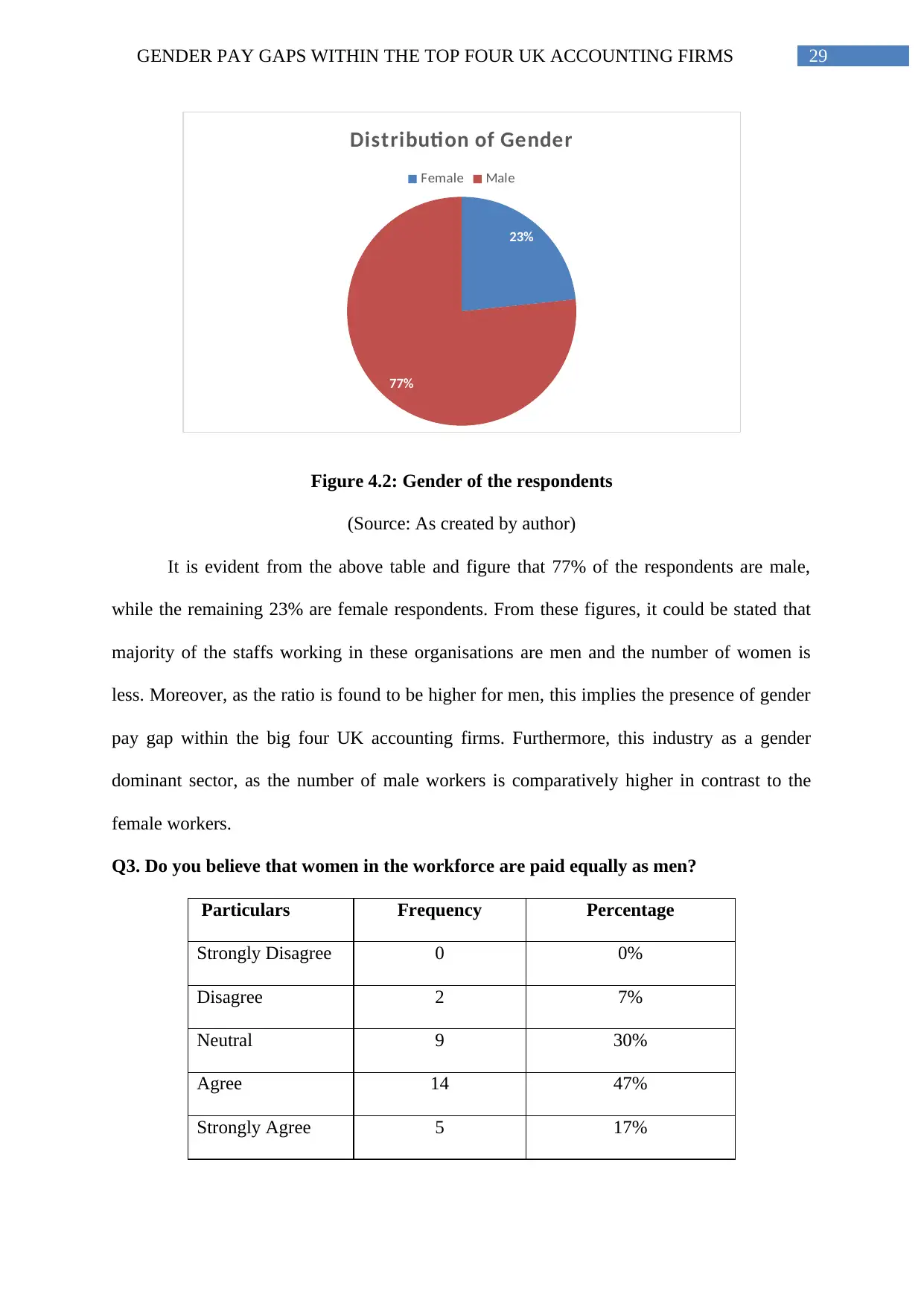
29GENDER PAY GAPS WITHIN THE TOP FOUR UK ACCOUNTING FIRMS
23%
77%
Distribution of Gender
Female Male
Figure 4.2: Gender of the respondents
(Source: As created by author)
It is evident from the above table and figure that 77% of the respondents are male,
while the remaining 23% are female respondents. From these figures, it could be stated that
majority of the staffs working in these organisations are men and the number of women is
less. Moreover, as the ratio is found to be higher for men, this implies the presence of gender
pay gap within the big four UK accounting firms. Furthermore, this industry as a gender
dominant sector, as the number of male workers is comparatively higher in contrast to the
female workers.
Q3. Do you believe that women in the workforce are paid equally as men?
Particulars Frequency Percentage
Strongly Disagree 0 0%
Disagree 2 7%
Neutral 9 30%
Agree 14 47%
Strongly Agree 5 17%
23%
77%
Distribution of Gender
Female Male
Figure 4.2: Gender of the respondents
(Source: As created by author)
It is evident from the above table and figure that 77% of the respondents are male,
while the remaining 23% are female respondents. From these figures, it could be stated that
majority of the staffs working in these organisations are men and the number of women is
less. Moreover, as the ratio is found to be higher for men, this implies the presence of gender
pay gap within the big four UK accounting firms. Furthermore, this industry as a gender
dominant sector, as the number of male workers is comparatively higher in contrast to the
female workers.
Q3. Do you believe that women in the workforce are paid equally as men?
Particulars Frequency Percentage
Strongly Disagree 0 0%
Disagree 2 7%
Neutral 9 30%
Agree 14 47%
Strongly Agree 5 17%
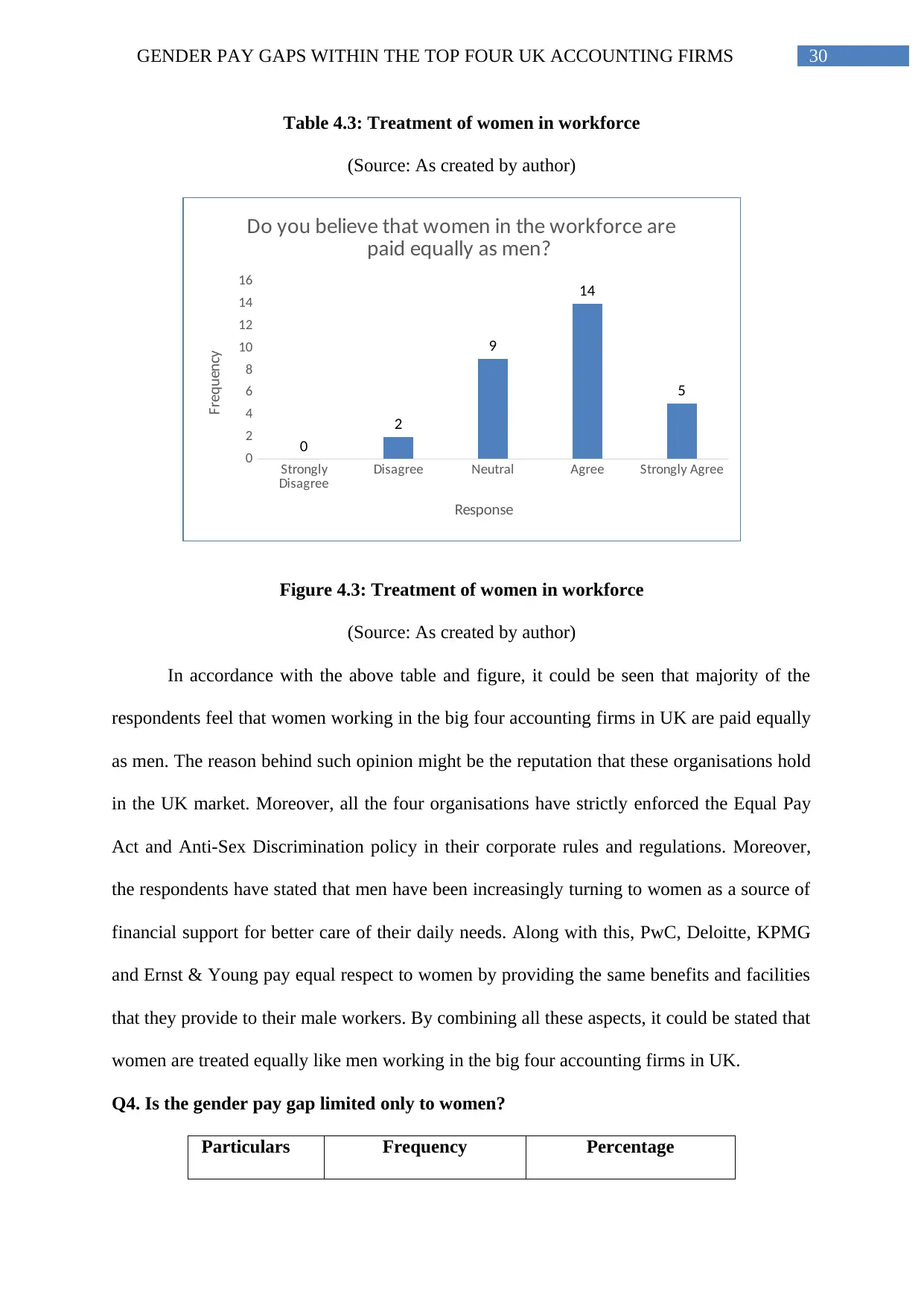
30GENDER PAY GAPS WITHIN THE TOP FOUR UK ACCOUNTING FIRMS
Table 4.3: Treatment of women in workforce
(Source: As created by author)
Strongly
Disagree Disagree Neutral Agree Strongly Agree
0
2
4
6
8
10
12
14
16
0
2
9
14
5
Do you believe that women in the workforce are
paid equally as men?
Response
Frequency
Figure 4.3: Treatment of women in workforce
(Source: As created by author)
In accordance with the above table and figure, it could be seen that majority of the
respondents feel that women working in the big four accounting firms in UK are paid equally
as men. The reason behind such opinion might be the reputation that these organisations hold
in the UK market. Moreover, all the four organisations have strictly enforced the Equal Pay
Act and Anti-Sex Discrimination policy in their corporate rules and regulations. Moreover,
the respondents have stated that men have been increasingly turning to women as a source of
financial support for better care of their daily needs. Along with this, PwC, Deloitte, KPMG
and Ernst & Young pay equal respect to women by providing the same benefits and facilities
that they provide to their male workers. By combining all these aspects, it could be stated that
women are treated equally like men working in the big four accounting firms in UK.
Q4. Is the gender pay gap limited only to women?
Particulars Frequency Percentage
Table 4.3: Treatment of women in workforce
(Source: As created by author)
Strongly
Disagree Disagree Neutral Agree Strongly Agree
0
2
4
6
8
10
12
14
16
0
2
9
14
5
Do you believe that women in the workforce are
paid equally as men?
Response
Frequency
Figure 4.3: Treatment of women in workforce
(Source: As created by author)
In accordance with the above table and figure, it could be seen that majority of the
respondents feel that women working in the big four accounting firms in UK are paid equally
as men. The reason behind such opinion might be the reputation that these organisations hold
in the UK market. Moreover, all the four organisations have strictly enforced the Equal Pay
Act and Anti-Sex Discrimination policy in their corporate rules and regulations. Moreover,
the respondents have stated that men have been increasingly turning to women as a source of
financial support for better care of their daily needs. Along with this, PwC, Deloitte, KPMG
and Ernst & Young pay equal respect to women by providing the same benefits and facilities
that they provide to their male workers. By combining all these aspects, it could be stated that
women are treated equally like men working in the big four accounting firms in UK.
Q4. Is the gender pay gap limited only to women?
Particulars Frequency Percentage
Paraphrase This Document
Need a fresh take? Get an instant paraphrase of this document with our AI Paraphraser

31GENDER PAY GAPS WITHIN THE TOP FOUR UK ACCOUNTING FIRMS
Strongly
Disagree 0 0%
Disagree 3 10%
Neutral 5 17%
Agree 14 47%
Strongly Agree 8 27%
Table 4.4: Limitation of gender pay gap to women
(Source: As created by author)
Strongly
Disagree Disagree Neutral Agree Strongly Agree
0
2
4
6
8
10
12
14
16
0
3
5
14
8
Is the gender pay gap limited only to women?
Response
Frequency
Figure 4.4: Limitation of gender pay gap to women
(Source: As created by author)
It could be witnessed from the above table and figure that 74% of the respondents feel
that gender pay gap are limited to women. Although they have stated in the previous question
that women are treated equally as men in terms of payout and other facilities, the
organisations mainly recruit more male employees compared to women employees. One of
the primary reasons behind this is that accounting profession is chosen mostly by men in
Strongly
Disagree 0 0%
Disagree 3 10%
Neutral 5 17%
Agree 14 47%
Strongly Agree 8 27%
Table 4.4: Limitation of gender pay gap to women
(Source: As created by author)
Strongly
Disagree Disagree Neutral Agree Strongly Agree
0
2
4
6
8
10
12
14
16
0
3
5
14
8
Is the gender pay gap limited only to women?
Response
Frequency
Figure 4.4: Limitation of gender pay gap to women
(Source: As created by author)
It could be witnessed from the above table and figure that 74% of the respondents feel
that gender pay gap are limited to women. Although they have stated in the previous question
that women are treated equally as men in terms of payout and other facilities, the
organisations mainly recruit more male employees compared to women employees. One of
the primary reasons behind this is that accounting profession is chosen mostly by men in
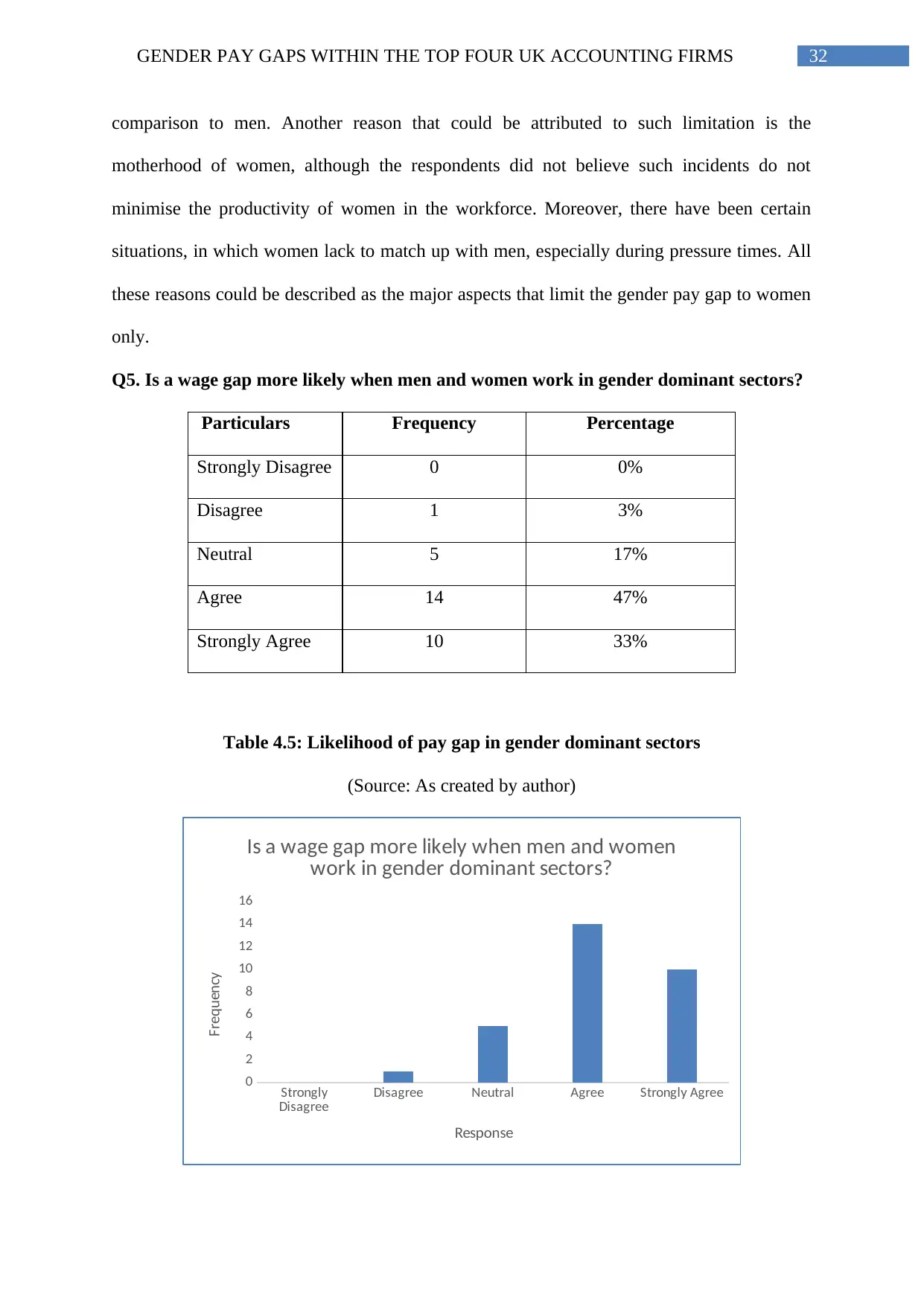
32GENDER PAY GAPS WITHIN THE TOP FOUR UK ACCOUNTING FIRMS
comparison to men. Another reason that could be attributed to such limitation is the
motherhood of women, although the respondents did not believe such incidents do not
minimise the productivity of women in the workforce. Moreover, there have been certain
situations, in which women lack to match up with men, especially during pressure times. All
these reasons could be described as the major aspects that limit the gender pay gap to women
only.
Q5. Is a wage gap more likely when men and women work in gender dominant sectors?
Particulars Frequency Percentage
Strongly Disagree 0 0%
Disagree 1 3%
Neutral 5 17%
Agree 14 47%
Strongly Agree 10 33%
Table 4.5: Likelihood of pay gap in gender dominant sectors
(Source: As created by author)
Strongly
Disagree Disagree Neutral Agree Strongly Agree
0
2
4
6
8
10
12
14
16
Is a wage gap more likely when men and women
work in gender dominant sectors?
Response
Frequency
comparison to men. Another reason that could be attributed to such limitation is the
motherhood of women, although the respondents did not believe such incidents do not
minimise the productivity of women in the workforce. Moreover, there have been certain
situations, in which women lack to match up with men, especially during pressure times. All
these reasons could be described as the major aspects that limit the gender pay gap to women
only.
Q5. Is a wage gap more likely when men and women work in gender dominant sectors?
Particulars Frequency Percentage
Strongly Disagree 0 0%
Disagree 1 3%
Neutral 5 17%
Agree 14 47%
Strongly Agree 10 33%
Table 4.5: Likelihood of pay gap in gender dominant sectors
(Source: As created by author)
Strongly
Disagree Disagree Neutral Agree Strongly Agree
0
2
4
6
8
10
12
14
16
Is a wage gap more likely when men and women
work in gender dominant sectors?
Response
Frequency
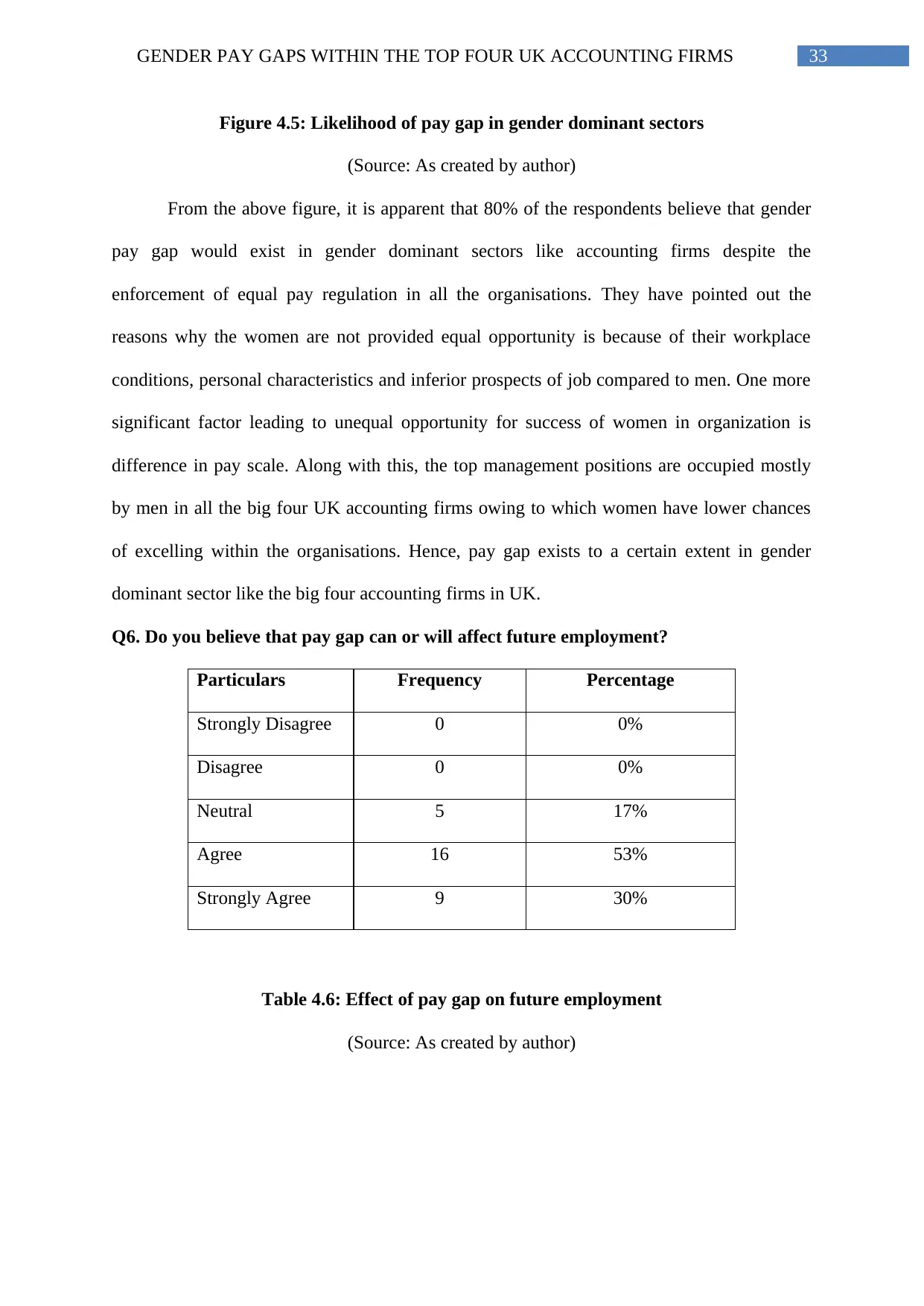
33GENDER PAY GAPS WITHIN THE TOP FOUR UK ACCOUNTING FIRMS
Figure 4.5: Likelihood of pay gap in gender dominant sectors
(Source: As created by author)
From the above figure, it is apparent that 80% of the respondents believe that gender
pay gap would exist in gender dominant sectors like accounting firms despite the
enforcement of equal pay regulation in all the organisations. They have pointed out the
reasons why the women are not provided equal opportunity is because of their workplace
conditions, personal characteristics and inferior prospects of job compared to men. One more
significant factor leading to unequal opportunity for success of women in organization is
difference in pay scale. Along with this, the top management positions are occupied mostly
by men in all the big four UK accounting firms owing to which women have lower chances
of excelling within the organisations. Hence, pay gap exists to a certain extent in gender
dominant sector like the big four accounting firms in UK.
Q6. Do you believe that pay gap can or will affect future employment?
Particulars Frequency Percentage
Strongly Disagree 0 0%
Disagree 0 0%
Neutral 5 17%
Agree 16 53%
Strongly Agree 9 30%
Table 4.6: Effect of pay gap on future employment
(Source: As created by author)
Figure 4.5: Likelihood of pay gap in gender dominant sectors
(Source: As created by author)
From the above figure, it is apparent that 80% of the respondents believe that gender
pay gap would exist in gender dominant sectors like accounting firms despite the
enforcement of equal pay regulation in all the organisations. They have pointed out the
reasons why the women are not provided equal opportunity is because of their workplace
conditions, personal characteristics and inferior prospects of job compared to men. One more
significant factor leading to unequal opportunity for success of women in organization is
difference in pay scale. Along with this, the top management positions are occupied mostly
by men in all the big four UK accounting firms owing to which women have lower chances
of excelling within the organisations. Hence, pay gap exists to a certain extent in gender
dominant sector like the big four accounting firms in UK.
Q6. Do you believe that pay gap can or will affect future employment?
Particulars Frequency Percentage
Strongly Disagree 0 0%
Disagree 0 0%
Neutral 5 17%
Agree 16 53%
Strongly Agree 9 30%
Table 4.6: Effect of pay gap on future employment
(Source: As created by author)
Secure Best Marks with AI Grader
Need help grading? Try our AI Grader for instant feedback on your assignments.
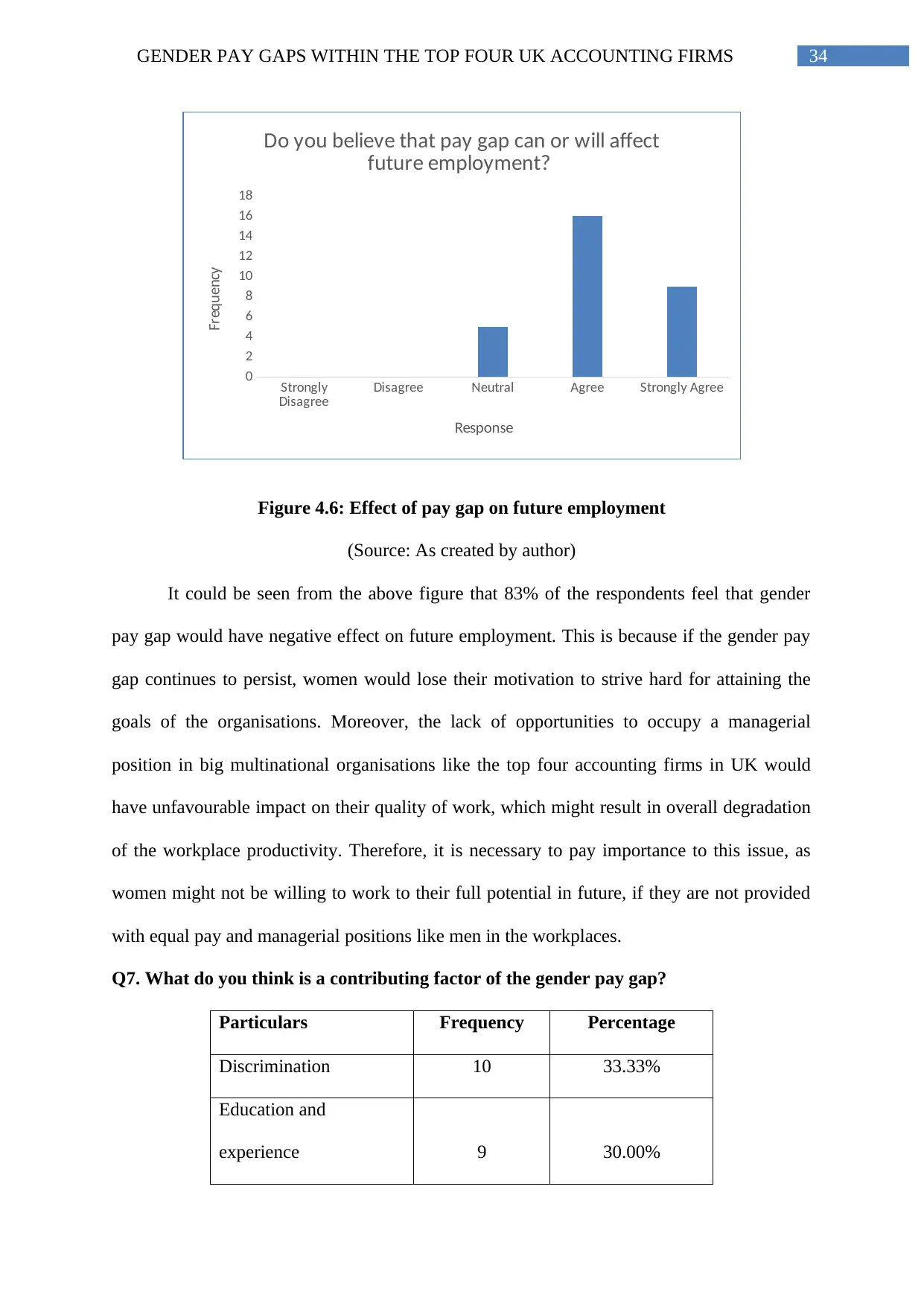
34GENDER PAY GAPS WITHIN THE TOP FOUR UK ACCOUNTING FIRMS
Strongly
Disagree Disagree Neutral Agree Strongly Agree
0
2
4
6
8
10
12
14
16
18
Do you believe that pay gap can or will affect
future employment?
Response
Frequency
Figure 4.6: Effect of pay gap on future employment
(Source: As created by author)
It could be seen from the above figure that 83% of the respondents feel that gender
pay gap would have negative effect on future employment. This is because if the gender pay
gap continues to persist, women would lose their motivation to strive hard for attaining the
goals of the organisations. Moreover, the lack of opportunities to occupy a managerial
position in big multinational organisations like the top four accounting firms in UK would
have unfavourable impact on their quality of work, which might result in overall degradation
of the workplace productivity. Therefore, it is necessary to pay importance to this issue, as
women might not be willing to work to their full potential in future, if they are not provided
with equal pay and managerial positions like men in the workplaces.
Q7. What do you think is a contributing factor of the gender pay gap?
Particulars Frequency Percentage
Discrimination 10 33.33%
Education and
experience 9 30.00%
Strongly
Disagree Disagree Neutral Agree Strongly Agree
0
2
4
6
8
10
12
14
16
18
Do you believe that pay gap can or will affect
future employment?
Response
Frequency
Figure 4.6: Effect of pay gap on future employment
(Source: As created by author)
It could be seen from the above figure that 83% of the respondents feel that gender
pay gap would have negative effect on future employment. This is because if the gender pay
gap continues to persist, women would lose their motivation to strive hard for attaining the
goals of the organisations. Moreover, the lack of opportunities to occupy a managerial
position in big multinational organisations like the top four accounting firms in UK would
have unfavourable impact on their quality of work, which might result in overall degradation
of the workplace productivity. Therefore, it is necessary to pay importance to this issue, as
women might not be willing to work to their full potential in future, if they are not provided
with equal pay and managerial positions like men in the workplaces.
Q7. What do you think is a contributing factor of the gender pay gap?
Particulars Frequency Percentage
Discrimination 10 33.33%
Education and
experience 9 30.00%
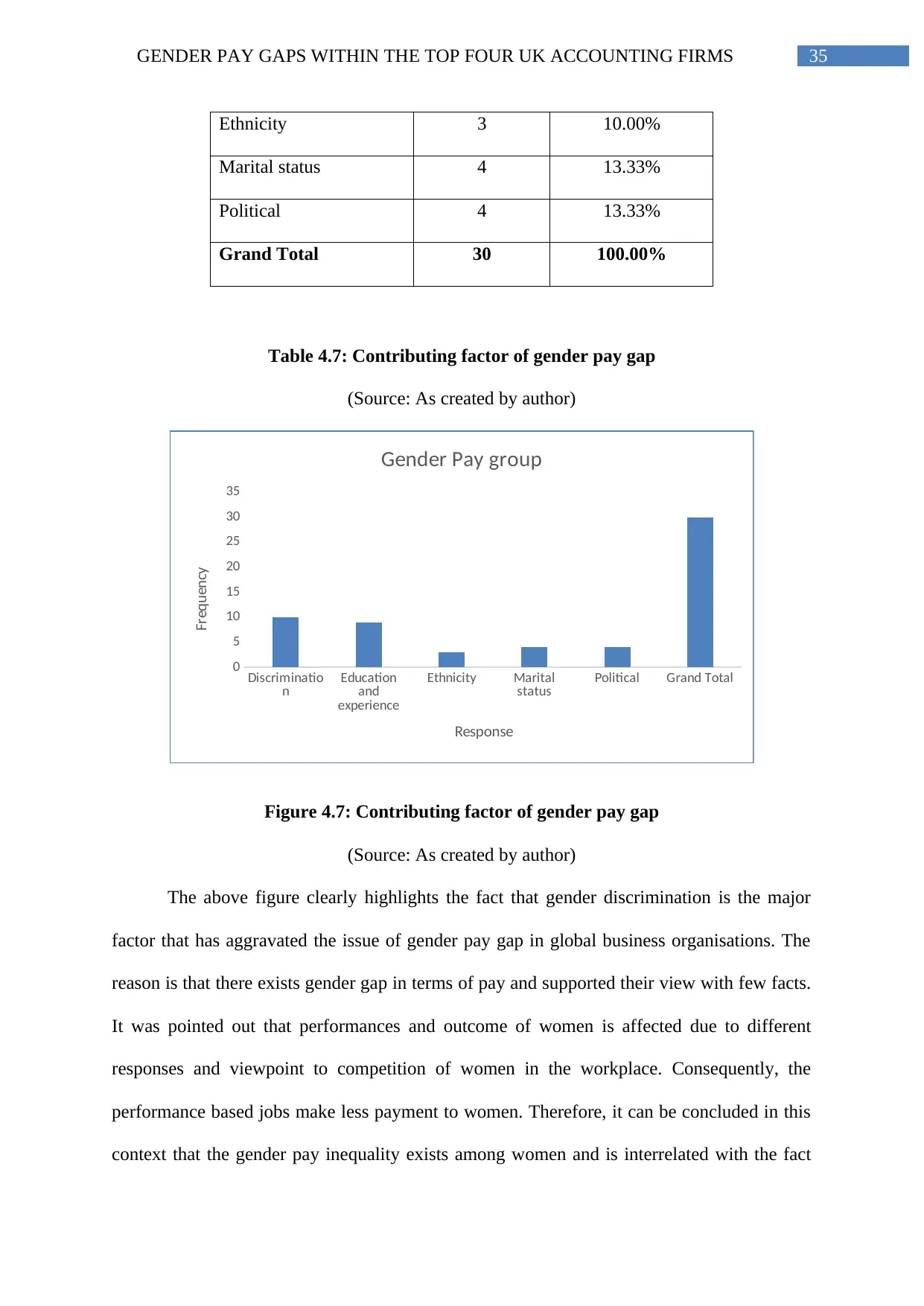
35GENDER PAY GAPS WITHIN THE TOP FOUR UK ACCOUNTING FIRMS
Ethnicity 3 10.00%
Marital status 4 13.33%
Political 4 13.33%
Grand Total 30 100.00%
Table 4.7: Contributing factor of gender pay gap
(Source: As created by author)
Discriminatio
n Education
and
experience
Ethnicity Marital
status Political Grand Total
0
5
10
15
20
25
30
35
Gender Pay group
Response
Frequency
Figure 4.7: Contributing factor of gender pay gap
(Source: As created by author)
The above figure clearly highlights the fact that gender discrimination is the major
factor that has aggravated the issue of gender pay gap in global business organisations. The
reason is that there exists gender gap in terms of pay and supported their view with few facts.
It was pointed out that performances and outcome of women is affected due to different
responses and viewpoint to competition of women in the workplace. Consequently, the
performance based jobs make less payment to women. Therefore, it can be concluded in this
context that the gender pay inequality exists among women and is interrelated with the fact
Ethnicity 3 10.00%
Marital status 4 13.33%
Political 4 13.33%
Grand Total 30 100.00%
Table 4.7: Contributing factor of gender pay gap
(Source: As created by author)
Discriminatio
n Education
and
experience
Ethnicity Marital
status Political Grand Total
0
5
10
15
20
25
30
35
Gender Pay group
Response
Frequency
Figure 4.7: Contributing factor of gender pay gap
(Source: As created by author)
The above figure clearly highlights the fact that gender discrimination is the major
factor that has aggravated the issue of gender pay gap in global business organisations. The
reason is that there exists gender gap in terms of pay and supported their view with few facts.
It was pointed out that performances and outcome of women is affected due to different
responses and viewpoint to competition of women in the workplace. Consequently, the
performance based jobs make less payment to women. Therefore, it can be concluded in this
context that the gender pay inequality exists among women and is interrelated with the fact
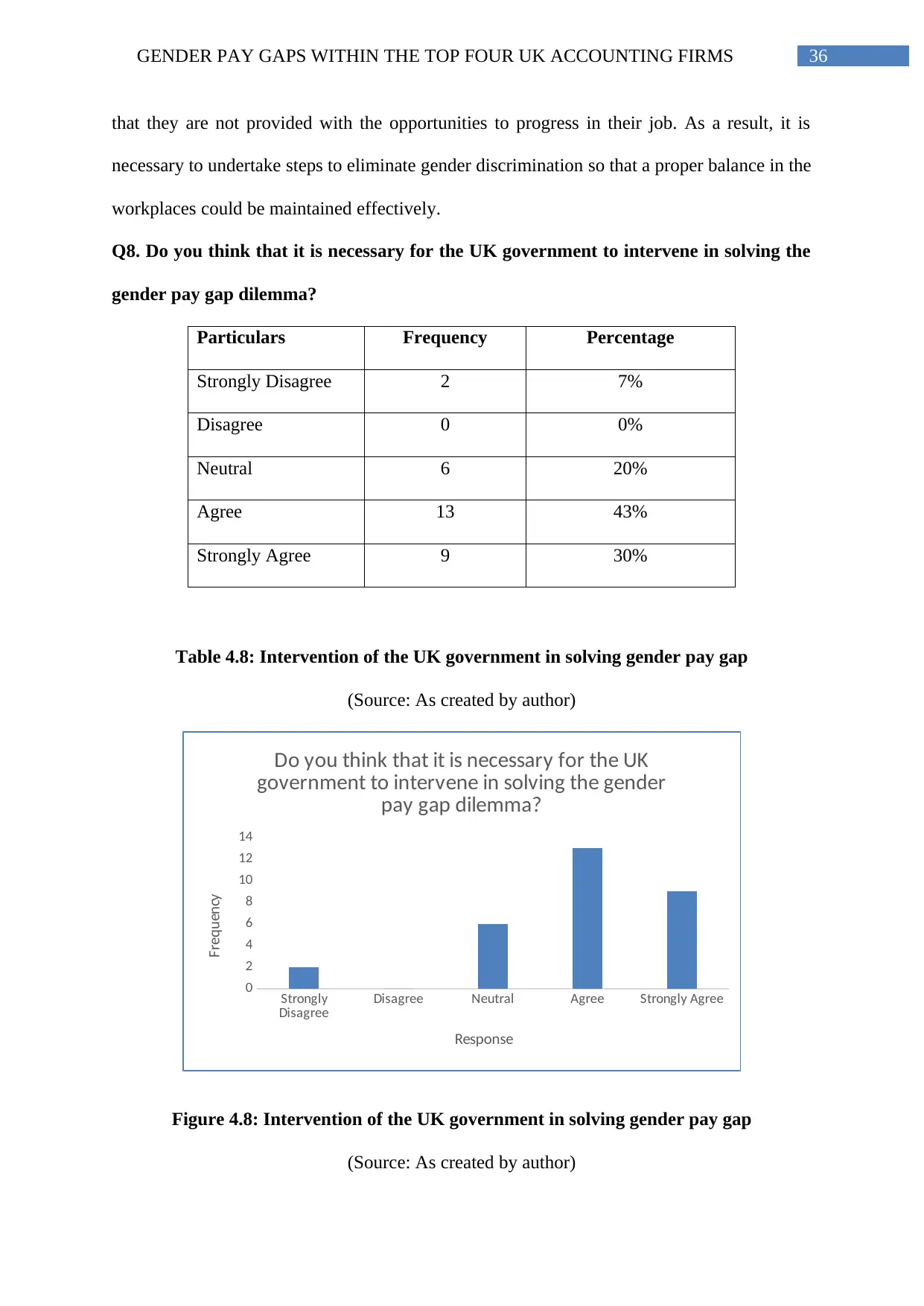
36GENDER PAY GAPS WITHIN THE TOP FOUR UK ACCOUNTING FIRMS
that they are not provided with the opportunities to progress in their job. As a result, it is
necessary to undertake steps to eliminate gender discrimination so that a proper balance in the
workplaces could be maintained effectively.
Q8. Do you think that it is necessary for the UK government to intervene in solving the
gender pay gap dilemma?
Particulars Frequency Percentage
Strongly Disagree 2 7%
Disagree 0 0%
Neutral 6 20%
Agree 13 43%
Strongly Agree 9 30%
Table 4.8: Intervention of the UK government in solving gender pay gap
(Source: As created by author)
Strongly
Disagree Disagree Neutral Agree Strongly Agree
0
2
4
6
8
10
12
14
Do you think that it is necessary for the UK
government to intervene in solving the gender
pay gap dilemma?
Response
Frequency
Figure 4.8: Intervention of the UK government in solving gender pay gap
(Source: As created by author)
that they are not provided with the opportunities to progress in their job. As a result, it is
necessary to undertake steps to eliminate gender discrimination so that a proper balance in the
workplaces could be maintained effectively.
Q8. Do you think that it is necessary for the UK government to intervene in solving the
gender pay gap dilemma?
Particulars Frequency Percentage
Strongly Disagree 2 7%
Disagree 0 0%
Neutral 6 20%
Agree 13 43%
Strongly Agree 9 30%
Table 4.8: Intervention of the UK government in solving gender pay gap
(Source: As created by author)
Strongly
Disagree Disagree Neutral Agree Strongly Agree
0
2
4
6
8
10
12
14
Do you think that it is necessary for the UK
government to intervene in solving the gender
pay gap dilemma?
Response
Frequency
Figure 4.8: Intervention of the UK government in solving gender pay gap
(Source: As created by author)
Paraphrase This Document
Need a fresh take? Get an instant paraphrase of this document with our AI Paraphraser
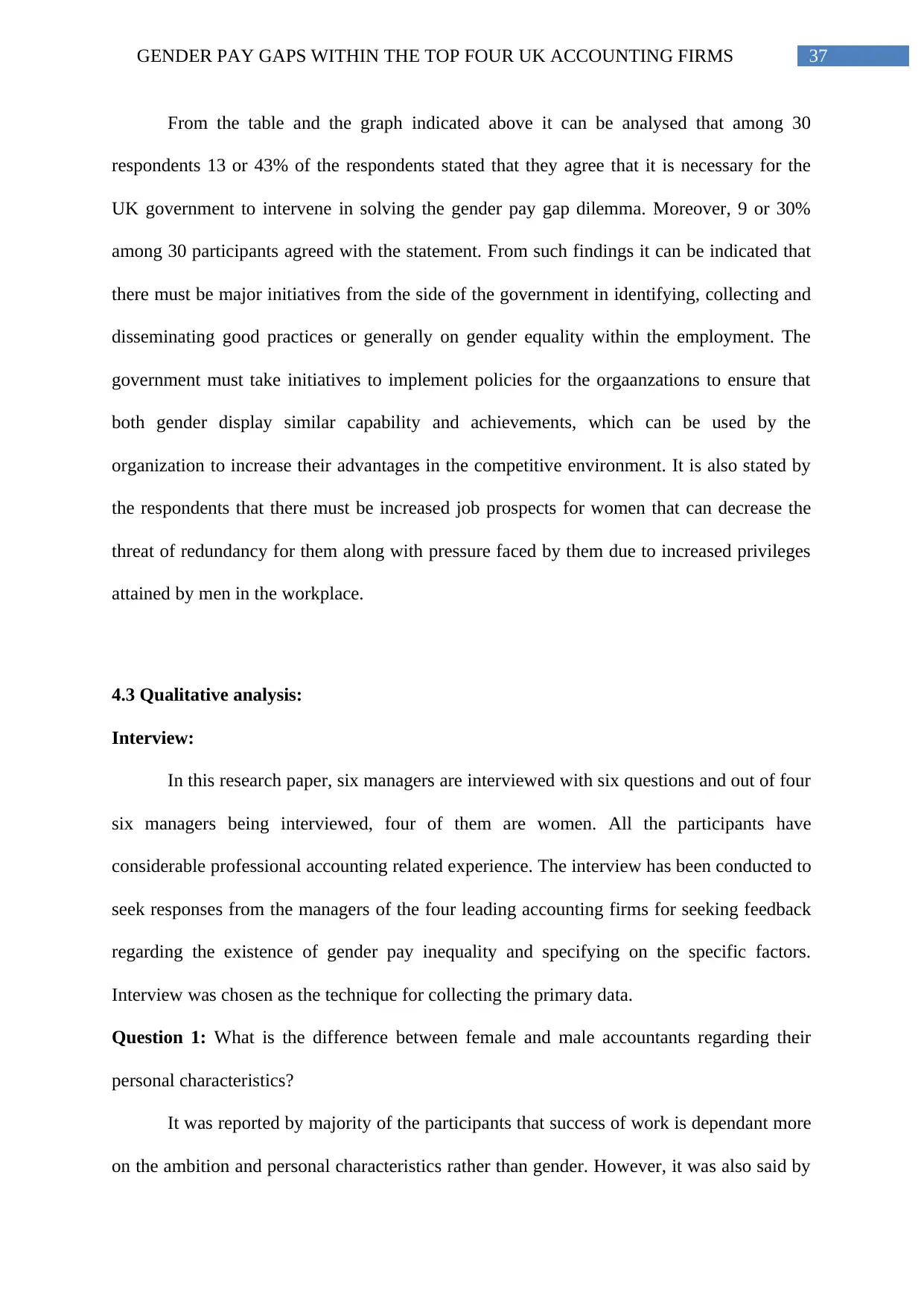
37GENDER PAY GAPS WITHIN THE TOP FOUR UK ACCOUNTING FIRMS
From the table and the graph indicated above it can be analysed that among 30
respondents 13 or 43% of the respondents stated that they agree that it is necessary for the
UK government to intervene in solving the gender pay gap dilemma. Moreover, 9 or 30%
among 30 participants agreed with the statement. From such findings it can be indicated that
there must be major initiatives from the side of the government in identifying, collecting and
disseminating good practices or generally on gender equality within the employment. The
government must take initiatives to implement policies for the orgaanzations to ensure that
both gender display similar capability and achievements, which can be used by the
organization to increase their advantages in the competitive environment. It is also stated by
the respondents that there must be increased job prospects for women that can decrease the
threat of redundancy for them along with pressure faced by them due to increased privileges
attained by men in the workplace.
4.3 Qualitative analysis:
Interview:
In this research paper, six managers are interviewed with six questions and out of four
six managers being interviewed, four of them are women. All the participants have
considerable professional accounting related experience. The interview has been conducted to
seek responses from the managers of the four leading accounting firms for seeking feedback
regarding the existence of gender pay inequality and specifying on the specific factors.
Interview was chosen as the technique for collecting the primary data.
Question 1: What is the difference between female and male accountants regarding their
personal characteristics?
It was reported by majority of the participants that success of work is dependant more
on the ambition and personal characteristics rather than gender. However, it was also said by
From the table and the graph indicated above it can be analysed that among 30
respondents 13 or 43% of the respondents stated that they agree that it is necessary for the
UK government to intervene in solving the gender pay gap dilemma. Moreover, 9 or 30%
among 30 participants agreed with the statement. From such findings it can be indicated that
there must be major initiatives from the side of the government in identifying, collecting and
disseminating good practices or generally on gender equality within the employment. The
government must take initiatives to implement policies for the orgaanzations to ensure that
both gender display similar capability and achievements, which can be used by the
organization to increase their advantages in the competitive environment. It is also stated by
the respondents that there must be increased job prospects for women that can decrease the
threat of redundancy for them along with pressure faced by them due to increased privileges
attained by men in the workplace.
4.3 Qualitative analysis:
Interview:
In this research paper, six managers are interviewed with six questions and out of four
six managers being interviewed, four of them are women. All the participants have
considerable professional accounting related experience. The interview has been conducted to
seek responses from the managers of the four leading accounting firms for seeking feedback
regarding the existence of gender pay inequality and specifying on the specific factors.
Interview was chosen as the technique for collecting the primary data.
Question 1: What is the difference between female and male accountants regarding their
personal characteristics?
It was reported by majority of the participants that success of work is dependant more
on the ambition and personal characteristics rather than gender. However, it was also said by
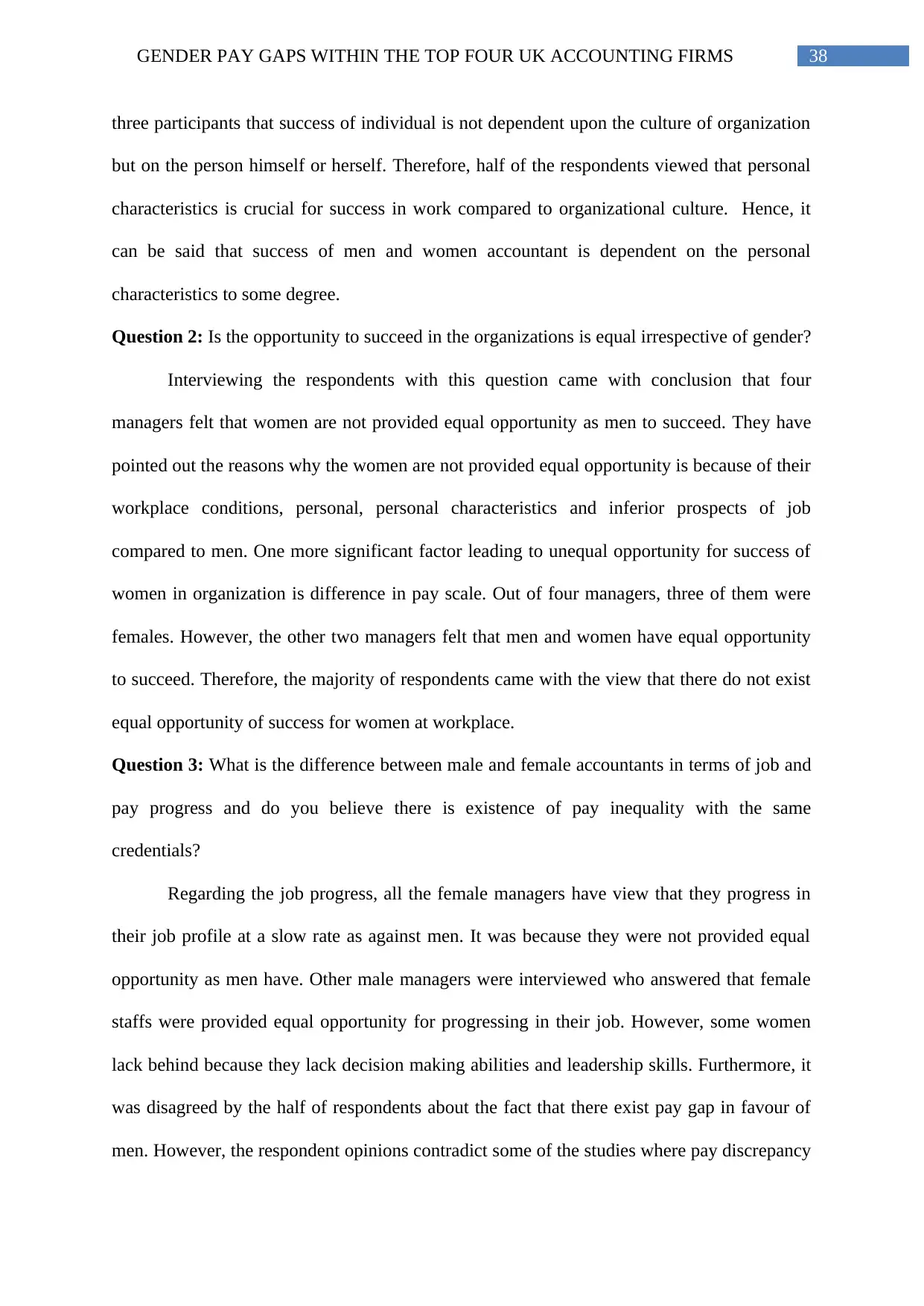
38GENDER PAY GAPS WITHIN THE TOP FOUR UK ACCOUNTING FIRMS
three participants that success of individual is not dependent upon the culture of organization
but on the person himself or herself. Therefore, half of the respondents viewed that personal
characteristics is crucial for success in work compared to organizational culture. Hence, it
can be said that success of men and women accountant is dependent on the personal
characteristics to some degree.
Question 2: Is the opportunity to succeed in the organizations is equal irrespective of gender?
Interviewing the respondents with this question came with conclusion that four
managers felt that women are not provided equal opportunity as men to succeed. They have
pointed out the reasons why the women are not provided equal opportunity is because of their
workplace conditions, personal, personal characteristics and inferior prospects of job
compared to men. One more significant factor leading to unequal opportunity for success of
women in organization is difference in pay scale. Out of four managers, three of them were
females. However, the other two managers felt that men and women have equal opportunity
to succeed. Therefore, the majority of respondents came with the view that there do not exist
equal opportunity of success for women at workplace.
Question 3: What is the difference between male and female accountants in terms of job and
pay progress and do you believe there is existence of pay inequality with the same
credentials?
Regarding the job progress, all the female managers have view that they progress in
their job profile at a slow rate as against men. It was because they were not provided equal
opportunity as men have. Other male managers were interviewed who answered that female
staffs were provided equal opportunity for progressing in their job. However, some women
lack behind because they lack decision making abilities and leadership skills. Furthermore, it
was disagreed by the half of respondents about the fact that there exist pay gap in favour of
men. However, the respondent opinions contradict some of the studies where pay discrepancy
three participants that success of individual is not dependent upon the culture of organization
but on the person himself or herself. Therefore, half of the respondents viewed that personal
characteristics is crucial for success in work compared to organizational culture. Hence, it
can be said that success of men and women accountant is dependent on the personal
characteristics to some degree.
Question 2: Is the opportunity to succeed in the organizations is equal irrespective of gender?
Interviewing the respondents with this question came with conclusion that four
managers felt that women are not provided equal opportunity as men to succeed. They have
pointed out the reasons why the women are not provided equal opportunity is because of their
workplace conditions, personal, personal characteristics and inferior prospects of job
compared to men. One more significant factor leading to unequal opportunity for success of
women in organization is difference in pay scale. Out of four managers, three of them were
females. However, the other two managers felt that men and women have equal opportunity
to succeed. Therefore, the majority of respondents came with the view that there do not exist
equal opportunity of success for women at workplace.
Question 3: What is the difference between male and female accountants in terms of job and
pay progress and do you believe there is existence of pay inequality with the same
credentials?
Regarding the job progress, all the female managers have view that they progress in
their job profile at a slow rate as against men. It was because they were not provided equal
opportunity as men have. Other male managers were interviewed who answered that female
staffs were provided equal opportunity for progressing in their job. However, some women
lack behind because they lack decision making abilities and leadership skills. Furthermore, it
was disagreed by the half of respondents about the fact that there exist pay gap in favour of
men. However, the respondent opinions contradict some of the studies where pay discrepancy
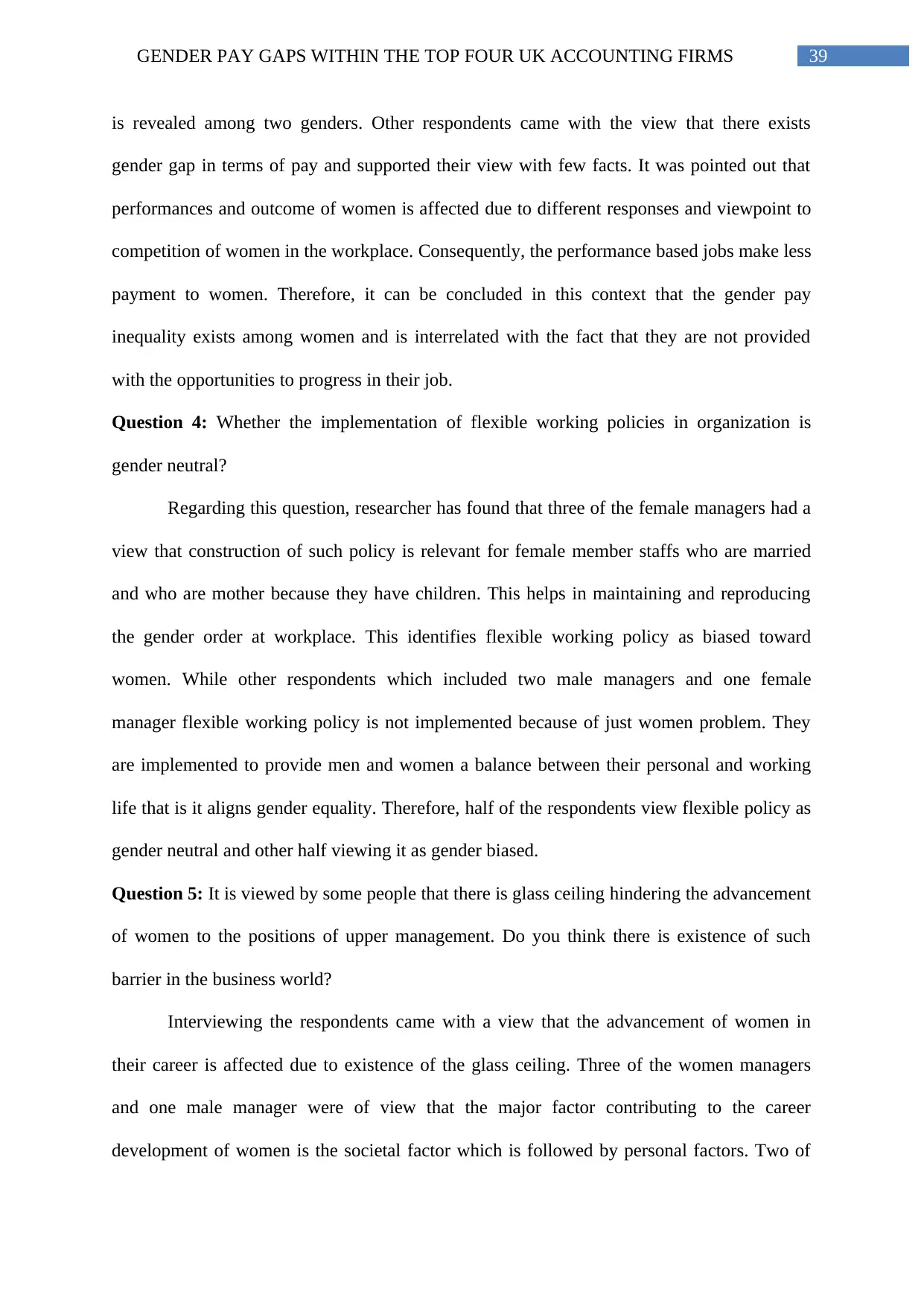
39GENDER PAY GAPS WITHIN THE TOP FOUR UK ACCOUNTING FIRMS
is revealed among two genders. Other respondents came with the view that there exists
gender gap in terms of pay and supported their view with few facts. It was pointed out that
performances and outcome of women is affected due to different responses and viewpoint to
competition of women in the workplace. Consequently, the performance based jobs make less
payment to women. Therefore, it can be concluded in this context that the gender pay
inequality exists among women and is interrelated with the fact that they are not provided
with the opportunities to progress in their job.
Question 4: Whether the implementation of flexible working policies in organization is
gender neutral?
Regarding this question, researcher has found that three of the female managers had a
view that construction of such policy is relevant for female member staffs who are married
and who are mother because they have children. This helps in maintaining and reproducing
the gender order at workplace. This identifies flexible working policy as biased toward
women. While other respondents which included two male managers and one female
manager flexible working policy is not implemented because of just women problem. They
are implemented to provide men and women a balance between their personal and working
life that is it aligns gender equality. Therefore, half of the respondents view flexible policy as
gender neutral and other half viewing it as gender biased.
Question 5: It is viewed by some people that there is glass ceiling hindering the advancement
of women to the positions of upper management. Do you think there is existence of such
barrier in the business world?
Interviewing the respondents came with a view that the advancement of women in
their career is affected due to existence of the glass ceiling. Three of the women managers
and one male manager were of view that the major factor contributing to the career
development of women is the societal factor which is followed by personal factors. Two of
is revealed among two genders. Other respondents came with the view that there exists
gender gap in terms of pay and supported their view with few facts. It was pointed out that
performances and outcome of women is affected due to different responses and viewpoint to
competition of women in the workplace. Consequently, the performance based jobs make less
payment to women. Therefore, it can be concluded in this context that the gender pay
inequality exists among women and is interrelated with the fact that they are not provided
with the opportunities to progress in their job.
Question 4: Whether the implementation of flexible working policies in organization is
gender neutral?
Regarding this question, researcher has found that three of the female managers had a
view that construction of such policy is relevant for female member staffs who are married
and who are mother because they have children. This helps in maintaining and reproducing
the gender order at workplace. This identifies flexible working policy as biased toward
women. While other respondents which included two male managers and one female
manager flexible working policy is not implemented because of just women problem. They
are implemented to provide men and women a balance between their personal and working
life that is it aligns gender equality. Therefore, half of the respondents view flexible policy as
gender neutral and other half viewing it as gender biased.
Question 5: It is viewed by some people that there is glass ceiling hindering the advancement
of women to the positions of upper management. Do you think there is existence of such
barrier in the business world?
Interviewing the respondents came with a view that the advancement of women in
their career is affected due to existence of the glass ceiling. Three of the women managers
and one male manager were of view that the major factor contributing to the career
development of women is the societal factor which is followed by personal factors. Two of
Secure Best Marks with AI Grader
Need help grading? Try our AI Grader for instant feedback on your assignments.
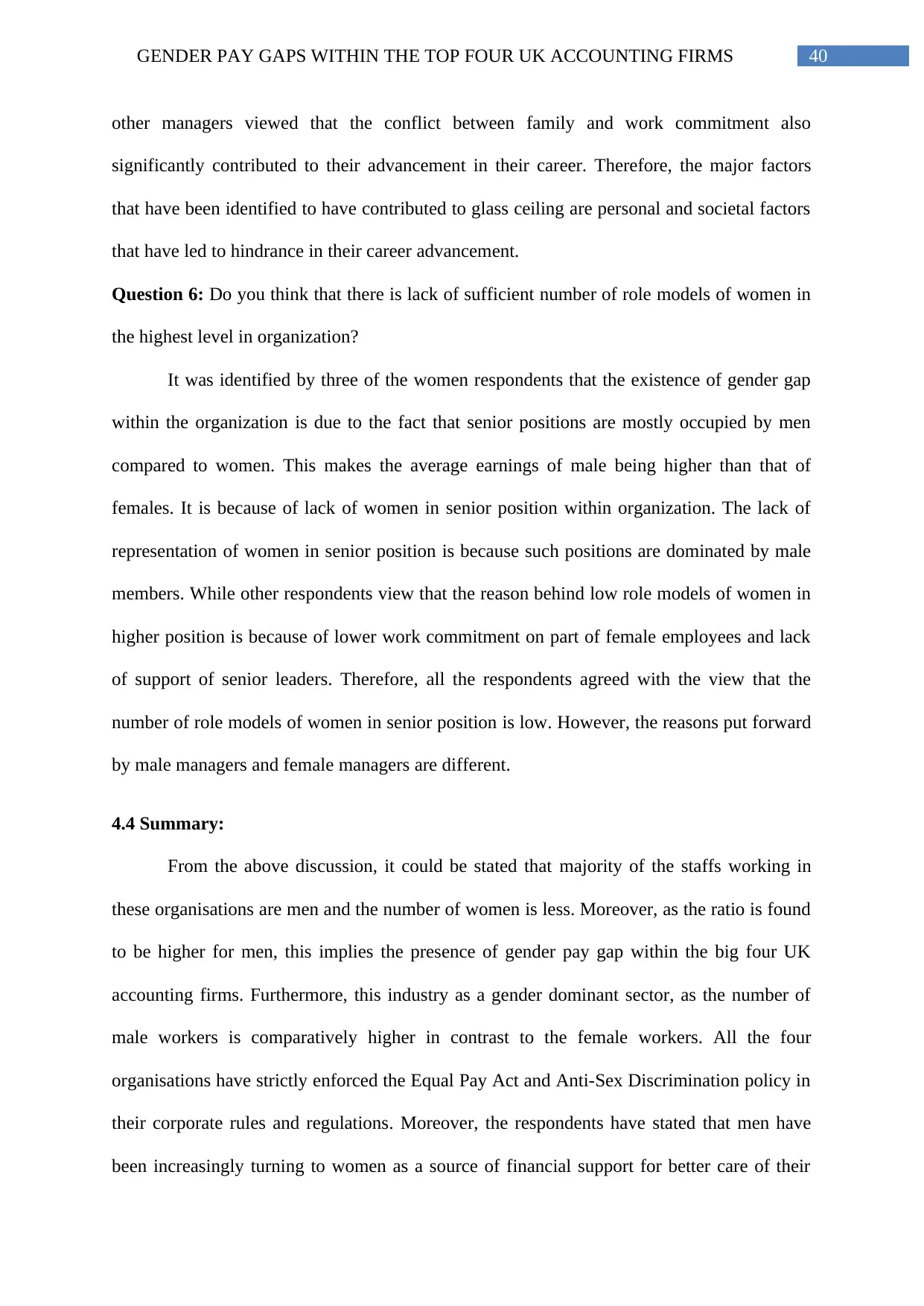
40GENDER PAY GAPS WITHIN THE TOP FOUR UK ACCOUNTING FIRMS
other managers viewed that the conflict between family and work commitment also
significantly contributed to their advancement in their career. Therefore, the major factors
that have been identified to have contributed to glass ceiling are personal and societal factors
that have led to hindrance in their career advancement.
Question 6: Do you think that there is lack of sufficient number of role models of women in
the highest level in organization?
It was identified by three of the women respondents that the existence of gender gap
within the organization is due to the fact that senior positions are mostly occupied by men
compared to women. This makes the average earnings of male being higher than that of
females. It is because of lack of women in senior position within organization. The lack of
representation of women in senior position is because such positions are dominated by male
members. While other respondents view that the reason behind low role models of women in
higher position is because of lower work commitment on part of female employees and lack
of support of senior leaders. Therefore, all the respondents agreed with the view that the
number of role models of women in senior position is low. However, the reasons put forward
by male managers and female managers are different.
4.4 Summary:
From the above discussion, it could be stated that majority of the staffs working in
these organisations are men and the number of women is less. Moreover, as the ratio is found
to be higher for men, this implies the presence of gender pay gap within the big four UK
accounting firms. Furthermore, this industry as a gender dominant sector, as the number of
male workers is comparatively higher in contrast to the female workers. All the four
organisations have strictly enforced the Equal Pay Act and Anti-Sex Discrimination policy in
their corporate rules and regulations. Moreover, the respondents have stated that men have
been increasingly turning to women as a source of financial support for better care of their
other managers viewed that the conflict between family and work commitment also
significantly contributed to their advancement in their career. Therefore, the major factors
that have been identified to have contributed to glass ceiling are personal and societal factors
that have led to hindrance in their career advancement.
Question 6: Do you think that there is lack of sufficient number of role models of women in
the highest level in organization?
It was identified by three of the women respondents that the existence of gender gap
within the organization is due to the fact that senior positions are mostly occupied by men
compared to women. This makes the average earnings of male being higher than that of
females. It is because of lack of women in senior position within organization. The lack of
representation of women in senior position is because such positions are dominated by male
members. While other respondents view that the reason behind low role models of women in
higher position is because of lower work commitment on part of female employees and lack
of support of senior leaders. Therefore, all the respondents agreed with the view that the
number of role models of women in senior position is low. However, the reasons put forward
by male managers and female managers are different.
4.4 Summary:
From the above discussion, it could be stated that majority of the staffs working in
these organisations are men and the number of women is less. Moreover, as the ratio is found
to be higher for men, this implies the presence of gender pay gap within the big four UK
accounting firms. Furthermore, this industry as a gender dominant sector, as the number of
male workers is comparatively higher in contrast to the female workers. All the four
organisations have strictly enforced the Equal Pay Act and Anti-Sex Discrimination policy in
their corporate rules and regulations. Moreover, the respondents have stated that men have
been increasingly turning to women as a source of financial support for better care of their

41GENDER PAY GAPS WITHIN THE TOP FOUR UK ACCOUNTING FIRMS
daily needs. Along with this, PwC, Deloitte, KPMG and Ernst & Young pay equal respect to
women by providing the same benefits and facilities that they provide to their male workers.
Despite the fact that women are treated equally as men in terms of payout and other
facilities, the organisations mainly recruit more male employees compared to women
employees. One of the primary reasons behind this is that accounting profession is chosen
mostly by men in comparison to men. Another reason that could be attributed to such
limitation is the motherhood of women, although the respondents did not believe such
incidents do not minimise the productivity of women in the workforce. Finally, it has been
identified that the existence of gender gap within the organization is due to the fact that senior
positions are mostly occupied by men compared to women. This makes the average earnings
of male being higher than that of females. It is because of lack of women in senior position
within organization. The lack of representation of women in senior position is because such
positions are dominated by male members. While other respondents view that the reason
behind low role models of women in higher position is because of lower work commitment
on part of female employees and lack of support of senior leaders.
daily needs. Along with this, PwC, Deloitte, KPMG and Ernst & Young pay equal respect to
women by providing the same benefits and facilities that they provide to their male workers.
Despite the fact that women are treated equally as men in terms of payout and other
facilities, the organisations mainly recruit more male employees compared to women
employees. One of the primary reasons behind this is that accounting profession is chosen
mostly by men in comparison to men. Another reason that could be attributed to such
limitation is the motherhood of women, although the respondents did not believe such
incidents do not minimise the productivity of women in the workforce. Finally, it has been
identified that the existence of gender gap within the organization is due to the fact that senior
positions are mostly occupied by men compared to women. This makes the average earnings
of male being higher than that of females. It is because of lack of women in senior position
within organization. The lack of representation of women in senior position is because such
positions are dominated by male members. While other respondents view that the reason
behind low role models of women in higher position is because of lower work commitment
on part of female employees and lack of support of senior leaders.
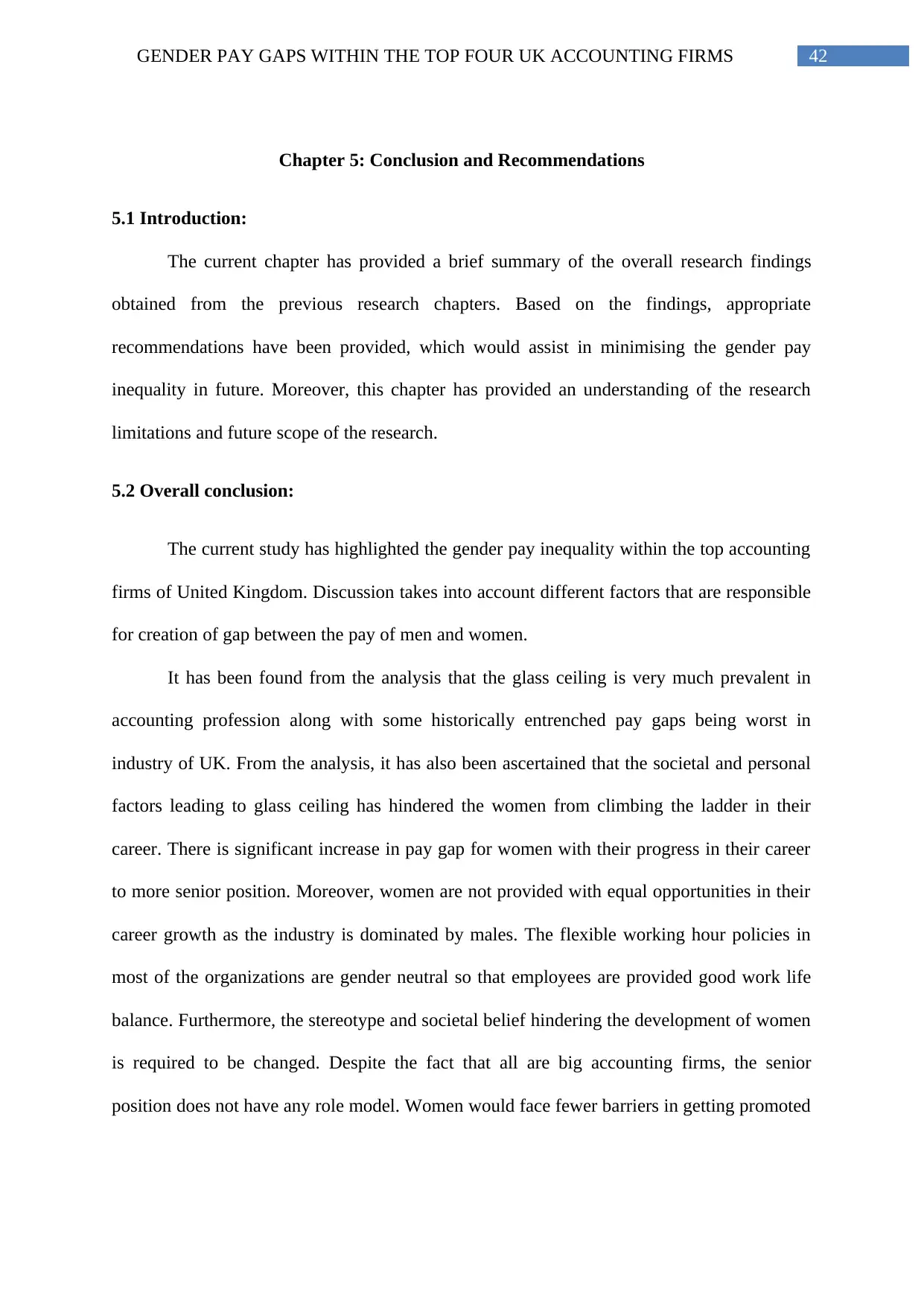
42GENDER PAY GAPS WITHIN THE TOP FOUR UK ACCOUNTING FIRMS
Chapter 5: Conclusion and Recommendations
5.1 Introduction:
The current chapter has provided a brief summary of the overall research findings
obtained from the previous research chapters. Based on the findings, appropriate
recommendations have been provided, which would assist in minimising the gender pay
inequality in future. Moreover, this chapter has provided an understanding of the research
limitations and future scope of the research.
5.2 Overall conclusion:
The current study has highlighted the gender pay inequality within the top accounting
firms of United Kingdom. Discussion takes into account different factors that are responsible
for creation of gap between the pay of men and women.
It has been found from the analysis that the glass ceiling is very much prevalent in
accounting profession along with some historically entrenched pay gaps being worst in
industry of UK. From the analysis, it has also been ascertained that the societal and personal
factors leading to glass ceiling has hindered the women from climbing the ladder in their
career. There is significant increase in pay gap for women with their progress in their career
to more senior position. Moreover, women are not provided with equal opportunities in their
career growth as the industry is dominated by males. The flexible working hour policies in
most of the organizations are gender neutral so that employees are provided good work life
balance. Furthermore, the stereotype and societal belief hindering the development of women
is required to be changed. Despite the fact that all are big accounting firms, the senior
position does not have any role model. Women would face fewer barriers in getting promoted
Chapter 5: Conclusion and Recommendations
5.1 Introduction:
The current chapter has provided a brief summary of the overall research findings
obtained from the previous research chapters. Based on the findings, appropriate
recommendations have been provided, which would assist in minimising the gender pay
inequality in future. Moreover, this chapter has provided an understanding of the research
limitations and future scope of the research.
5.2 Overall conclusion:
The current study has highlighted the gender pay inequality within the top accounting
firms of United Kingdom. Discussion takes into account different factors that are responsible
for creation of gap between the pay of men and women.
It has been found from the analysis that the glass ceiling is very much prevalent in
accounting profession along with some historically entrenched pay gaps being worst in
industry of UK. From the analysis, it has also been ascertained that the societal and personal
factors leading to glass ceiling has hindered the women from climbing the ladder in their
career. There is significant increase in pay gap for women with their progress in their career
to more senior position. Moreover, women are not provided with equal opportunities in their
career growth as the industry is dominated by males. The flexible working hour policies in
most of the organizations are gender neutral so that employees are provided good work life
balance. Furthermore, the stereotype and societal belief hindering the development of women
is required to be changed. Despite the fact that all are big accounting firms, the senior
position does not have any role model. Women would face fewer barriers in getting promoted
Paraphrase This Document
Need a fresh take? Get an instant paraphrase of this document with our AI Paraphraser
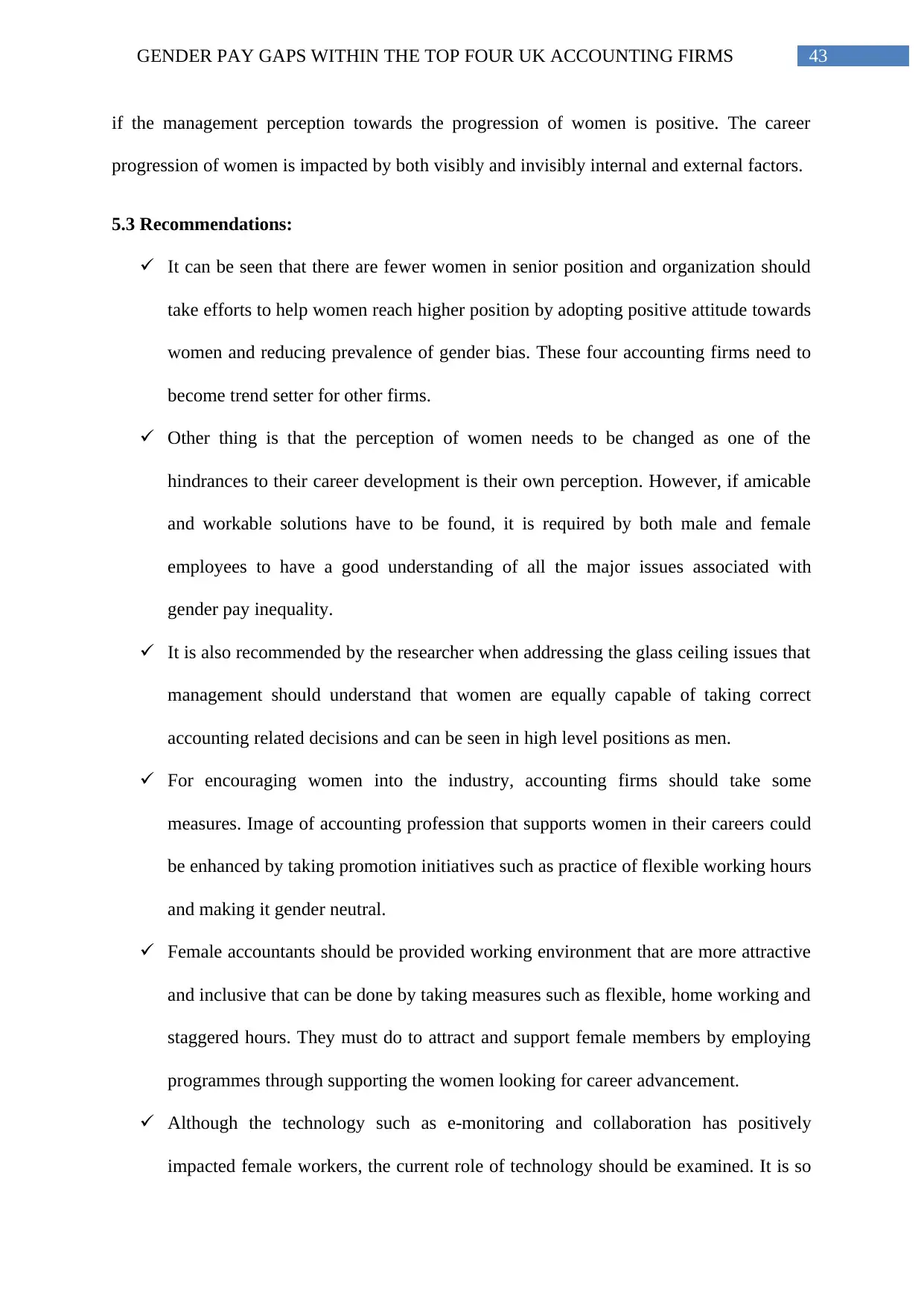
43GENDER PAY GAPS WITHIN THE TOP FOUR UK ACCOUNTING FIRMS
if the management perception towards the progression of women is positive. The career
progression of women is impacted by both visibly and invisibly internal and external factors.
5.3 Recommendations:
It can be seen that there are fewer women in senior position and organization should
take efforts to help women reach higher position by adopting positive attitude towards
women and reducing prevalence of gender bias. These four accounting firms need to
become trend setter for other firms.
Other thing is that the perception of women needs to be changed as one of the
hindrances to their career development is their own perception. However, if amicable
and workable solutions have to be found, it is required by both male and female
employees to have a good understanding of all the major issues associated with
gender pay inequality.
It is also recommended by the researcher when addressing the glass ceiling issues that
management should understand that women are equally capable of taking correct
accounting related decisions and can be seen in high level positions as men.
For encouraging women into the industry, accounting firms should take some
measures. Image of accounting profession that supports women in their careers could
be enhanced by taking promotion initiatives such as practice of flexible working hours
and making it gender neutral.
Female accountants should be provided working environment that are more attractive
and inclusive that can be done by taking measures such as flexible, home working and
staggered hours. They must do to attract and support female members by employing
programmes through supporting the women looking for career advancement.
Although the technology such as e-monitoring and collaboration has positively
impacted female workers, the current role of technology should be examined. It is so
if the management perception towards the progression of women is positive. The career
progression of women is impacted by both visibly and invisibly internal and external factors.
5.3 Recommendations:
It can be seen that there are fewer women in senior position and organization should
take efforts to help women reach higher position by adopting positive attitude towards
women and reducing prevalence of gender bias. These four accounting firms need to
become trend setter for other firms.
Other thing is that the perception of women needs to be changed as one of the
hindrances to their career development is their own perception. However, if amicable
and workable solutions have to be found, it is required by both male and female
employees to have a good understanding of all the major issues associated with
gender pay inequality.
It is also recommended by the researcher when addressing the glass ceiling issues that
management should understand that women are equally capable of taking correct
accounting related decisions and can be seen in high level positions as men.
For encouraging women into the industry, accounting firms should take some
measures. Image of accounting profession that supports women in their careers could
be enhanced by taking promotion initiatives such as practice of flexible working hours
and making it gender neutral.
Female accountants should be provided working environment that are more attractive
and inclusive that can be done by taking measures such as flexible, home working and
staggered hours. They must do to attract and support female members by employing
programmes through supporting the women looking for career advancement.
Although the technology such as e-monitoring and collaboration has positively
impacted female workers, the current role of technology should be examined. It is so
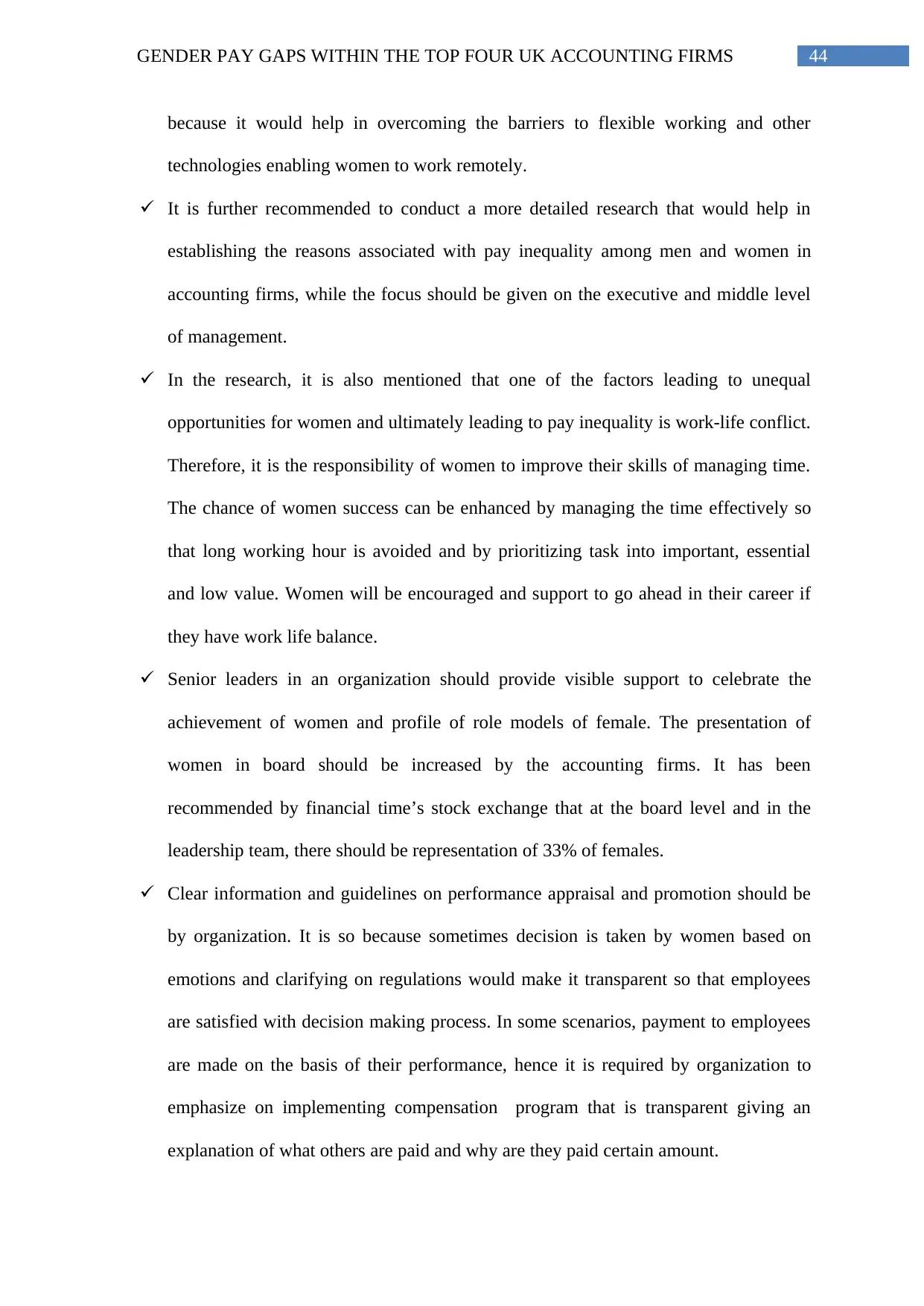
44GENDER PAY GAPS WITHIN THE TOP FOUR UK ACCOUNTING FIRMS
because it would help in overcoming the barriers to flexible working and other
technologies enabling women to work remotely.
It is further recommended to conduct a more detailed research that would help in
establishing the reasons associated with pay inequality among men and women in
accounting firms, while the focus should be given on the executive and middle level
of management.
In the research, it is also mentioned that one of the factors leading to unequal
opportunities for women and ultimately leading to pay inequality is work-life conflict.
Therefore, it is the responsibility of women to improve their skills of managing time.
The chance of women success can be enhanced by managing the time effectively so
that long working hour is avoided and by prioritizing task into important, essential
and low value. Women will be encouraged and support to go ahead in their career if
they have work life balance.
Senior leaders in an organization should provide visible support to celebrate the
achievement of women and profile of role models of female. The presentation of
women in board should be increased by the accounting firms. It has been
recommended by financial time’s stock exchange that at the board level and in the
leadership team, there should be representation of 33% of females.
Clear information and guidelines on performance appraisal and promotion should be
by organization. It is so because sometimes decision is taken by women based on
emotions and clarifying on regulations would make it transparent so that employees
are satisfied with decision making process. In some scenarios, payment to employees
are made on the basis of their performance, hence it is required by organization to
emphasize on implementing compensation program that is transparent giving an
explanation of what others are paid and why are they paid certain amount.
because it would help in overcoming the barriers to flexible working and other
technologies enabling women to work remotely.
It is further recommended to conduct a more detailed research that would help in
establishing the reasons associated with pay inequality among men and women in
accounting firms, while the focus should be given on the executive and middle level
of management.
In the research, it is also mentioned that one of the factors leading to unequal
opportunities for women and ultimately leading to pay inequality is work-life conflict.
Therefore, it is the responsibility of women to improve their skills of managing time.
The chance of women success can be enhanced by managing the time effectively so
that long working hour is avoided and by prioritizing task into important, essential
and low value. Women will be encouraged and support to go ahead in their career if
they have work life balance.
Senior leaders in an organization should provide visible support to celebrate the
achievement of women and profile of role models of female. The presentation of
women in board should be increased by the accounting firms. It has been
recommended by financial time’s stock exchange that at the board level and in the
leadership team, there should be representation of 33% of females.
Clear information and guidelines on performance appraisal and promotion should be
by organization. It is so because sometimes decision is taken by women based on
emotions and clarifying on regulations would make it transparent so that employees
are satisfied with decision making process. In some scenarios, payment to employees
are made on the basis of their performance, hence it is required by organization to
emphasize on implementing compensation program that is transparent giving an
explanation of what others are paid and why are they paid certain amount.

45GENDER PAY GAPS WITHIN THE TOP FOUR UK ACCOUNTING FIRMS
5.4 Limitations and future scope of research:
One of the limitations of this particular research paper is that findings cannot be
necessary generalized because the sample chosen was of particular comprising of big four
auditing firms of UK. Secondly, since the focus of survey conducted was women, it is
possible that the responses are influenced on the responses and this makes it difficult to
increase the credibility and viability of study. Moreover, the gender pay inequality cannot be
limited to only to the factors that have been discussed in the paper. The results generated
about the glass ceiling effect can be biased as some women might be more attached to
organizations than others and some women being more sensitive to the glass ceiling.
Furthermore, the corporate practices of organization have not been properly examined and
addressed because the existence of glass ceiling is considerably impacted by organizational
culture.
Another limitation confined to the quantitative part that did not prioritize the original
objective of study and funding body as data on pay was not obtained. It would have been
instructive to have measure of differences in pay among the profession. However, it can be
said that such type of research, some methodological limitations are inevitable. Therefore, the
findings generated might be affected great and might have potential bias.
5.4 Limitations and future scope of research:
One of the limitations of this particular research paper is that findings cannot be
necessary generalized because the sample chosen was of particular comprising of big four
auditing firms of UK. Secondly, since the focus of survey conducted was women, it is
possible that the responses are influenced on the responses and this makes it difficult to
increase the credibility and viability of study. Moreover, the gender pay inequality cannot be
limited to only to the factors that have been discussed in the paper. The results generated
about the glass ceiling effect can be biased as some women might be more attached to
organizations than others and some women being more sensitive to the glass ceiling.
Furthermore, the corporate practices of organization have not been properly examined and
addressed because the existence of glass ceiling is considerably impacted by organizational
culture.
Another limitation confined to the quantitative part that did not prioritize the original
objective of study and funding body as data on pay was not obtained. It would have been
instructive to have measure of differences in pay among the profession. However, it can be
said that such type of research, some methodological limitations are inevitable. Therefore, the
findings generated might be affected great and might have potential bias.
Secure Best Marks with AI Grader
Need help grading? Try our AI Grader for instant feedback on your assignments.
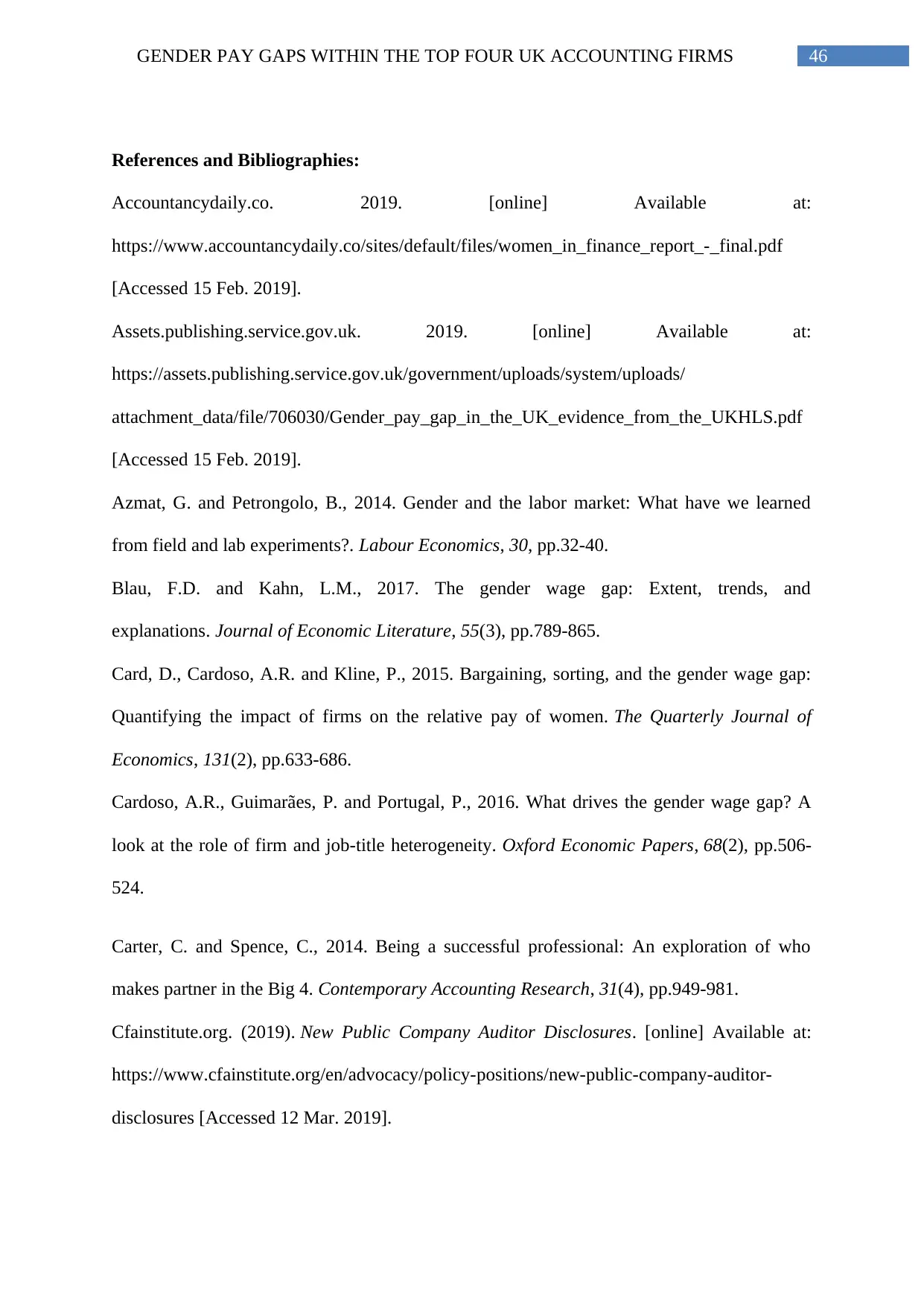
46GENDER PAY GAPS WITHIN THE TOP FOUR UK ACCOUNTING FIRMS
References and Bibliographies:
Accountancydaily.co. 2019. [online] Available at:
https://www.accountancydaily.co/sites/default/files/women_in_finance_report_-_final.pdf
[Accessed 15 Feb. 2019].
Assets.publishing.service.gov.uk. 2019. [online] Available at:
https://assets.publishing.service.gov.uk/government/uploads/system/uploads/
attachment_data/file/706030/Gender_pay_gap_in_the_UK_evidence_from_the_UKHLS.pdf
[Accessed 15 Feb. 2019].
Azmat, G. and Petrongolo, B., 2014. Gender and the labor market: What have we learned
from field and lab experiments?. Labour Economics, 30, pp.32-40.
Blau, F.D. and Kahn, L.M., 2017. The gender wage gap: Extent, trends, and
explanations. Journal of Economic Literature, 55(3), pp.789-865.
Card, D., Cardoso, A.R. and Kline, P., 2015. Bargaining, sorting, and the gender wage gap:
Quantifying the impact of firms on the relative pay of women. The Quarterly Journal of
Economics, 131(2), pp.633-686.
Cardoso, A.R., Guimarães, P. and Portugal, P., 2016. What drives the gender wage gap? A
look at the role of firm and job-title heterogeneity. Oxford Economic Papers, 68(2), pp.506-
524.
Carter, C. and Spence, C., 2014. Being a successful professional: An exploration of who
makes partner in the Big 4. Contemporary Accounting Research, 31(4), pp.949-981.
Cfainstitute.org. (2019). New Public Company Auditor Disclosures. [online] Available at:
https://www.cfainstitute.org/en/advocacy/policy-positions/new-public-company-auditor-
disclosures [Accessed 12 Mar. 2019].
References and Bibliographies:
Accountancydaily.co. 2019. [online] Available at:
https://www.accountancydaily.co/sites/default/files/women_in_finance_report_-_final.pdf
[Accessed 15 Feb. 2019].
Assets.publishing.service.gov.uk. 2019. [online] Available at:
https://assets.publishing.service.gov.uk/government/uploads/system/uploads/
attachment_data/file/706030/Gender_pay_gap_in_the_UK_evidence_from_the_UKHLS.pdf
[Accessed 15 Feb. 2019].
Azmat, G. and Petrongolo, B., 2014. Gender and the labor market: What have we learned
from field and lab experiments?. Labour Economics, 30, pp.32-40.
Blau, F.D. and Kahn, L.M., 2017. The gender wage gap: Extent, trends, and
explanations. Journal of Economic Literature, 55(3), pp.789-865.
Card, D., Cardoso, A.R. and Kline, P., 2015. Bargaining, sorting, and the gender wage gap:
Quantifying the impact of firms on the relative pay of women. The Quarterly Journal of
Economics, 131(2), pp.633-686.
Cardoso, A.R., Guimarães, P. and Portugal, P., 2016. What drives the gender wage gap? A
look at the role of firm and job-title heterogeneity. Oxford Economic Papers, 68(2), pp.506-
524.
Carter, C. and Spence, C., 2014. Being a successful professional: An exploration of who
makes partner in the Big 4. Contemporary Accounting Research, 31(4), pp.949-981.
Cfainstitute.org. (2019). New Public Company Auditor Disclosures. [online] Available at:
https://www.cfainstitute.org/en/advocacy/policy-positions/new-public-company-auditor-
disclosures [Accessed 12 Mar. 2019].
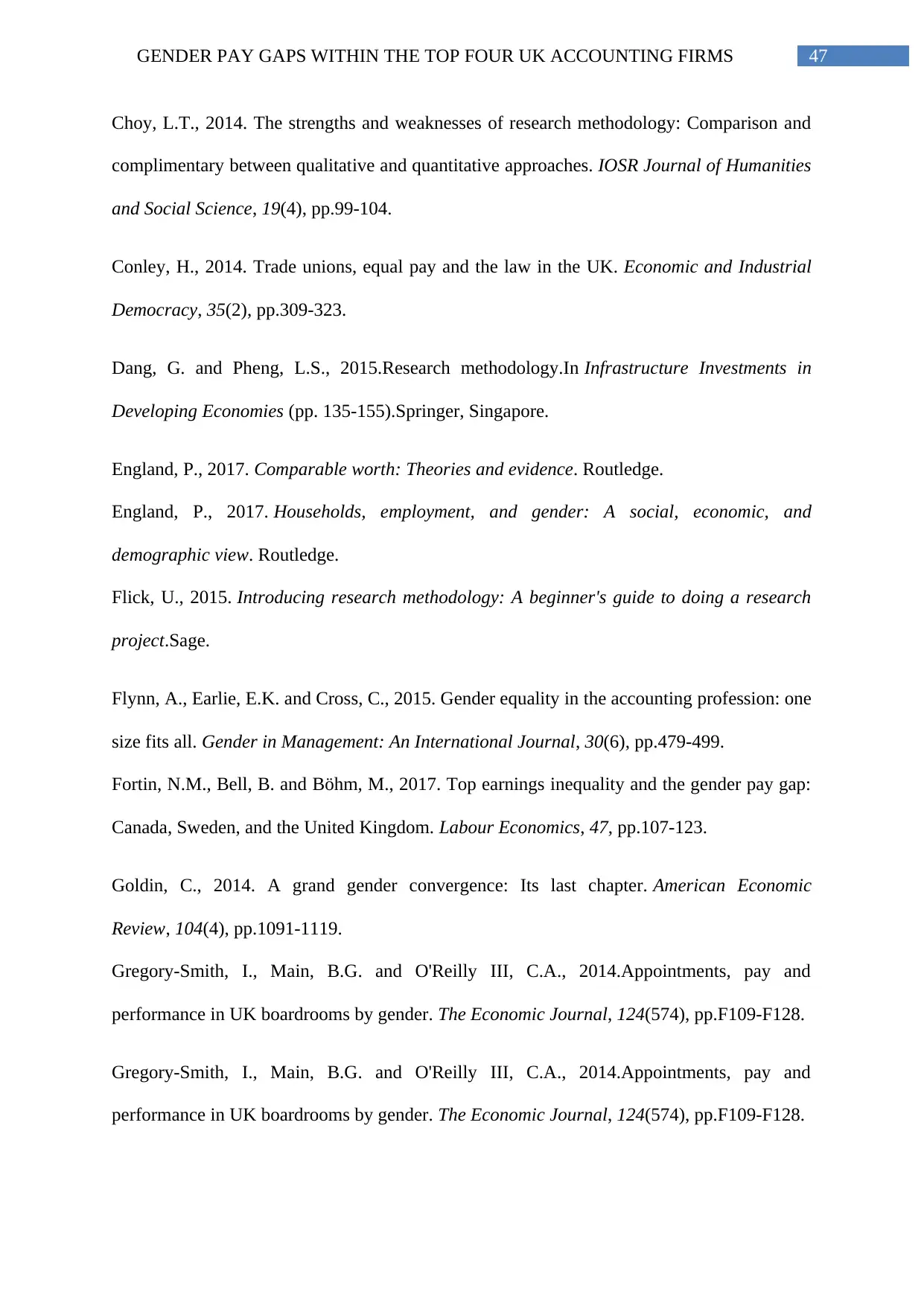
47GENDER PAY GAPS WITHIN THE TOP FOUR UK ACCOUNTING FIRMS
Choy, L.T., 2014. The strengths and weaknesses of research methodology: Comparison and
complimentary between qualitative and quantitative approaches. IOSR Journal of Humanities
and Social Science, 19(4), pp.99-104.
Conley, H., 2014. Trade unions, equal pay and the law in the UK. Economic and Industrial
Democracy, 35(2), pp.309-323.
Dang, G. and Pheng, L.S., 2015.Research methodology.In Infrastructure Investments in
Developing Economies (pp. 135-155).Springer, Singapore.
England, P., 2017. Comparable worth: Theories and evidence. Routledge.
England, P., 2017. Households, employment, and gender: A social, economic, and
demographic view. Routledge.
Flick, U., 2015. Introducing research methodology: A beginner's guide to doing a research
project.Sage.
Flynn, A., Earlie, E.K. and Cross, C., 2015. Gender equality in the accounting profession: one
size fits all. Gender in Management: An International Journal, 30(6), pp.479-499.
Fortin, N.M., Bell, B. and Böhm, M., 2017. Top earnings inequality and the gender pay gap:
Canada, Sweden, and the United Kingdom. Labour Economics, 47, pp.107-123.
Goldin, C., 2014. A grand gender convergence: Its last chapter. American Economic
Review, 104(4), pp.1091-1119.
Gregory‐Smith, I., Main, B.G. and O'Reilly III, C.A., 2014.Appointments, pay and
performance in UK boardrooms by gender. The Economic Journal, 124(574), pp.F109-F128.
Gregory‐Smith, I., Main, B.G. and O'Reilly III, C.A., 2014.Appointments, pay and
performance in UK boardrooms by gender. The Economic Journal, 124(574), pp.F109-F128.
Choy, L.T., 2014. The strengths and weaknesses of research methodology: Comparison and
complimentary between qualitative and quantitative approaches. IOSR Journal of Humanities
and Social Science, 19(4), pp.99-104.
Conley, H., 2014. Trade unions, equal pay and the law in the UK. Economic and Industrial
Democracy, 35(2), pp.309-323.
Dang, G. and Pheng, L.S., 2015.Research methodology.In Infrastructure Investments in
Developing Economies (pp. 135-155).Springer, Singapore.
England, P., 2017. Comparable worth: Theories and evidence. Routledge.
England, P., 2017. Households, employment, and gender: A social, economic, and
demographic view. Routledge.
Flick, U., 2015. Introducing research methodology: A beginner's guide to doing a research
project.Sage.
Flynn, A., Earlie, E.K. and Cross, C., 2015. Gender equality in the accounting profession: one
size fits all. Gender in Management: An International Journal, 30(6), pp.479-499.
Fortin, N.M., Bell, B. and Böhm, M., 2017. Top earnings inequality and the gender pay gap:
Canada, Sweden, and the United Kingdom. Labour Economics, 47, pp.107-123.
Goldin, C., 2014. A grand gender convergence: Its last chapter. American Economic
Review, 104(4), pp.1091-1119.
Gregory‐Smith, I., Main, B.G. and O'Reilly III, C.A., 2014.Appointments, pay and
performance in UK boardrooms by gender. The Economic Journal, 124(574), pp.F109-F128.
Gregory‐Smith, I., Main, B.G. and O'Reilly III, C.A., 2014.Appointments, pay and
performance in UK boardrooms by gender. The Economic Journal, 124(574), pp.F109-F128.
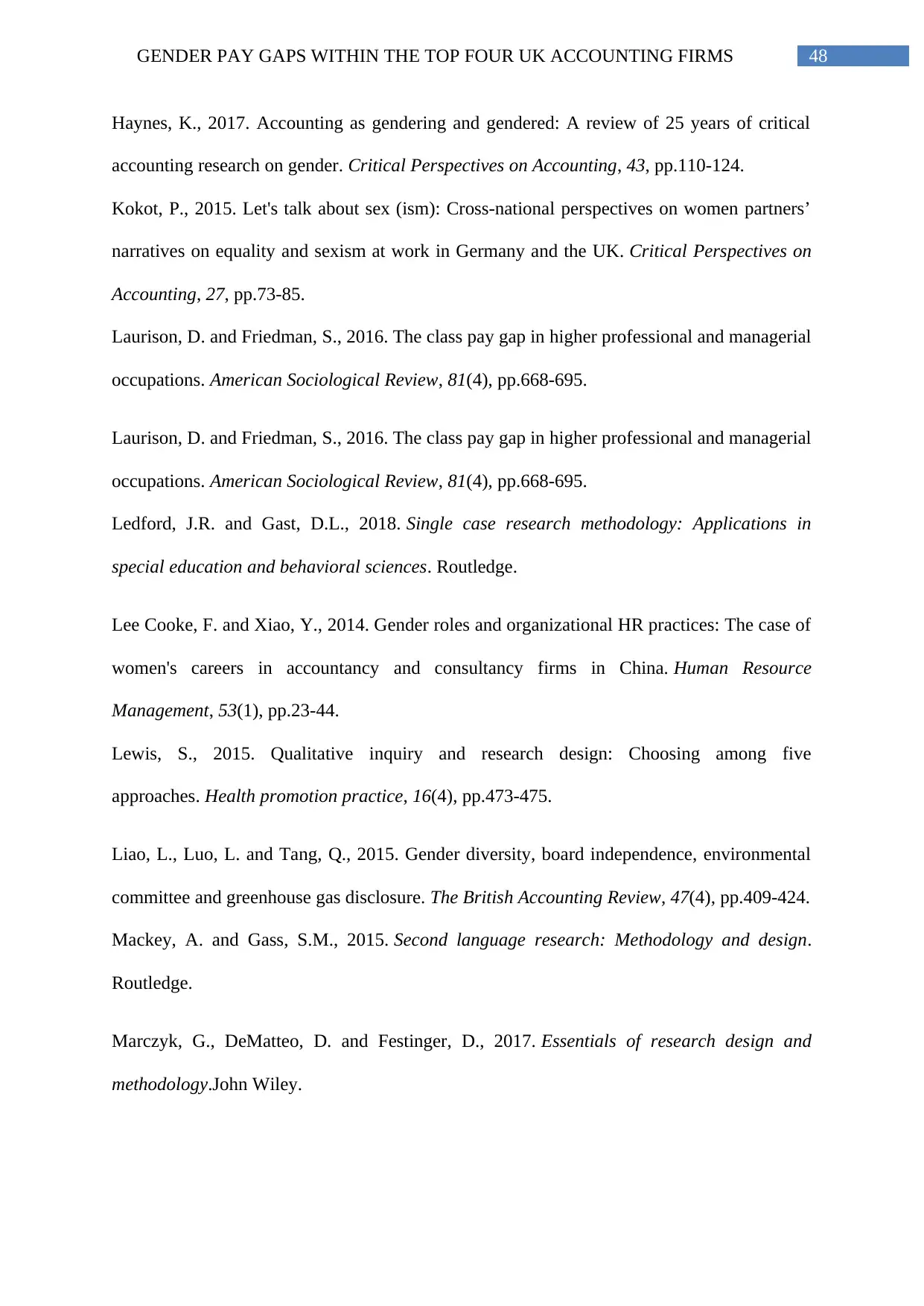
48GENDER PAY GAPS WITHIN THE TOP FOUR UK ACCOUNTING FIRMS
Haynes, K., 2017. Accounting as gendering and gendered: A review of 25 years of critical
accounting research on gender. Critical Perspectives on Accounting, 43, pp.110-124.
Kokot, P., 2015. Let's talk about sex (ism): Cross-national perspectives on women partners’
narratives on equality and sexism at work in Germany and the UK. Critical Perspectives on
Accounting, 27, pp.73-85.
Laurison, D. and Friedman, S., 2016. The class pay gap in higher professional and managerial
occupations. American Sociological Review, 81(4), pp.668-695.
Laurison, D. and Friedman, S., 2016. The class pay gap in higher professional and managerial
occupations. American Sociological Review, 81(4), pp.668-695.
Ledford, J.R. and Gast, D.L., 2018. Single case research methodology: Applications in
special education and behavioral sciences. Routledge.
Lee Cooke, F. and Xiao, Y., 2014. Gender roles and organizational HR practices: The case of
women's careers in accountancy and consultancy firms in China. Human Resource
Management, 53(1), pp.23-44.
Lewis, S., 2015. Qualitative inquiry and research design: Choosing among five
approaches. Health promotion practice, 16(4), pp.473-475.
Liao, L., Luo, L. and Tang, Q., 2015. Gender diversity, board independence, environmental
committee and greenhouse gas disclosure. The British Accounting Review, 47(4), pp.409-424.
Mackey, A. and Gass, S.M., 2015. Second language research: Methodology and design.
Routledge.
Marczyk, G., DeMatteo, D. and Festinger, D., 2017. Essentials of research design and
methodology.John Wiley.
Haynes, K., 2017. Accounting as gendering and gendered: A review of 25 years of critical
accounting research on gender. Critical Perspectives on Accounting, 43, pp.110-124.
Kokot, P., 2015. Let's talk about sex (ism): Cross-national perspectives on women partners’
narratives on equality and sexism at work in Germany and the UK. Critical Perspectives on
Accounting, 27, pp.73-85.
Laurison, D. and Friedman, S., 2016. The class pay gap in higher professional and managerial
occupations. American Sociological Review, 81(4), pp.668-695.
Laurison, D. and Friedman, S., 2016. The class pay gap in higher professional and managerial
occupations. American Sociological Review, 81(4), pp.668-695.
Ledford, J.R. and Gast, D.L., 2018. Single case research methodology: Applications in
special education and behavioral sciences. Routledge.
Lee Cooke, F. and Xiao, Y., 2014. Gender roles and organizational HR practices: The case of
women's careers in accountancy and consultancy firms in China. Human Resource
Management, 53(1), pp.23-44.
Lewis, S., 2015. Qualitative inquiry and research design: Choosing among five
approaches. Health promotion practice, 16(4), pp.473-475.
Liao, L., Luo, L. and Tang, Q., 2015. Gender diversity, board independence, environmental
committee and greenhouse gas disclosure. The British Accounting Review, 47(4), pp.409-424.
Mackey, A. and Gass, S.M., 2015. Second language research: Methodology and design.
Routledge.
Marczyk, G., DeMatteo, D. and Festinger, D., 2017. Essentials of research design and
methodology.John Wiley.
Paraphrase This Document
Need a fresh take? Get an instant paraphrase of this document with our AI Paraphraser

49GENDER PAY GAPS WITHIN THE TOP FOUR UK ACCOUNTING FIRMS
Milner, S. and Gregory, A., 2014. Gender equality bargaining in France and the UK: An
uphill struggle?. Journal of Industrial Relations, 56(2), pp.246-263.
O’Reilly, J., Smith, M., Deakin, S. and Burchell, B., 2015. Equal pay as a moving target:
International perspectives on forty-years of addressing the gender pay gap. Cambridge
Journal of Economics, 39(2), pp.299-317.
Panneerselvam, R., 2014. Research methodology. PHI Learning Pvt. Ltd.
Pessoa, J.P. and Van Reenen, J., 2014. The UK productivity and jobs puzzle: does the answer
lie in wage flexibility?. The Economic Journal, 124(576), pp.433-452.
Publications.parliament.uk. 2019. [online] Available at:
https://publications.parliament.uk/pa/cm201719/cmselect/cmbeis/928/928.pdf [Accessed 15
Feb. 2019].
Quinlan, C., Babin, B., Carr, J. and Griffin, M., 2019. Business research methods.South
Western Cengage.
Rubery, J., 2015. Change at work: feminisation, flexibilisation, fragmentation and
financialisation. Employee Relations, 37(6), pp.633-644.
Silverman, D. ed., 2016. Qualitative research.Sage.
Taylor, S.J., Bogdan, R. and DeVault, M., 2015. Introduction to qualitative research
methods: A guidebook and resource. John Wiley & Sons.
Vaioleti, T.M., 2016. Talanoa research methodology: A developing position on Pacific
research. Waikato Journal of Education, 12(1), pp.54-63.
Whiting, R.H., Gammie, E. and Herbohn, K., 2015.Women and the prospects for partnership
in professional accountancy firms. Accounting & Finance, 55(2), pp.575-605.
Milner, S. and Gregory, A., 2014. Gender equality bargaining in France and the UK: An
uphill struggle?. Journal of Industrial Relations, 56(2), pp.246-263.
O’Reilly, J., Smith, M., Deakin, S. and Burchell, B., 2015. Equal pay as a moving target:
International perspectives on forty-years of addressing the gender pay gap. Cambridge
Journal of Economics, 39(2), pp.299-317.
Panneerselvam, R., 2014. Research methodology. PHI Learning Pvt. Ltd.
Pessoa, J.P. and Van Reenen, J., 2014. The UK productivity and jobs puzzle: does the answer
lie in wage flexibility?. The Economic Journal, 124(576), pp.433-452.
Publications.parliament.uk. 2019. [online] Available at:
https://publications.parliament.uk/pa/cm201719/cmselect/cmbeis/928/928.pdf [Accessed 15
Feb. 2019].
Quinlan, C., Babin, B., Carr, J. and Griffin, M., 2019. Business research methods.South
Western Cengage.
Rubery, J., 2015. Change at work: feminisation, flexibilisation, fragmentation and
financialisation. Employee Relations, 37(6), pp.633-644.
Silverman, D. ed., 2016. Qualitative research.Sage.
Taylor, S.J., Bogdan, R. and DeVault, M., 2015. Introduction to qualitative research
methods: A guidebook and resource. John Wiley & Sons.
Vaioleti, T.M., 2016. Talanoa research methodology: A developing position on Pacific
research. Waikato Journal of Education, 12(1), pp.54-63.
Whiting, R.H., Gammie, E. and Herbohn, K., 2015.Women and the prospects for partnership
in professional accountancy firms. Accounting & Finance, 55(2), pp.575-605.
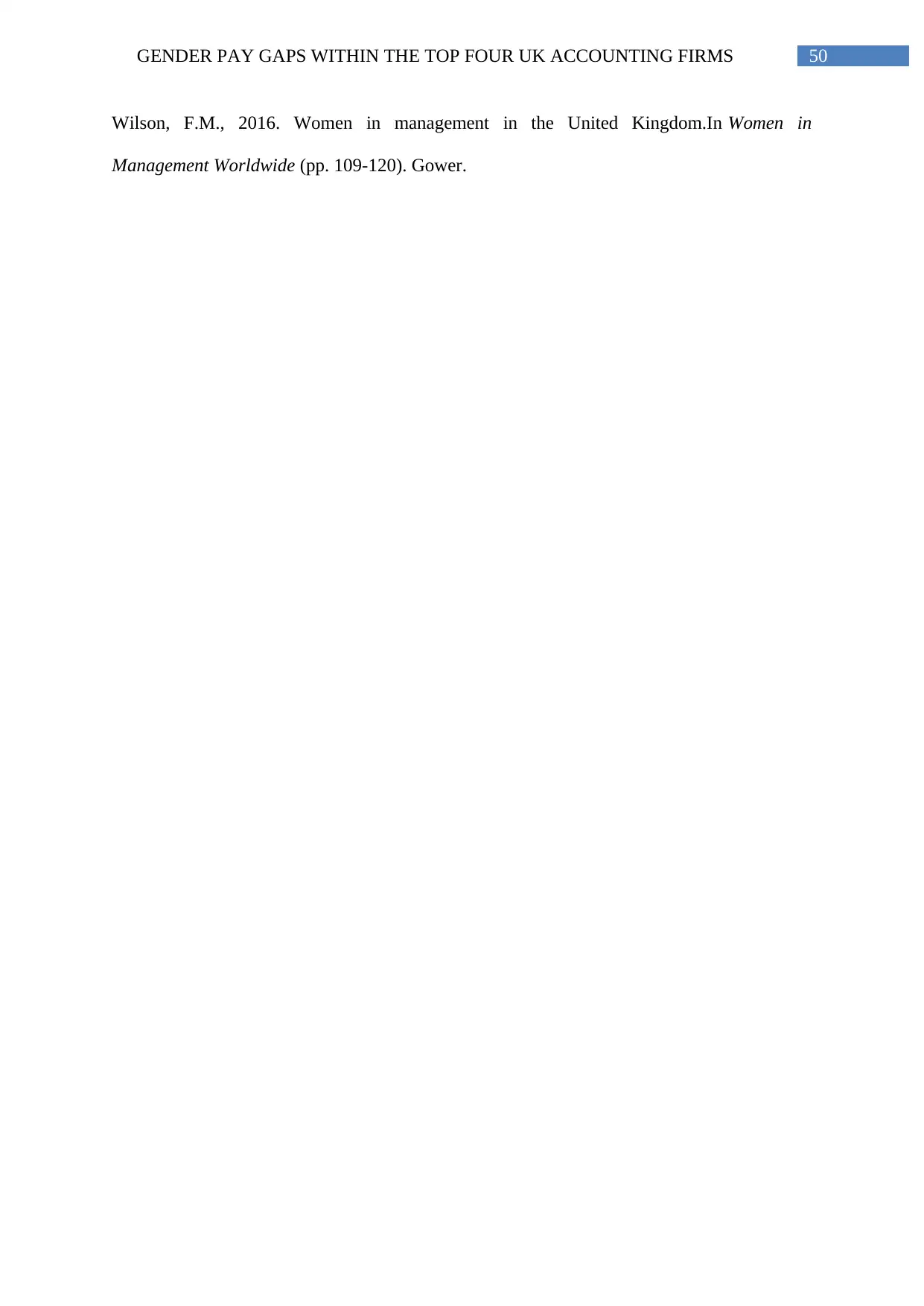
50GENDER PAY GAPS WITHIN THE TOP FOUR UK ACCOUNTING FIRMS
Wilson, F.M., 2016. Women in management in the United Kingdom.In Women in
Management Worldwide (pp. 109-120). Gower.
Wilson, F.M., 2016. Women in management in the United Kingdom.In Women in
Management Worldwide (pp. 109-120). Gower.
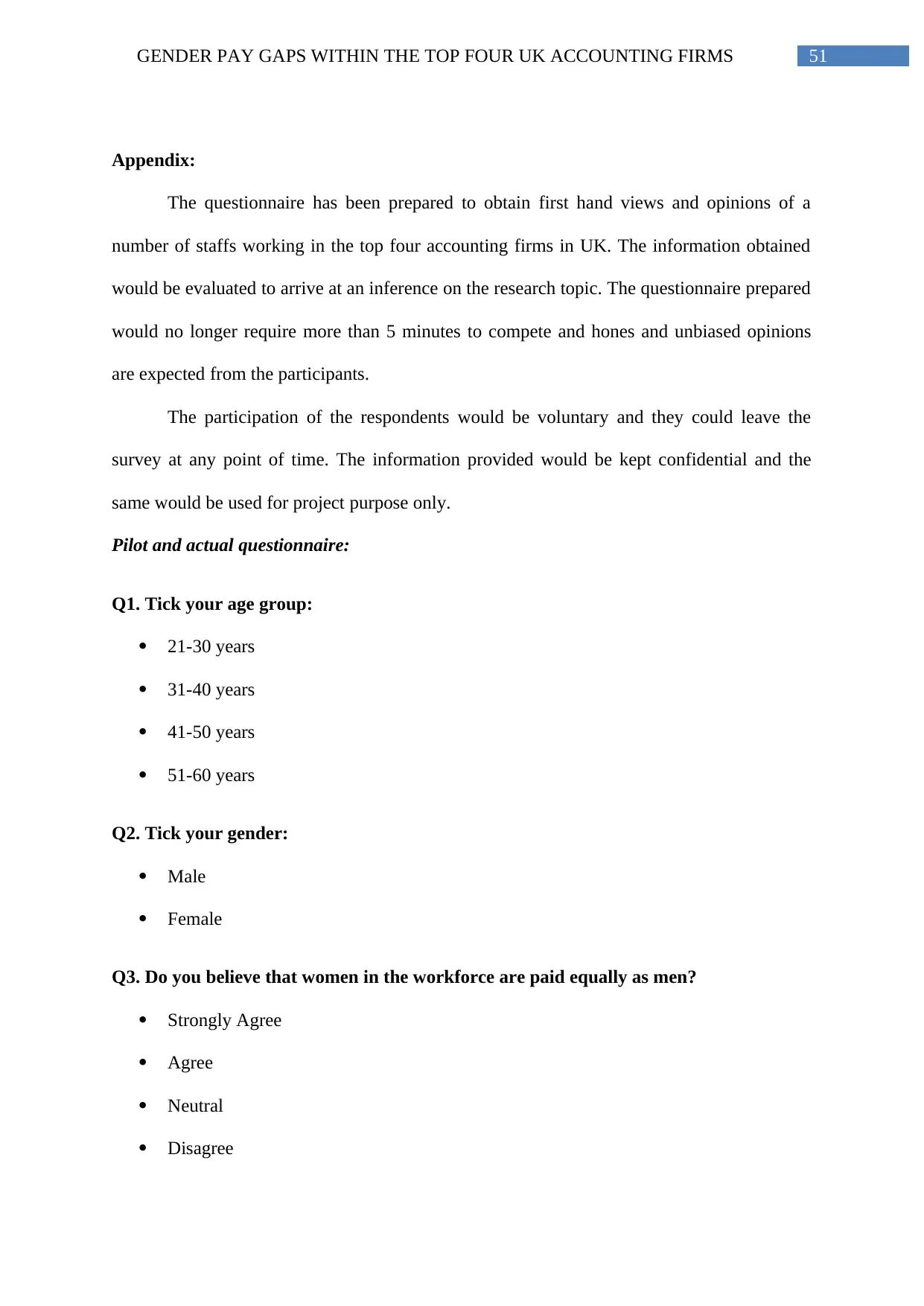
51GENDER PAY GAPS WITHIN THE TOP FOUR UK ACCOUNTING FIRMS
Appendix:
The questionnaire has been prepared to obtain first hand views and opinions of a
number of staffs working in the top four accounting firms in UK. The information obtained
would be evaluated to arrive at an inference on the research topic. The questionnaire prepared
would no longer require more than 5 minutes to compete and hones and unbiased opinions
are expected from the participants.
The participation of the respondents would be voluntary and they could leave the
survey at any point of time. The information provided would be kept confidential and the
same would be used for project purpose only.
Pilot and actual questionnaire:
Q1. Tick your age group:
21-30 years
31-40 years
41-50 years
51-60 years
Q2. Tick your gender:
Male
Female
Q3. Do you believe that women in the workforce are paid equally as men?
Strongly Agree
Agree
Neutral
Disagree
Appendix:
The questionnaire has been prepared to obtain first hand views and opinions of a
number of staffs working in the top four accounting firms in UK. The information obtained
would be evaluated to arrive at an inference on the research topic. The questionnaire prepared
would no longer require more than 5 minutes to compete and hones and unbiased opinions
are expected from the participants.
The participation of the respondents would be voluntary and they could leave the
survey at any point of time. The information provided would be kept confidential and the
same would be used for project purpose only.
Pilot and actual questionnaire:
Q1. Tick your age group:
21-30 years
31-40 years
41-50 years
51-60 years
Q2. Tick your gender:
Male
Female
Q3. Do you believe that women in the workforce are paid equally as men?
Strongly Agree
Agree
Neutral
Disagree
Secure Best Marks with AI Grader
Need help grading? Try our AI Grader for instant feedback on your assignments.
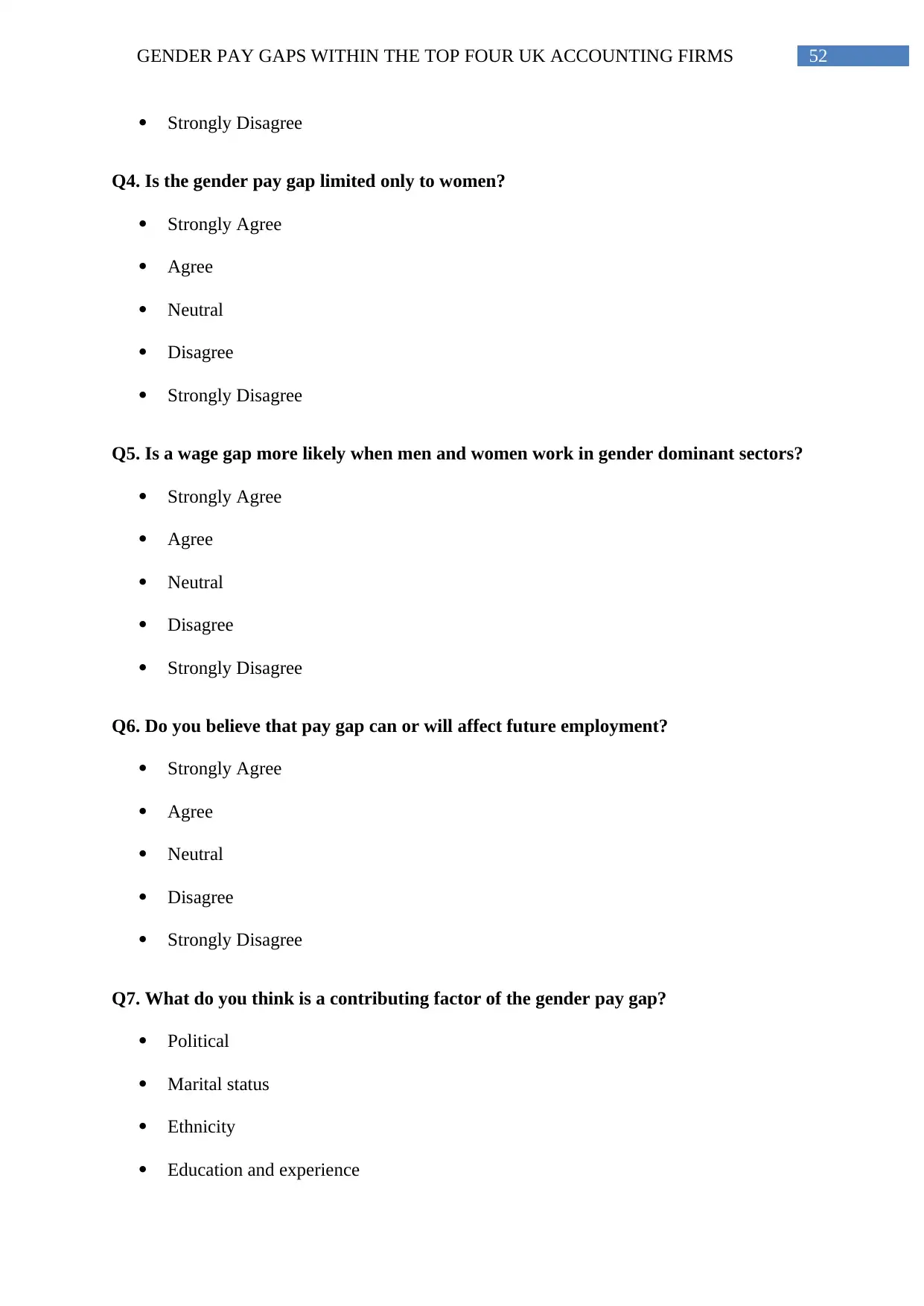
52GENDER PAY GAPS WITHIN THE TOP FOUR UK ACCOUNTING FIRMS
Strongly Disagree
Q4. Is the gender pay gap limited only to women?
Strongly Agree
Agree
Neutral
Disagree
Strongly Disagree
Q5. Is a wage gap more likely when men and women work in gender dominant sectors?
Strongly Agree
Agree
Neutral
Disagree
Strongly Disagree
Q6. Do you believe that pay gap can or will affect future employment?
Strongly Agree
Agree
Neutral
Disagree
Strongly Disagree
Q7. What do you think is a contributing factor of the gender pay gap?
Political
Marital status
Ethnicity
Education and experience
Strongly Disagree
Q4. Is the gender pay gap limited only to women?
Strongly Agree
Agree
Neutral
Disagree
Strongly Disagree
Q5. Is a wage gap more likely when men and women work in gender dominant sectors?
Strongly Agree
Agree
Neutral
Disagree
Strongly Disagree
Q6. Do you believe that pay gap can or will affect future employment?
Strongly Agree
Agree
Neutral
Disagree
Strongly Disagree
Q7. What do you think is a contributing factor of the gender pay gap?
Political
Marital status
Ethnicity
Education and experience
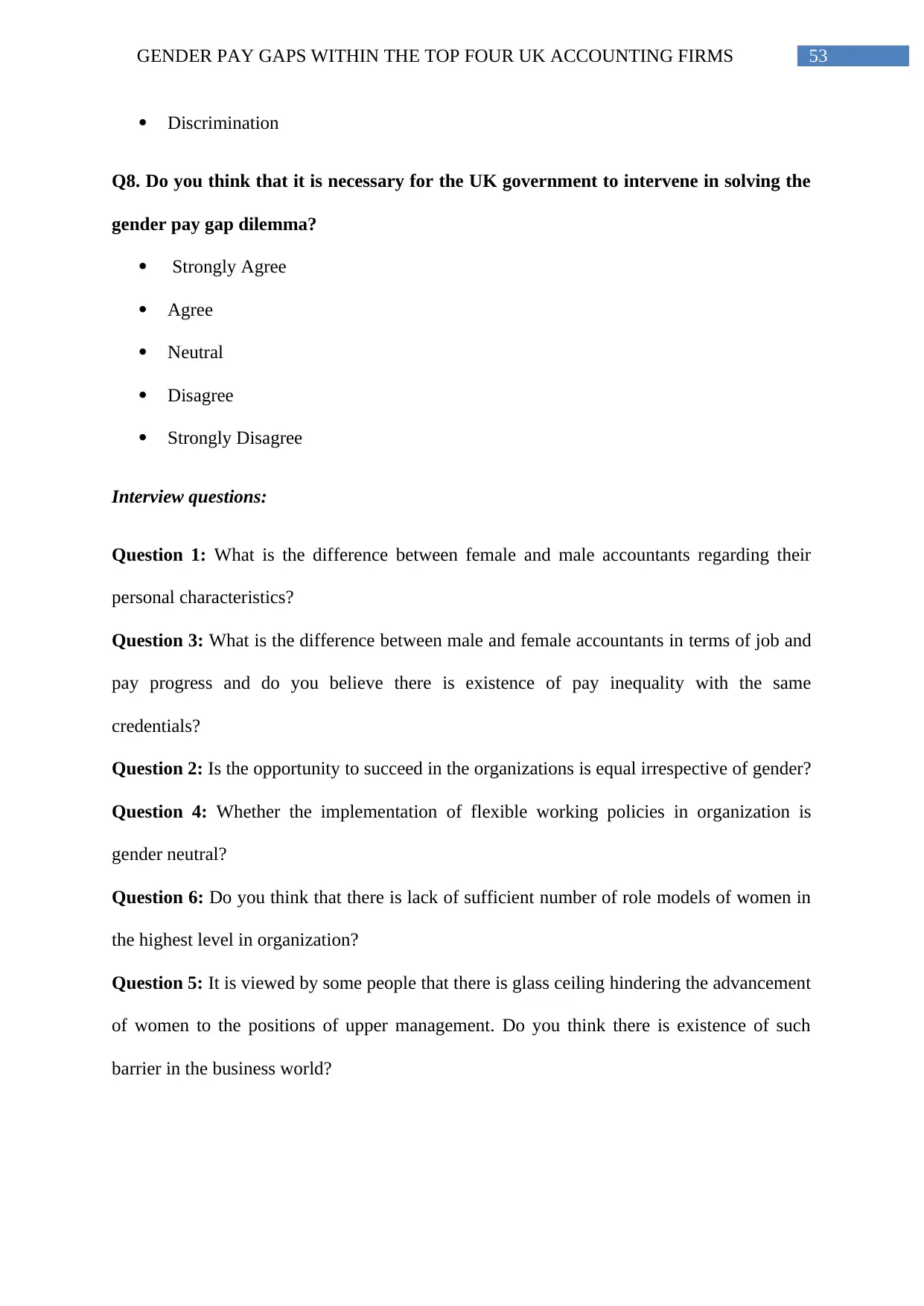
53GENDER PAY GAPS WITHIN THE TOP FOUR UK ACCOUNTING FIRMS
Discrimination
Q8. Do you think that it is necessary for the UK government to intervene in solving the
gender pay gap dilemma?
Strongly Agree
Agree
Neutral
Disagree
Strongly Disagree
Interview questions:
Question 1: What is the difference between female and male accountants regarding their
personal characteristics?
Question 3: What is the difference between male and female accountants in terms of job and
pay progress and do you believe there is existence of pay inequality with the same
credentials?
Question 2: Is the opportunity to succeed in the organizations is equal irrespective of gender?
Question 4: Whether the implementation of flexible working policies in organization is
gender neutral?
Question 6: Do you think that there is lack of sufficient number of role models of women in
the highest level in organization?
Question 5: It is viewed by some people that there is glass ceiling hindering the advancement
of women to the positions of upper management. Do you think there is existence of such
barrier in the business world?
Discrimination
Q8. Do you think that it is necessary for the UK government to intervene in solving the
gender pay gap dilemma?
Strongly Agree
Agree
Neutral
Disagree
Strongly Disagree
Interview questions:
Question 1: What is the difference between female and male accountants regarding their
personal characteristics?
Question 3: What is the difference between male and female accountants in terms of job and
pay progress and do you believe there is existence of pay inequality with the same
credentials?
Question 2: Is the opportunity to succeed in the organizations is equal irrespective of gender?
Question 4: Whether the implementation of flexible working policies in organization is
gender neutral?
Question 6: Do you think that there is lack of sufficient number of role models of women in
the highest level in organization?
Question 5: It is viewed by some people that there is glass ceiling hindering the advancement
of women to the positions of upper management. Do you think there is existence of such
barrier in the business world?
1 out of 54
Related Documents
Your All-in-One AI-Powered Toolkit for Academic Success.
+13062052269
info@desklib.com
Available 24*7 on WhatsApp / Email
![[object Object]](/_next/static/media/star-bottom.7253800d.svg)
Unlock your academic potential
© 2024 | Zucol Services PVT LTD | All rights reserved.





